DISCRETIONARY AWARDS













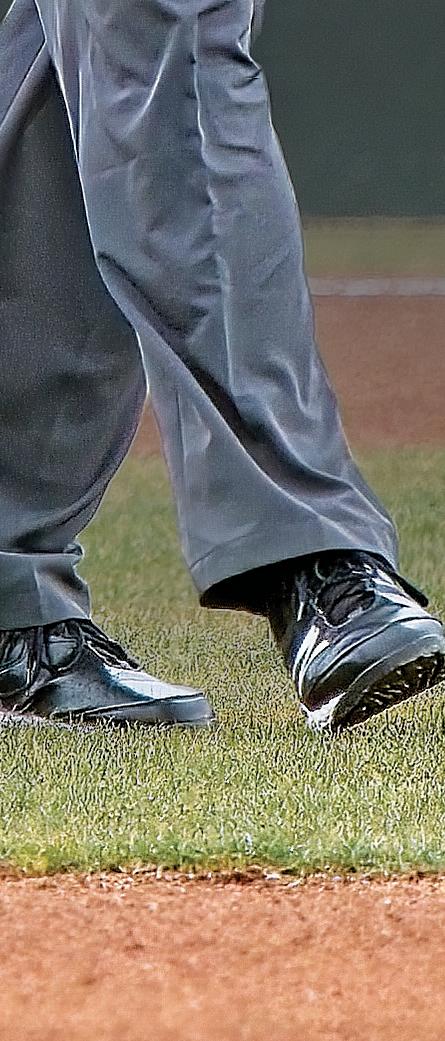

WHEN

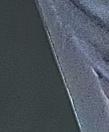

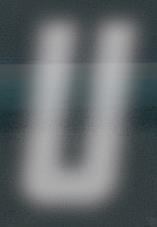

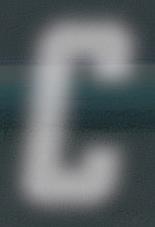






























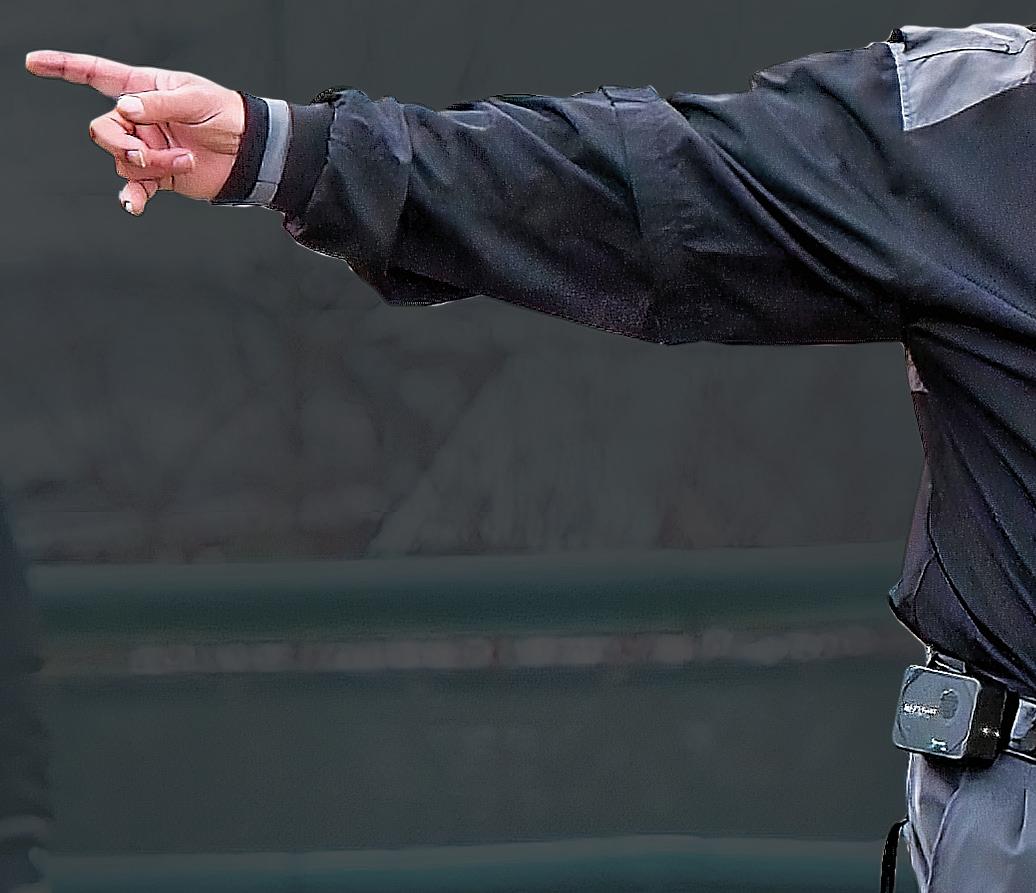
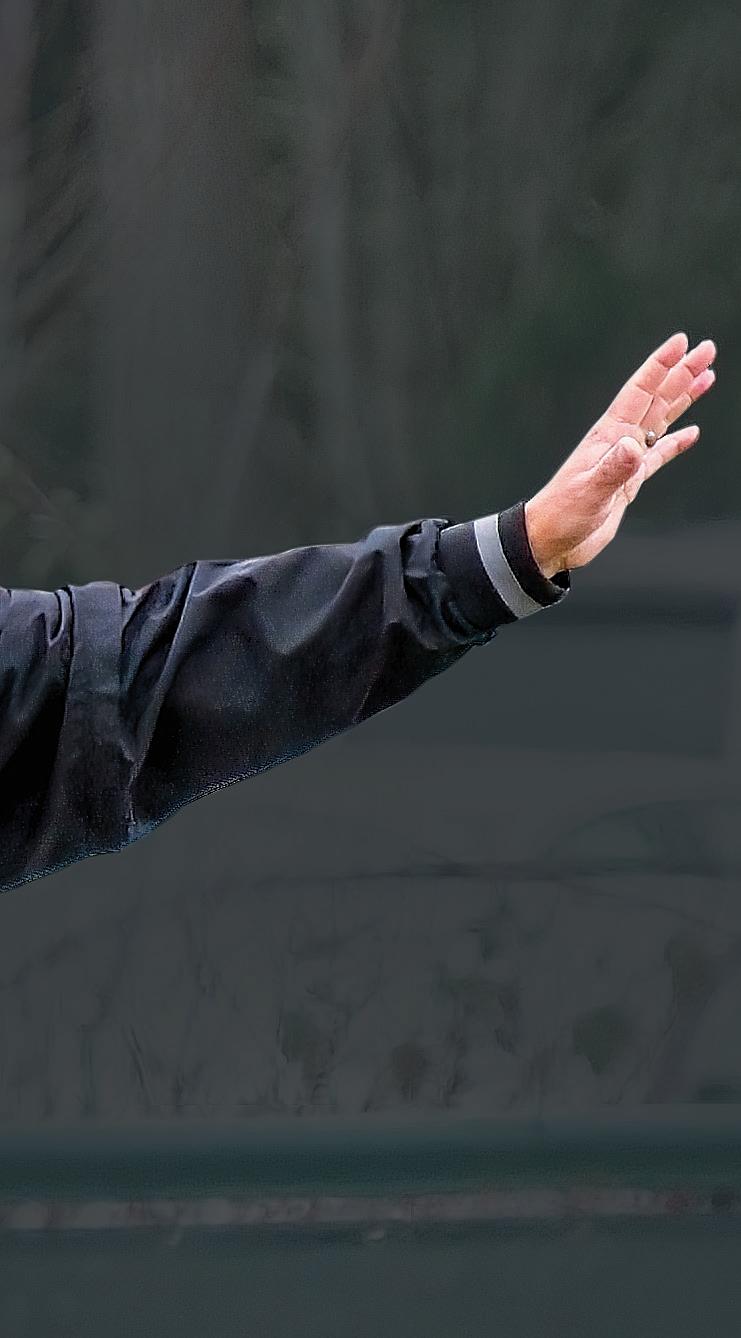



A CRISIS HITS P.26













COURT ORDER

AROUND THE BLOCK ALARMS SMART YOUR AGE THE MADNESS CHANGES your voice since 1976 $6.95
THANKS FOR THE MEMORIES P.38
P.50 P.76
JULY 2023 // REFEREE.COM
TAKE THAT BASE
P.56 BASE
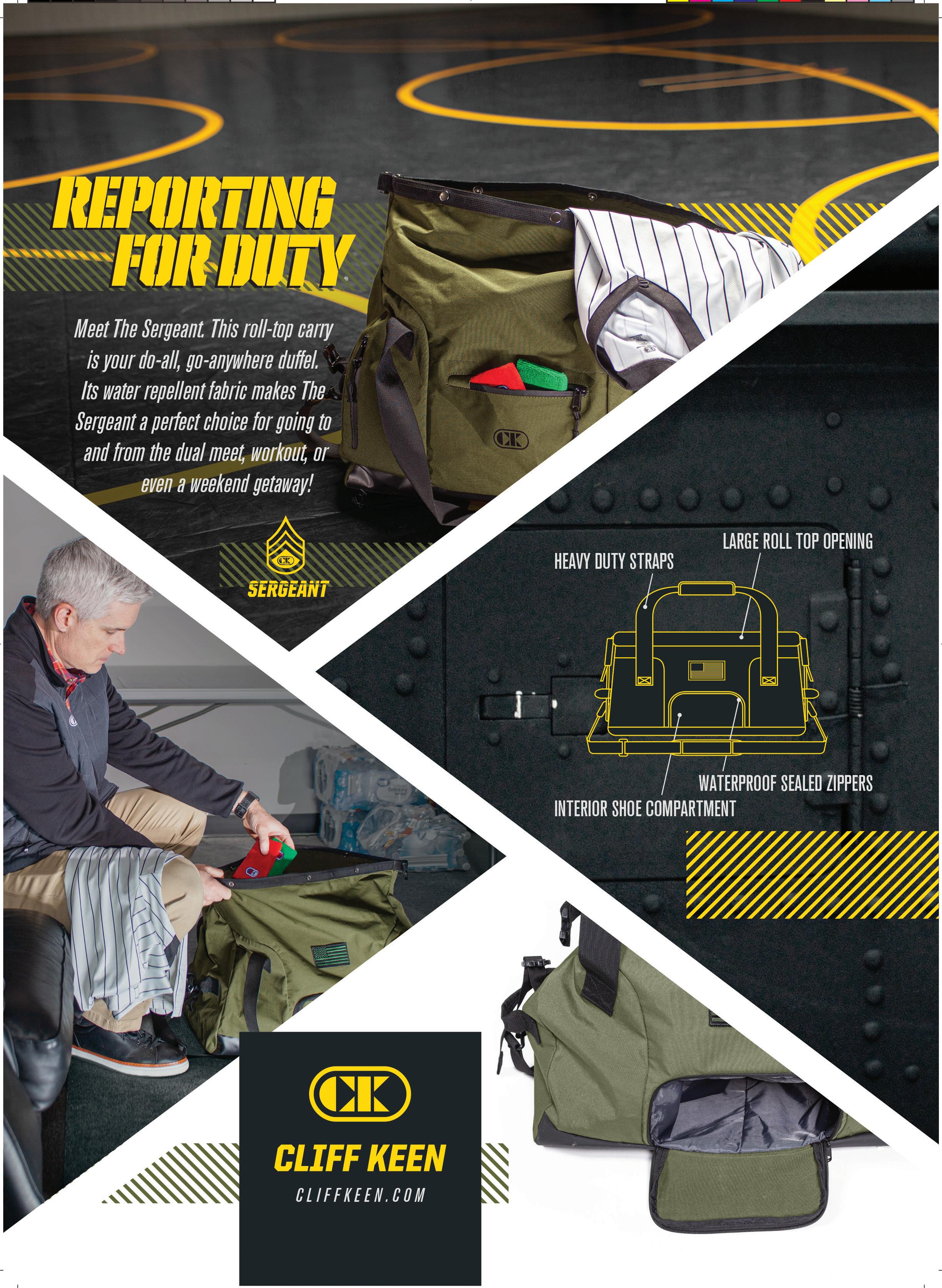
FEATURES
26 ORDER ON THE COURT
Julie Voeck is set for another challenge as NCAA secretary-rules editor for women’s volleyball.

38 CRISIS CALLS
‘No comment’ doesn’t always cut it anymore, but plan ahead for how to best weigh in.
56 7 WAYS TO GET BACK IN THE ZONE
Readjusting after the unexpected.
76 THANKS FOR THE MEMORIES
Do you feel like your mind fails you when trying to recall facts while officiating?
ON THE COVER
Age: 56
Occupation: CPA
Officiating experience: High school football official. High school, junior college, NCAA D-II and D-III baseball umpire. 2022 Washington 2A State Championship plate umpire.

SPORTS
16 FOOTBALL False Alarms: Illegal Starts by Team A Merit Attention; Get the Spot Through Cross-Field Mechanics; Beanbagging Done Right 32
COLUMNS
4 PUBLISHER’S MEMO Former President, Publisher Still
10 THE GAG RULE
Letters: Baseball Concussions; They Get It; Give Us a Break; Snap Shot; Say What?; Survey Says
12 THE NEWS NJ Little League Creates Rule to Combat Abuse; NFL Hires 12 New Officials; Labor Deal Reached for PRO2 Officials
54 GETTING IT RIGHT A Signature Moment; ‘Crowning Courage’; Truth and Reconciliation
4
Got You Covered: Be Prepared When Dealing With Tarps; Carried Away; Deviation Communication; See ’Em Touch ’Em All
68 BASKETBALL
Speak Softly and Apply the Correct Rule: A Deeper Dive Into Key NCAA Tournament Rulings; Stay Ahead of Electronics
78 ALL SPORTS Staying Fit Is It: Keeping in Shape Helps Combat the Aging Process; Overthrow the Dictator! Hail to the Facilitator!; Six Things You Absolutely, Positively Must Do Before Every Play
74 PROFILES
From Calling the Pitch to Throwing the First Pitch; A.J. Is A-OK; From AD to VIP
82 FOR THE RECORD
MLB umpire roster
84 LAW
Disciplined Response; Right Reports; Five Bylaws Basics

85 CLASSIFIEDS

Camps/Clinics/Schools; Equipment/Apparel; Leadership Resources
86 LAST CALL
Who’s Crying at Your Funeral? When we say yes to somebody, we’re also saying no to somebody else, and that somebody is usually our family.
FOOTBALL HIGHLIGHT THIS MONTH
FOR MORE, GO TO PAGE
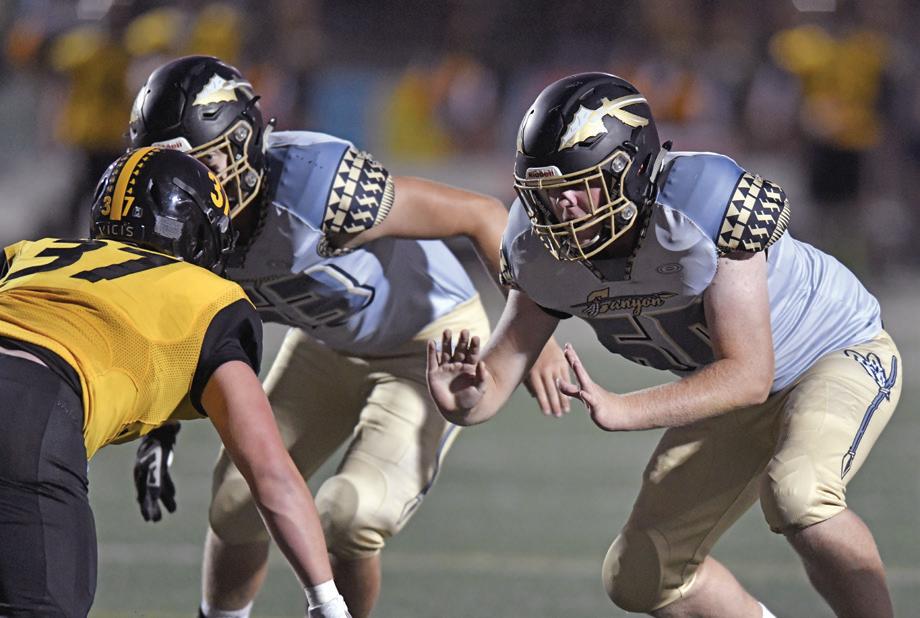
CONTENTS Find Referee Magazine on Facebook and follow RefereeMag on Twitter Volume 48, No. 7 Issue 561 JULY 2023
Net Reminders;
Book
SOCCER
VOLLEYBALL Clear as Mud: Determining Block, First Contact Not as Simple as Rules Knowledge;
Get in the
42
One Too Many: IFAB Rule Change Clarifies Extra Person on the Field; NFHS Announces 2023-24 Points of Emphasis
SOFTBALL
8 BASEBALL Discretion Decisions: Certain Base Awards Involve Your Judgment Only; Cash in on the Correct Clinic; 5MW: Paul Guillie 62
REFEREE (VOECK), DALE GARVEY (COVER), HESTON QUAN (FOOTBALL)
26
When the defense is showing blitz, or when the quarterback changes cadence, offensive linemen are apt to commit a false start.
16
Terry Granillo North Bend, Wash.
PUBLISHER’S MEMO
Former President, Publisher Still
First came Referee magazine in 1976. Then four years later came the National Association of Sports Officials (NASO). For more than four decades I have had the joy of expending my energy and my thoughts to both organizations. Today, the company that publishes this magazine, Referee Enterprises Inc. (REI), and NASO are joined at the head, shoulder, hip and knee. REI’s employees serve as the fulltime staff for NASO. Our entire team is not only the finest team of officiating-content producers on planet Earth, it is also an exemplary management, administrative and member-services staff for NASO. We have evolved into a seamless collaboration on behalf of sports officials.
It has been an immense privilege for me to serve as president of NASO since its inception in 1980. The founding idea I had was this: to provide benefits and services to the men, women and young people who officiate sports. In addition to doing that, NASO was nudged and exhorted onto a course that has led it to become the leading advocate on behalf of those who officiate sports.
Now, after having served in the president’s position these past four decades, I have chosen to formally step down from that role on July 1.Nothing or no one is forcing me or has been lobbying me to step down. It is not about health. It is not about loss of interest. It is not about agedness per se, but it is about energy and staying power. The demands being made upon the association have never been greater, never more important. Our staff has never been more energized nor filled with enthusiasm to support sports officials. A unique team we have here at REI/NASO.
In turn, stepping down from the presidency does not mean I will not still be fully supportive of the association and its ongoing advocacy. I will be! It is just that I will not serve as the public spokesperson for the association nor serve as its public persona. Those roles will be ably fulfilled by Bill Topp, who currently serves as the Chief Operating Officer of Referee Enterprises Inc. During its most recent meeting, the NASO board unanimously elected Bill to become NASO president, to take effect when I step down. Bill and I have worked hand-in-glove on all matters NASO for many years. There is no finer professional better suited to become the second president of NASO.
I intend to continue in my role as Chief Strategy Officer and Publisher at Referee Enterprises. That means I will be hands-on and working in the office as I have for almost 50 years. I will be a resource, able to be tapped by our staff and by NASO and its board of directors as they see fit. For the next couple years I will still be involved in the editorial process which conjures up featurestory ideas for the magazine and content concepts for some of our other publications and services. Heck, I might even get called upon to go back to where I started in 1976, doing photo shoots for some of our feature stories! I much look forward to that continuing involvement.
Chief Strategy Officer/Publisher
Barry Mano
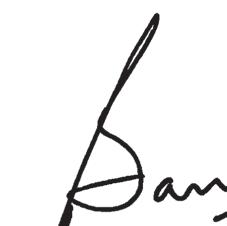
Chief Operating Officer/Executive Editor
Bill Topp
Chief Marketing Officer
Jim Arehart
Chief Business Development Officer
Ken Koester
Managing Editor
Brent Killackey
Assistant Managing Editor
Julie Sternberg
Senior Editor
Jeffrey Stern

Associate Editors
Brad Tittrington
Scott Tittrington
Assistant Editor
Joe Jarosz
Copy Editor
Jean Mano
Director of Design, Digital Media and Branding

Ross Bray
Publication Design Manager

Matt Bowen
Graphic Designer
Dustin Brown
Video Coordinator
Mike Dougherty
Comptroller
Marylou Clayton
Data Analyst/Fulfillment Manager
Judy Ball
Marketing Manager
Michelle Murray
Marketing Coordinator
Ben Wirth
Director of Administration and Sales Support
Cory Ludwin
Office Administrator

Garrett Randall
Client Services Support Specialists
Lisa Burchell
Sierra Miramontes
Trina Cotton
Editorial Contributors
Jon Bible, Mark Bradley, George Demetriou, Alan Goldberger, Judson Howard, Peter Jackel, Luke Modrovsky, Tim Sloan, Steven L. Tietz
These organizations offer ongoing assistance to Referee: Collegiate Commissioners Association, MLB, MLS, NBA, NCAA, NFHS, NISOA, NFL, NHL, Minor League Baseball Umpire Development and U.S. Soccer. Their input is appreciated.
Contributing Photographers
Ralph Echtinaw, Dale Garvey, Carin Goodall-Gosnell, Bill Greenblatt, Jann Hendry, Keith Johnston, Jack Kapenstein, Ken Kassens, Bob Messina, Bill Nichols, Ted Oppegard, Heston Quan, Dean Reid, VIP
Editorial Board
Mark Baltz, Jeff Cluff, Ben Glass, Reggie Greenwood, Tony Haire, John O’Neill, George Toliver, Ellen Townsend Advertising
referee.com/pubmemo 4 | REFEREE July 2023
Watch the video at
2017 Lathrop Ave., Racine, WI 53405 Phone: 262-632-8855 advertising@referee.com REFEREE (ISSN 0733+1436) is published monthly, $49.95 per year in U.S., $84.95 in Canada, Mexico and foreign countries, by Referee Enterprises, Inc., 2017 Lathrop Ave., Racine, WI 53405. Periodical postage paid at Racine, WI and at additional mailing offices. Postmaster: Send address changes and undeliverables to REFEREE, PO Box 319 Congers, NY 10920. Direct subscription inquiries, other mail to REFEREE, PO Box 319 Congers, NY 10920. 1-800-733-6100. © 2023 Referee Enterprises, Inc. All rights reserved. (USPS Publication #107790.) Subscribers: Send address changes to REFEREE, PO Box 319 Congers, NY 10920.
FEATURING THE LATEST FOOTBALL PRODUCTS MADE BY SPORTS OFFICIALS
GOOD CALL OFFICIATING SPEAK EASY HEADSET

GOOD CALL OFFICIATING NFHS GAMEBOOK

Mark B. Skiatook, Oklahoma
“Great equipment addition for our crew. Very clear even over crowd noise. The push button is always there. You’re not fumbling around for a small mic with a small button.”
OFFICIAL REVIEWS
UMPLIFE PROFESSIONAL GARMENT BAG

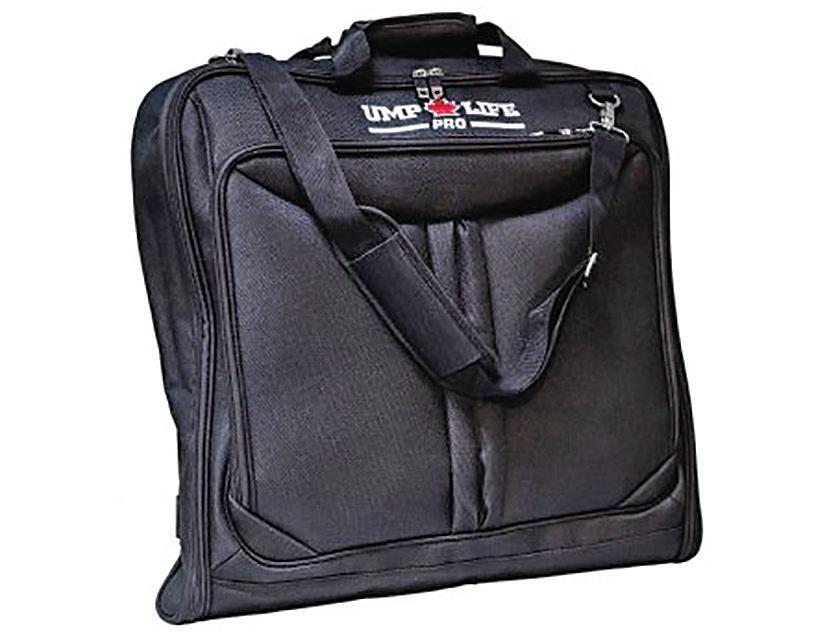

Tim T. Batesville, Arkansas
“I love this book! It has everything in it you’ll need on the football field. There’s no point in carrying anything else. It’s slick, perfect size for your shirt pocket.”
OFFICIAL REVIEWS
WILLIAMS ULTIMATE FOOTBALL REFEREE INFORMATION CARDS

Nick D. Windsor, Connecticut
“WOW! #GameChanger. The quality of this bag is beyond reproach. Ray has designed this bag with o cials in mind.”
OFFICIAL REVIEWS
Donald P. Virginia Beach, Virginia
“Finally, a game card that has everything an o cial needs to record the game. Thanks.”
OFFICIAL REVIEWS




Preferred vendor
Little Makes Big Impact First Woman to Officiate Boys Hoops Final Since 1995
Delonda Little was already a trailblazer to many before this year’s MHSAA Boys Basketball Finals.
But what happened last month at Breslin Center made her even more of one on a statewide level.
A referee and assigner for 20 years in the Detroit area, Little is a female boys and girls basketball official who mentors both male and female referees – no matter the gender or level, as she officiates high school and college games.
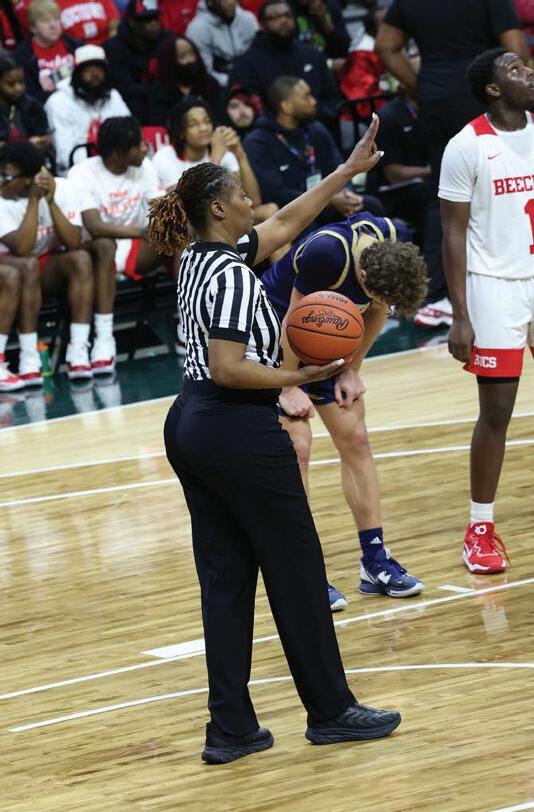

Officials often go to Little for guidance, direction and assignments, which has made her respected for years throughout Metro Detroit in the prep basketball community. Then, her status as a trailblazer grew even more.
Little was assigned as an official for the Division 3 Boys Basketball Final between Flint Beecher and Traverse City St. Francis, and she became the first female referee to officiate an MHSAA Boys Basketball Final since Traverse City’s Barb Beckett 1995.

“It was a very good feeling to know I was the one selected,” said Little, who officiated the Final with Matt Olson and Zach Porritt.
In fact, while attending a Semifinal game the Friday before the Final, Little received a phone call from an area code she didn’t recognize.
She answered, and it was Beckett.
“At first I didn’t know the name,” Little said. “I said, ‘No, I don’t know you, but that’s fine.’”
Beckett then explained she was the first female referee to be assigned a Boys Basketball Final, and just wanted to offer support to Little.
At that point, Little became excited and thankful she answered the call.
“It was very nice to hear from her because she wanted to reach out and if not pass the torch, to congratulate me,” Little said.
Little, 51, said she found out she was going to be refereeing the Division 3 boys championship game just before the start of the postseason when she received an email from the MHSAA.
“I’m looking at the email and I’m like, boys?” Little said. “I was shocked.”
But she was shocked in a good way, and obviously excited for the honor.
Little didn’t find out until a couple of days before the St. Francis/Beecher contest that she would be officiating that specific championship game, but the Monday of boys championship week was when she really started to receive congratulations from friends and colleagues.
That’s when an article came out in the Detroit News detailing her selection, which led to countless calls, texts and congratulatory messages on social media.
“I couldn’t even (keep up with the comments),” she said. “That’s how overwhelming the actual tags were. It came from all across the state with officials, men and women, because I do women’s college (games). Some of the college ladies were reaching out. I was getting all the hoopla before the game.”
6 | REFEREE / MHSAA July 2023
Delonda Little hustles downcourt during the Division 3 Boys Basketball Final on March 25 at Breslin Center.
MEMBER BENEFITs & services
Any Game, Any Time, Anywhere — You Are Covered
Insurance
(Sports Officials Security Program)
$6 million General Liability Coverage

Excess coverage for claims for bodily injury, property damage and personal and advertising injury (defined as slander or libel) up to $6 million per occurrence general liability limit with a personal aggregate of $14 million.
Assault-Related $15,500 Coverage
Provides coverage for certain legal fees and medical expenses and game fee losses resulting from injuries suffered when an official is the victim of an assault and/or battery by a spectator, fan or participant while officiating.
$100,000 Game Call and Assigners’ Coverage
Up to $100,000 coverage for claims involving a challenged game call which resulted in a claimed financial loss or a suit against an assigner by a disgruntled official.
Referee Digital Magazine
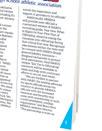

Allows you access to a digital customized MHSAA-version of Referee magazine to read wherever you’re on the go. MHSAA NASO members will receive exclusive MHSAA content through the digital magazine. Referee is the number one source of information for sports officials, written by officials. Each issue includes news columns and journalof-record reports and deep-coverage sport-specific sections complete with rule interpretations and caseplays.



Referee Magazine (NASO Print Edition)
MHSAA members have the option to upgrade to the print version of the magazine, delivered to your mailbox every month. 84 pages of in-depth feature stories as only Referee can report them.

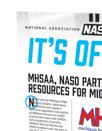
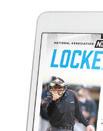

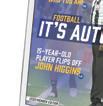
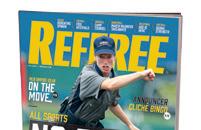
It’s Official Newsletter









Monthly 16-page newsletter providing association news, information, caseplays and educational product discounts.


Marriott VIP Card
Provides discounted rates at Marriott & Starwoodbranded hotels within the US and Canada, subject to availability.













With the VIP card, NASO members may receive a room rate of up to 25 percent off the regular price at participating hotels where space is available. The Athletic VIP card must be shown at check-in.
Registration Discount to The Sports Officiating Summit Members only registration discounts.
Ump-Attire.com
10% discounts
Member Information & Consultation Program (MICP)
LockerRoom
NASO LockerRoom
Online newsletter includes latest news on NASO, officiating techniques and philosophy.




Interactive Sport Quizzes
Online access to sport quizzes that will help you improve your knowledge of the rules.
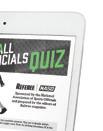
Officiating Resources
Special Members-only buying discounts on Referee and NASO publications. Savings up to 20%.
Provides help when you need to sort out an officiating related issue, includes both free information and free consultation with a knowledgeable person.
Address:
Phone:



Web:


Email:
















2017 Lathrop Ave Racine, WI 53405
262-632-5448
naso.org
naso@naso.org
Publications Discounts & Savings Information Services Contact NASO wherever you’re on the go.
NASO covers common gaps in other officiating insurances, protecting you when other officiating coverages come up short.
NATIONAL ASSOCIATION OF SPORTS OFFICIALS
Little said she normally doesn’t get nervous for games, but not having some nerves became a bit harder once so many people knew of her achievement.
However, she settled into a normal routine quickly once the game started.
“I wanted to get it done, get it over with and do well,” she said.
Little did do well, which is no surprise to everyone who knew her before she officiated on the boys championship stage.
It was just another feather in the cap for Little, who in 2016 became the first woman to officiate a boys Detroit Public School League championship game.
“Delonda is one of the top officials in the Detroit area, and our staff doesn’t look at Delonda as a female working a boys game –we see one of the top officials in Detroit working a basketball game,” MHSAA Executive Director Mark Uyl said. “There are females officiating in the NBA and female officials in the NCAA Men’s Basketball Tournament. The aspect that made Delonda’s selection for this MHSAA championship game nearly unique will soon be the norm at all levels of athletics.”
Little graduated from Detroit Osborn in 1989 and starred on the basketball court at Wayne State,
quicktip
Liability can sometimes be measured by three simple equations: Bad officiating encourages anti-social behavior. Anti-social behavior equals injuries. Injuries equal lawsuits. Officials who are alert to sense ill-will brewing let the opponents see the striped shirt when something starts to happen. That includes, of course, not having everybody’s back turned on the players ever — no matter what else is going on in the game.
earning induction into WSU’s Athletic Hall of Fame in 2005.
Her day job is as an officer for the Michigan Department of Corrections, but her passion is officiating. She’s been an MHSAAregistered official for basketball for two decades and also was registered for volleyball for four years. This past fall she registered for football for the first time.
“I get something from it because it keeps me in shape, I love the people I work with and I like the kids,” Little said. “You are always teaching, and I like training the newer officials. I just enjoy it. I don’t know what I’d be doing if I wasn’t refereeing.”
Going forward, Little hopes her championship game assignment will now be an inspiration for other female referees.
“There aren’t very many women who would like to work boys basketball or feel comfortable,” Little said. “If that’s something they desire, I’m hoping more women are selected to work the games if they feel comfortable.”
Keith Dunlap has served in Detroitarea sports media for more than two decades, including as a sportswriter at the Oakland Press from 2001-16 primarily covering high school sports but also college and professional teams. His bylines also have appeared in USA Today, the Washington Post, the Detroit Free Press, the Houston Chronicle and the Boston Globe. He served as the administrator for the Oakland Activities Association’s website from 2017-2020. Contact him at keithdunlap78@gmail.com with story ideas for Oakland, Macomb and Wayne counties.
Don’t Trip Up When Hitting the Road
Whether this is your first year or 10th year as an official, there is great anticipation while you await your schedule. You can’t wait to get the season started. You hope you know some of the officials you will be working with and hope you’ll be traveling to places that you have never been.
Many officials scan the schedule not so much to see the teams playing but to see where the games are being played. Any overnighters? Any venues with personal or historical significance?
At some point you’ll begin to map out the best routes to your assignments. If the games require you to leave work early, you’ll need to make arrangements with your employer. If you have kids, the daycare or babysitter will have to know.
Being a sports official is a demanding avocation, not only on you, your family and your job, but
also on your vehicle. If you think about it, your car is your best friend on the road. The travel to and from your games places a lot of strain on your vehicle.
Depending on your schedule, driving to a contest could double, triple or quadruple your time on the road. That means your car must be in good shape. Proper maintenance is key. Occasional contact with your mechanic will help you stay on top of the proper maintenance for your car.
Here are a few recommended things that you should be done before you leave for big trips:
•Oil change.
•Check tire pressure. Rotate tires if necessary.
•Check all fluids (e.g. brake, radiator, windshield).
•Make sure your spare tire has air in it. Also check to see if the jack is in working order.
•Check the wipers and wiper blades.
8 | REFEREE / MHSAA July 2023
•Test the heater or air conditioner to ensure a comfortable ride.
Once your car is set underneath the hood, now here are a few suggestions for inside the vehicle.
•GPS or travel app. Waze has real time updates from others on the road. That can be helpful if construction or backups are an issue.
•Printed directions as a back-up.
•Blanket (winter).
•Air pump or temporary tire repair product.
•Cooler containing water, sports drinks and snacks.
•Phone charger cords.
•First aid kit.
•Flashlight.
•Phone numbers of crewmates and the host game manager or athletic director.
A Perfect Fit: You and Your Offseason Fitness Program
After a period of time, people will reach an almost predetermined stature of success and behavior in their pursuit of a work- or life-related activity. Many officials seem to fall into that programmed, inevitable evolutionary process. After a few years they will become cast as good, bad or playoff caliber despite their best efforts and their own opinions of themselves. The French have a phrase: Tu est quest-que tu est. That literally means, you are what you are. We possess the potential to become more than we are, but we need to convince others of that.
What distinguishes a good official from the ones who are regularly assigned the plum regular season games and the postseason assignments? What separates the haves from the have nots? Despite objective and analytic methods of evaluating officials, assignments will likely end up being based on subjectivity and factors you are unlikely to find documented.
In their quest to work the big game, an official should eliminate the “how do we look” factor by simply standing in front of a mirror. Who will get the call: the fit one or the fat one?
How we look is a difference maker that we should resolve to address not only to accelerate our career, but more importantly to improve our health. Losing that extra baggage will improve your quality of life and your officiating.
The overweight official will react more slowly, become fatigued sooner and have trouble running to properly cover a play. That deficiency is further
exacerbated by today’s no-huddle and up-tempo offenses.
Some officials perceive that their level of achievement is determined by the type of game they work (e.g. youth vs. high school varsity, high school vs. college, etc.). The size and skill of the players varies by level but their competitiveness and desire to excel is the same regardless of the players’ ages. Officials need to keep up with the players be they adolescents or adults.
Fitness is (or should be) one of the criteria by which officials are judged. In some ways, assigners are like coaches. Coaches must often compare
THEY SAID IT
The staff in an organization, they’re interchangeable, whereas a team is a bunch of skilled people working toward the same goals, same objectives, together. If they don’t work together toward it, they never achieve it. A team is hard to get on, real hard to get on, and it’s disappointing if you get released and you get knocked off the team. There’s a tremendous amount of pride for being on that team, and a big responsibility for being on that team, and I’m not sure that a staff has that.
— Stephen Walkom, NHL vice president and director of officiating, on why he refers to his charges as a “team” as opposed to a “staff.”
Most officials I know enjoy the camaradie that comes with driving to and from games. Many discuss the game over a beer before heading home. The stories from the road trip are sometimes more memorable than the games themselves. Treasure those moments as they will bring back fond memories that will put a smile on your face for a long time. See you on the road.
players of equal ability and decide who starts and plays in the game, and who reluctantly sits on the bench. How is the tie broken? The X-factor might be a player’s coachability and communication skills. Those qualities can also be important to officials, along with how one looks or impresses on the field or court.
When determining who gets the most desirable game the assigner, who has already assimilated a list of the best officials to choose from, considers who will make them and the association look good.
Successful players train and work on conditioning throughout the year to optimize their physical performance. When they show up for the game, everyone including their opponent takes notice. Officials are similarly observed and scrutinized. An official must keep up physically with the flow of the game and perform at a high level throughout the entire contest (and look good doing it).
It is unlikely we’ll get to a point at which fans, coaches and media have the same understanding of the rules as the officials., such as confusing Friday night football with what they watch on Sunday. And those people are sure to voice their displeasure when they disagree with a call, especially when they have the opportunity to see it on replay. But a fan or coach is less apt to accept a judgment call if it’s made by an out of shape official who was out of position or unable to properly cover the play.
Fit is good.
REFEREE / MHSAA July 2023 | 9
LETTERS
Baseball Concussions
What an outstanding article (Baseball’s Concussion Problem, 4/23) in the magazine! Simply put, the article addresses what can happen if a plate umpire is hit with an errant pitch or foul ball off the mask.
The article also gives great examples of being in the slot, using proper masks and replacing equipment to prevent concussions. It gives tips on having proper hydration, rest and diet.
The article specifically addresses the slot zones with their advantages and disadvantages. It is the best baseball piece I’ve ever read in the magazine. Thank you Dan Ronan and Referee for this help in keeping umpires safe at all levels!
Joe Chipponeri Soulsbyville, Calif.
THEY GET IT
“What you tolerate, you approve. And no referee, whether they’re a teenager or an adult, deserves abuse that would result in arrest in any other setting. While you adults wear your club colors to the touchline, your behavior — and referee abuse — reflect your club’s values.”
— Editorial by Jesse Rosenthal on SoccerWire.com

GIVE US A BREAK
The World Snooker Championships were interrupted in April by a pair of climate protesters at the Crucible Theatre in Sheffield, England. Thanks to quick-thinking referee Olivier Marteel, one of the protesters was stopped before she was able to climb on top of the table. Fan support for Marteel poured out on Twitter where he received comments like, “Don’t mess with Olivier Marteel!” and “Knight that man!” after the video footage went viral. Another match had to be postponed and replayed at a later date after a protester was able to get on top of the table and proceeded to throw a colored powder over himself and the table.
SOURCE:
SNAP SHOT
‘eye’assogna
As most of us know, it’s usually the umpires who are the subject of unfair fan accusations of eyesight issues. For home plate umpire Dan Iassogna, it was a different story on Opening Day at Busch Stadium on March 30 when the St. Louis Cardinals hosted the Toronto Blue Jays. Iassogna is seen here requesting help for Blue Jays catcher Alejandro Kirk during the second inning.

SAY WHAT?
— Analyst Doug Gottlieb, in a tweet during a Big East Men’s Basketball Tournament quarterfinal after a technical foul was given for taunting
SURVEY SAYS
SOURCE:
“I will always contend that the official that gives this T has never dunked, let alone in the Garden in the #BigEastTournament –GIVE IT A REST REF! Play with emotion!”
UK DAILY STAR
SURVEY OF 372 REFEREE READERS
you ever taken a mental health break from officiating? BILL GREENBLAT/UPI
% YES NO 56.2 %
Have
43.8
WHAT PEOPLE ARE SAYING 10 | REFEREE July 2023 Tell Us What You Think Send email to letters@referee.com Send letters to: Editor, Referee, 2017 Lathrop Ave. Racine, Wis. 53405 Opinions expressed in “The Gag Rule” are not necessarily those of Referee. Unless otherwise stated, letters sent to Referee are intended for publication and become the property of Referee
THE GAG RULE

NJ League Creates Rule to Combat Abuse
DEPTFORD TOWNSHIP, N.J. — While many youth leagues are struggling with boorish behavior from parents, one town has a creative punishment to try to curb bad behavior.
Deptford Township, in southern New Jersey, has been losing umpires due to the poor behavior of parents, including two umpires in one week during the early part of this season. In order to quell the issue, league directors have created a new rule: If you berate the umpires and get ejected, you have to umpire three games before you’re allowed back as a spectator.
“The main purpose is not for them to be able to call a baseball game, but for them to see what’s going on out here and it’s not that easy,” Don Bozzuffi, president of Deptford Township Little League, told Philadelphia TV station WPVI.
The idea, first posted on Facebook, went viral nationally as leagues throughout the country heard about the unique approach to help support umpires and battle a national problem of harassment. Deptford Township’s approach has even won the endorsement of Little League

THE WIRE
Ohio Man Arrested for Umpire Attack
The Columbus, Ohio, City Attorney’s Office filed misdemeanor charges against a 38-year-old city resident for allegedly assaulting an umpire during a recreational slowpitch softball game April 18 at Lou Berliner Park. Gregory Roudabush faces first-degree misdemeanor assault and fourth-degree disorderly conduct
International President and CEO Stephen Keener, who went on Good Morning America (GMA) to praise the plan.
“Little League International expects its participants and fans to adhere to the highest level of sportsmanship while attending local league events,” Keener said on GMA. “We applaud the volunteers at Deptford Township Little League for coming up with a creative, fun solution to shine a light on the importance of treating everyone with respect, on and off the Little League field.”
While the idea of forcing parents to umpire may seem extreme, Bozzuffi said he’s received supportive calls, texts and emails from across the country, with others saying they are going to give the idea a try as well. Bozzuffi, though, reiterates it is an isolated problem and the majority of parents understand what youth sports are about.
“About 99 percent of spectators are wonderful, and they give positive reinforcement,” Bozzuffi said. “It’s the one percent that don’t get it.”
Those against the policy cite the dangers of having a non-certified umpire working youth games and giving bad parents more access to children. However, Bozzuffi says those parents who take him up on the
NFL Hires 12 New Officials
NEW YORK — Twelve new officials — including two with family ties to retired officials — have been hired by the NFL for the 2023 season.
The corps of new hires include five line of scrimmage officials, two umpires, three deep wings and two back judges.
Brett Bergman, son of 2022 retiree Jeff Bergman and nephew of recent retiree Jerry Bergman, joins the league as a line judge. Frank Steratore, cousin of retired officials Tony and Gene Steratore, will be either a side judge or field judge. Gene Steratore is now a rules analyst for CBS.
Jay Bilbo, Walter Flowers, Dale Keller and Brian Sakowski have been hired to work either down judge or line judge
Scott Campbell and James Carter are new umpires. Martin Hankins and Tyree Walton will be back judges.
Jason Ledet and Sean Petty will work either field judge or side judge.
Bergman and Steratore worked college ball in the Big See “NFL” p.14 See “Combat Abuse” p.15

charges for the alleged attack, which occurred after Roudabush was ejected for arguing with the umpire. Video of the incident, which went viral, showed a man throw a punch and tackle the umpire to the ground. Members of the opposing team quickly came to the umpire’s aid and pulled the attacker away. City Attorney Zach Klein, who officiated college basketball for 20 years, told local media,
“Threats and violence have no place in sports or in our community.”
Florida Man Arrested for Punching Umpire
A 41-year-old Florida man was arrested on felony charges of battery on a sports official and disruption of a school function for allegedly punching an umpire following an April 18 game at Liberty High School
in Kissimmee, Fla. Police say Jorge Aponte-Gonzalez sucker-punched the umpire, 63-year-old Ray Mora. Video of the incident showed Mora standing near a gate between innings and knocked to the ground by the blow. The Osceola County Sheriff’s Office said Aponte-Gonzalez’s son had been disruptive during the game and had a verbal exchange with Mora. “You don’t defend your
THE NEWS
12 | REFEREE July 2023
Take ten minutes to register, spots are filling up fast
We’re at a critical junction in officiating and sportsmanship is dead center. Bad behavior is driving officials out, scaring off potential recruits and frankly, taking all the fun out of the games. Join more than 500 officiating leaders and other sports influentials this summer as our industry comes together for some real talk about sportsmanship and how to tackle the problem head-on. 07/31-08/02, 2023 // RIVERSIDE, CA
2023 National Officiating Survey Results
More than 35,000 officials had something to say, and the results premiere exclusively here!
Sports is Life with the Volume Turned Up
A critical focus on understanding –and surviving – today’s officiating environment.
Sportsmanship They’re Doing Something About It
Who’s doing what to tackle the sportsmanship problem? Real stories, real solutions.

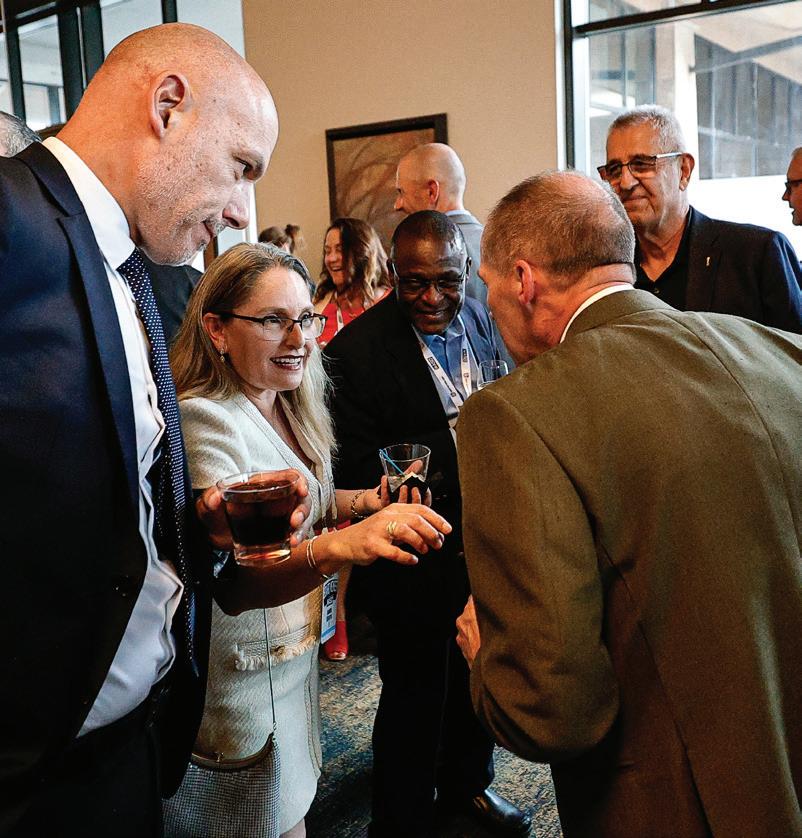

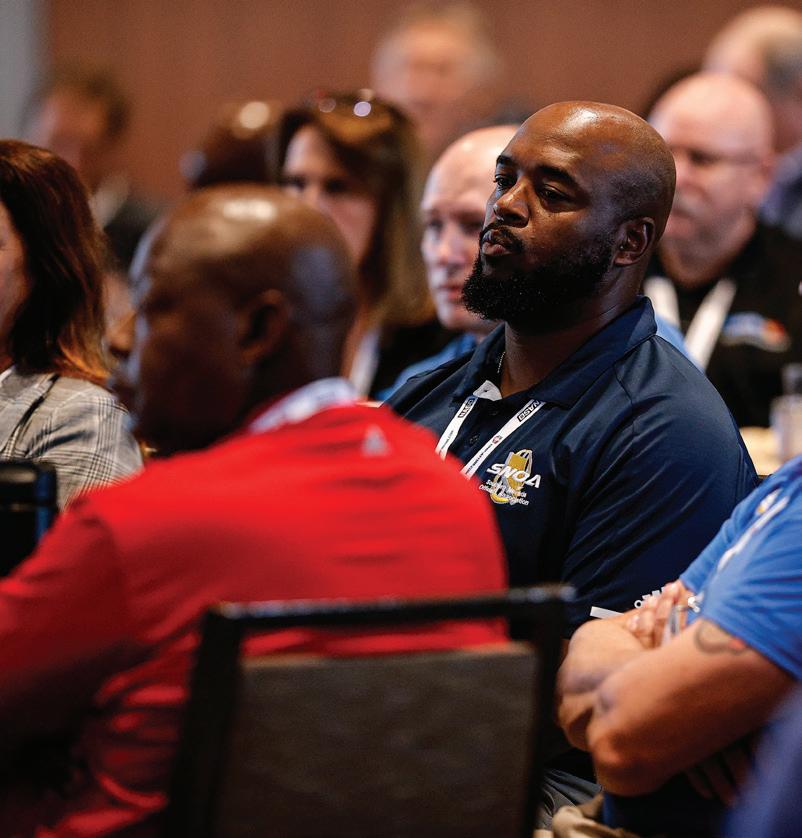
Innovation by Invitation
Cutting edge technology, programs, experiments, and research all rapidfired in 4-minute segments. You won’t want to miss this one!
Too Few of Us
A strategic approach to getting more officials.
Just a few of the urgent topics include
REGISTER TODAY AT SPORTSOFFICIATINGSUMMIT.COM
Labor Deal Reached for PRO2 Officials
ALEXANDRIA, Va. — Professional Referee Organization 2 (PRO2) officials, working primarily in the National Women’s Soccer League (NWSL), the United Soccer League (USL) and MLS NEXT Pro, voted to ratify their first collective bargaining agreement (CBA), the labor union announced April 14.
The Professional Soccer Referees Association (PSRA), the certified labor union representing the officials, said the new agreement for PRO2 officials will allow for improved training and development, minimum standards for locker rooms, injury protections, improved travel standards, coverage for parental leave and a competitive pay structure. Other details of the agreement were not released.
In 2013, the PSRA became the certified labor union for officials in MLS and was the first soccer officials union in U.S. history. Ahead of the 2014 season, it completed its first CBA.
In October 2021, the National Labor Relations Board (NLRB) ruled PRO2 officials are employees and eligible to unionize. In November 2021, officials voted, 68-3, in favor
THE WIRE
kid like this,” Sheriff Marcos Lopez said at a news conference.
Police Investigating Punch Thrown at Referee
The East Hempfield Township Police in Manheim, Pa., are investigating reports of a coach taking a swing at a referee during a youth basketball tournament at Spooky Nook Sports athletic complex the weekend of April 2830. Video of the incident — which showed a heated exchange between the coach and a referee
of unionizing and PSRA became the certified labor union for officials employed by PRO who work in the NWSL and USL.
PRO initially challenged the unionization vote, but in July 2022 withdrew that objection and proceeded with bargaining. At that time, PSRA and PRO reached a no strike/no lockout agreement through the end of the 2022 season and agreed to begin bargaining for a CBA in advance of the 2023 season.
“These talented officials had to fight to unionize and fought even harder to secure their first (CBA), which not only ameliorates their terms and conditions of employment, but also betters the profession for future generations of soccer officials,” said Lucas Middlebrook of Seham, Seham, Meltz & Peterson, LLP. Middlebrook worked with the PRSA committee to negotiate the labor agreement.
MLS, MLS NEXT, the NWSL and the USL have grown dramatically in the last decade.
At the time of PRO’s formation, MLS had 19 teams. Today there are 29.
The USL grew from 11 to 31 teams in the same period and NWSL added four teams to bring its total to 12.
quickly escalate and the coach taking a swing — went viral. Before the coach was pulled away, the referee and coach appeared to exchange minor blows. According to police, the coach and referee were no longer at the complex when the incident was reported to them. Police said they knew the identities of the coach and referee.
New Football Coordinators Named
The Big Sky and United Athletic
NFL continued from p.12
Ten. Bilbo, Campbell, Ledet and Walton were Big 12 officials. Carter, Flowers, Hankins and Petty come to the NFL from the Southeastern Conference. Keller was a Pac-12 official and Sakowski worked in the Atlantic Coast Conference.
All of the officials have pro experience by working either the XFL or USFL and have been in the NFL’s development program. Bergman, Campbell, Carter, Flowers, Hankins, Ledet, Sakowski, Steratore and Walton have been on the USFL staff while Bilbo, Keller and Petty have experience in the XFL. That has been an aid to the league since the demise of NFL Europe, which formerly served as a training ground for prospective officials or those who were tried at new positions.
The new officials replace 10 officials with a combined 203 seasons who retired at the end of last season.
They were referee Jerome Boger, field judge Michael Banks, line judges Jeff Bergman and Walt Coleman IV, down judges Mark Hittner and Jerry Bergman, back judges Keith Ferguson, Perry Paganelli and Steven Patrick, and side judge Jeff Lamberth.
conferences have new football officiating coordinators. The Big Sky hired Randy Campbell as its coordinator of football officials, the conference announced in early April. For the past two seasons, he served as coordinator of football officials for the Division II Rocky Mountain Athletic Conference. Campbell has more than
three decades of officiating experience, including working in the Big 12, Mountain West and Pac-12 conferences. The United Athletic Conference, which came about with the football alliance between the ASUN and Western Athletic conferences, hired Matt Young to serve as its coordinator of football officials, footballzebras.com reported in mid-April. Young is the coordinator of football officiating for the Ohio Valley Conference.

THE NEWS 14 | REFEREE July 2023
COURTESY OF BIG SKY CONFERENCE
States Pass Laws to Protect Officials

Arkansas became the latest state to pass a law to protect sports officials from abuse when Arkansas Gov. Sarah Huckabee Sanders signed House Bill 1496 into law March 30. The Hawaii House and Senate passed House Bill 264 and submitted it to Gov. Josh Green April 28. At press time, it was awaiting his signature. While Arkansas and Hawaii were already among the 22 states with legislation protecting officials, the new laws upgrade that protection.
Arkansas HB 1496, now Act 420, covers assault and harassment and includes four penalties for different levels of abuse, the most serious of which would apply if a person causes serious physical injury to an athletic official with the purpose of causing serious physical injury. This offense is a class B felony, which carries a sentence of between five and 20 years in prison. The previous law, passed in 1987, called for any abuse of an official to be a misdemeanor.
“There has been a positive reaction from our membership knowing Act 420 further protects our officials,” said Don Brodell, Arkansas Activities Association associate executive director who serves as a liaison for the Arkansas Officials Association. “With sportsmanship being one of the major reasons officials leave the profession, we want our officials to know they are protected under state law while working an event.
“As the public becomes
League Deploys Body Cameras


The Bankstown District Amateur Football Association in Sydney, Australia, announced May 5 it would be deploying body cameras for its referees. The announcement came one week after one of its referees suffered a broken jaw when a spectator struck him following a match. A 25-year-old man was arrested and charged with wounding with intent to cause grievous bodily harm and affray,
familiar with Act 420, knowing the consequences of physically abusing a contest official, it is our hope it will deter the physical abuse that can occur at athletic events.”
Arkansas Rep. RJ Hawk, the lead sponsor for the legislation, shared on his Twitter account, “It was an honor to be able to sponsor this legislation and fight for our officials in the state.”
Hawaii HB 264, introduced by several legislators Jan. 20, makes intentionally or knowingly causing bodily injury to a sports official a class C felony and authorizes a court to enjoin the offender from attending any sports event of the type at which the sports official was engaged in the lawful discharge of the sports official’s duties.
“This bill will afford protection within the justice system for threats and bodily harm to officials when spectators and fans are uncontrollable,” Keith T. Hayashi, superintendent of education, shared during March 14 testimony supporting the legislation. “The Department is committed to affording student-athletes with a
Combat Abuse
continued from p.12
offer will be shadowed by certified umpires to allow the games to continue operating smoothly and to get the calls right.
The policy is also meant to serve as a reminder that youth baseball
which is fighting in a public place that disturbs the peace. The 45-year-old referee, Khodr Yaghi, needed reconstructive surgery and spent four days in the hospital. The body cameras will first be made available to referees officiating senior men’s matches before being deployed at other levels.
MLB Umpire Hit by Throw, Hospitalized
MLB umpire Larry Vanover was hospitalized at the Cleveland


positive and safe high school athletic experience, and without officials for the contests, the opportunities would not be possible. We hope that this legislation will deter negative behavior from spectators and fans to allow for our student-athletes to continue to have a positive athletic experience.”
If signed, the law will upgrade protection legislation passed in 2020. Hawaii officials would join other protection classes in the state such as police officers, firefighters and health care workers.
Arkansas and Hawaii are among a record number of states to pursue assault and/or harassment legislation in 2023. According to NASO, at least 16 states have introduced bills to protect sports officials this year. In addition to Arkansas and Hawaii, other states that have pursued or are still pursuing officiating legislation during the 2023 legislative session include: Connecticut, Iowa, Kansas, Kentucky, Massachusetts, Minnesota, Mississippi, Missouri, New Jersey, New York, Pennsylvania, Tennessee, Texas and Washington.
isn’t just about winning. Parents who abuse umpires often lose sight of the fact they aren’t at an MLB game.
“They’re not baseball players, they’re children. So always keep that in the back of your mind and let them play,” Bozzuffi said.
Clinic for two days after an offline throw from shallow center field struck him in the head during an April 12 game between the New York Yankees and Cleveland Guardians. The 67-year-old umpire was struck on the left side of his head in the fifth inning
while he was positioned on the inside of the diamond. Guardians second baseman Andres Gimenez was trying to throw the ball to home plate. Vanover immediately left the game under his own power.
“That was scary,” said plate umpire Chris Guccione, who worked the rest of New York’s 4-3 win with a three-umpire crew. “Very hard to focus after that, after you see a colleague get hit.”
SOURCES: WCMH-TV, WOFL-TV, WPMT-TV, NEW YORK POST, THE GUARDIAN
REFEREE July 2023 | 15
JIM
COWSERT/TNS/NEWSCOM
FALSE ALARMS
Illegal Starts by Team A Merit Attention
By George Demetriou
At or near the top of the list of the most often called foul in football is the false start and it can only be committed by the offense. It is not found in the definitions and along with holding, it is an act that sometimes requires a great degree of judgment.
False starts can only be dead-ball fouls and are caused by mental and physical mistakes. Because they are somewhat position-dependent — the
movement of one player may be a foul while the identical movement by another player lined up in a different position may be inconsequential — they are inconsistently called.
We can group the positions that have differing standards for a false start into five categories, but before we address the differences, let’s review the acts that are universally false starts.
If any player does anything to simulate the start of the play (NFHS 7-1-7a; NCAA 7-1-2b) and in NFHS
only, commit any act intended to cause team B to encroach (7-17b), it is a false start. That makes mistiming the snap and moving early an automatic foul because the player is acting as if the play started. Additionally, overexuberant execution of what would otherwise be a legal act is also a foul. That would include a hard shift that could involve the entire line. Any abrupt, quick or jerky movement (pick your adjective) is a sure candidate to be a foul. After that, there is a variety

FOOTBALL RULES, MECHANICS, PHILOSOPHY EDITOR: JEFFREY STERN jstern@referee.com 16 | REFEREE July 2023
HESTON QUAN
When the defense is showing blitz, or when the quarterback changes cadence, offensive linemen are apt to commit a false start. If players on both sides of the line jump, officials are often challenged to determine if the offense moved before the defense entered the neutral zone.
of what officials will see and should consider a foul.
The false starts by position are listed roughly from the most restrictive to the least restrictive: interior linemen other than the snapper, the snapper, ends, backs other than the quarterback and the quarterback.
Interior linemen other than the snapper. Before interior linemen become set by going into a three- or four-point stance, they are allowed a certain degree of movement as long as they don’t lurch or charge forward. They can even break their scrimmage plane by pointing at the opponents to confirm blocking assignments.
Once they get set, the rules require those players to essentially become statues. Once they place a hand on the ground or below their knee, they cannot move a hand, flex their knee or arm or move a foot even if to only improve their balance. Other acts that have been observed include lifting the head and flinching in response to legal movement by the defense. Movement associated with normal breathing is of course allowed.
Under NCAA rules only, between the ready and the snap, if a team A lineman moves in reaction to a threat by an opponent who enters the neutral zone, it is an offside foul by the defense (2-18-2d, 7-1-5a2). A maximum of three offensive linemen can be threatened. If the defender enters the neutral zone directly opposite a lineman, that lineman and the two adjacent linemen are considered to be threatened. If the defender enters a gap between two linemen, only those two players are considered threatened. The direction the offensive lineman moves is not a factor; in either case, team B is offside. The team A lineman’s reaction must be immediate, and it must clearly be in response to a threat. If the team A lineman delays his movement, or if the defensive man is not head-on or close to him, the team A player is guilty of a false start (AR 7-1-3 V).
Also, under NCAA rules only, if the offense never has all 11 players set for a full second, it is an illegal shift that converts to a false start (7-1-2b5).
The snapper. The player with his hand on the ball is somewhat
free to move (as opposed to “move around”). There is a fine line between an illegal snap and a false start and that is best left for an academic discussion as both infractions are treated exactly the same.
A snap is the legal passing or handing of the ball backward from its position on the ground with a quick and continuous motion with the ball immediately leaving the hand(s) of the snapper. Restrictions on the snapper begin when the ball is ready provided the snapper has touched the ball. The snapper may adjust the ball, but may not move it forward, fail to keep the long axis of the ball at a right angle to the line of scrimmage or simulate a snap. Once he touches the ball, NCAA allows one or both hands to be slowly removed, but under NFHS rules, he must keep a hand on the ball until the snap (NFHS 7-1-3a; NCAA 7-1-3a1c). The snapper is allowed to turn his head and flex his knees, but if he abruptly flexes his elbows, jerks his head or dips shoulders or buttocks, he has fouled.
Ends. The players on the end of the line are less restricted than their teammates on the line. The chief difference is ends can shift after the line is set. Once they reset as a back, they may go into motion. In NFHS play, they can go in motion from the line as long as they are at least five yards behind the line at the snap. Under NCAA rules, the ends are restricted the same as interior linemen if they are numbered 50-79 (NFHS 7-1-7c; NCAA 7-1-2b-3). Ends can shift their feet, move their arms and turn their heads as long as they don’t do so abruptly.
Backs other than the quarterback. The allowance of movement for players in the backfield is very similar to that of ends. One extra thing they can do is to take a step forward to readjust their position or to start motion toward the sideline. Of course, that must be a slow step forward.
The quarterback. The player calling the signals can (literally) do things no other player can do. Consequently, false starts by quarterbacks are commonly the result of exaggerating legal movement.
SIDELINE
The Wayback Machine
During some recent spring cleaning, freelance photographer Dale Garvey found this photo from the Dec. 7, 1991, Virginia Division 6 high school championship game. The referee was Ron Cherry, who went on to a long and successful career in the Atlantic Coast Conference. Joining him on the crew were Frank McCain, Rudy Rice, Roscoe Hatten, Chris Brown and Dan Ferrell. Rice is the commissioner of the Southeastern Football Officials Association and Ferrell was an NFL official from 2003-21.

QUICKTIP
Keeping your whistle out of your mouth does more than help prevent inadvertent whistles. It also enables you to give verbal instructions. Referees can alert onrushing linemen, “The ball’s gone!” when the quarterback has passed the ball or the punter has kicked it to avoid illegal hits on those players. Covering officials can use phrases such as, “That’s all,” or “He’s down,” to let players know the play has ended, thus helping prevent dead-ball personal fouls.
TOOLS
Football Rules Challenge
Sharpen your rulebook knowledge with the 2023 Football Rules Challenge.
Engage in this fun, free challenging approach to studying the rules for the new season. Take a measure of your skills. The new Referee Rules Challenge is powered by the “Rules R” quiz platform, a state-of-the-art sports officiating testing program developed by Guy Bradbury, legendary international volleyball official and administrator. Get started today! Go to referee.com/ruleschallenge.
REFEREE July 2023 | 17
FOOT BALL RULES CH ALLENGE
TEST YOURSELF
In each of the following you are given a situation and at least two possible answers. You are to decide which answer or answers are correct for NFHS and NCAA rules, which might vary. Note: In kicking situations, K is the kicking team, R the receiving team. Solutions: p. 85
1. Third and five at team A’s 30 yardline. A1 fumbles. The ball is in flight when A2 bats it forward and it goes out of bounds at team A’s 35 yardline.
a. No problem.
b. Foul. The penalty is 10 yards and includes loss of down.
c. Foul. The penalty is 10 yards and the down is repeated.
2. Team A scores a touchdown on the first possession of an extra period. On the successful try, team B is flagged for roughing the kicker.
a. The penalty is declined by rule.
b. Team A may accept the point and have the penalty enforced at the start of team B’s overtime series.
c. Team A may choose to have the penalty enforced from the previous spot with the down repeated.
3. Fourth and four from team K’s 36 yardline. Team K is in scrimmage kick formation. K1 receives the snap and uses an overhand motion to throw a high and deep pass downfield toward eligible K2. R3 blocks K2 while the ball is in flight. The pass is uncaught.
a. R3 is guilty of defensive pass interference.
b. There is no foul on the play.
4. A1 is under a heavy rush and scrambles toward the line of scrimmage. His passing arm and one of his feet are beyond the neutral zone when he throws a forward pass.
a. Legal play. The passer’s entire body must be beyond the zone for that to be a foul.
b. Foul. If only A1’s arm had been beyond the zone, there would be no foul.
c. Foul. If any part of the passer’s body is beyond the zone, it is a foul.
5. Team A is granted a charged team timeout.
a. Only 11 players may participate in a conference at the sideline.
b. One coach may meet with players at the sideline and another with players on the field.
c. Any number of players may meet with any number of coaches at the sideline.
Slight bobbing of the head is a normal consequence of barking out cadence, but a brusque withdrawl of his hand would make it appear he has taken the snap. The same applies when the clapping of the hands is exaggerated.
A common misconception is once the quarterback has put his hands under the snapper, he cannot
withdraw them. Any methodical such movement is permissible, but a sudden jerk backward would simulate the snap. When he pulls back suddenly without the ball, it’s probably the snapper’s fault, but the foul is attributed to the back.
George Demetriou has been a football official since 1968. He lives in Colorado Springs, Colo.
Get the Spot Through Cross-Field Mechanics
By Jason Nickleby
Oneof the most critical responsibilities for the wings is to appropriately award forward progress to a runner when the ball becomes dead by rule. The runner’s progress toward the opponent’s goalline comes to an end when he is down by rule, his forward movement is stopped, he is out of bounds or when a loose ball is declared out of bounds (NFHS 2-15, 4-2-2a, b, k and l, 4-3-1, 4-3-3; NCAA 2-9-2, 4-1-3-a, b and p, 4-2-1, 4-2-4, 5-1-3).
When determining the forward progress spot, the covering official will judge the foremost part of the football when one of the previously mentioned situations occurs. Officials need to be aware of the location of the ball at that point. It is not critical to get the spot to a more precise location unless the line-to-gain or goalline is threatened, or play ends inside team B’s 10 yardline. Therefore, outside of those circumstances, officials should only come a few yards off the sideline with the downfield foot indicating the spot the umpire or referee will use to place the ball for the next down.
Umpires and referees needn’t make it so difficult on themselves. They need only place the ball so there is a landmark of sorts that can make it easy to place the ball at the previous spot or with penalty enforcement (i.e. nose/tip of the ball on the back or front of a line, halfway, etc.). If you put the football on an exact inch
line, it makes it more challenging to enforce a penalty from team A’s 48.33 yardline to team B’s 42.33 yardline.
Most of that seems fairly straightforward and it is for 95 percent of plays from scrimmage. One situation that requires a pregame discussion and cohesion between line of scrimmage officials is the concept of cross-field mechanics.
Cross-field mechanics are most typically employed on plays that end six to 10 yards downfield and the runner or receiver is driven backward in the field of play. Since the mechanics require maintaining relative proximity to the neutral zone until a pass is imminent, wings are pivoting on the sideline to view that action from behind. When the runner or receiver is driven backward, it is difficult to determine the foremost point of the ball when that player’s forward progress was stopped. To ensure the most accurate forward progress spot, especially when the line-to-gain is threatened, line of scrimmage officials shall utilize crossfield mechanics. Here is an example of how this concept is incorporated.
As seen in the MechaniGram on page 16, it’s second and six on team A’s 30 yardline. Receiver A1 goes airborne at team A’s 39 yardline, gains control of the ball and B2 drives him back to team A’s 35 yardline, where they subsequently go to the ground.
The head linesman will slow down mechanically, clearing the deadball action before moving upfield
FOOTBALL 18 | REFEREE July 2023
penalty enforcement rules explained










All the Latest on this Year’s Critical Rule Change

Everything you need to know about the penalty enforcement rule change on running plays. Easy to understand language and Referee’s exclusive MechaniGrams® with descriptions and caseplays scenarios. Understand enforcement rules on running plays as determined by fouling team, spot of the foul, end of the play, and basic spot like never before. of


learn
STORE. /football New 2023
more at
5.5”x8.5” 12
pages
Useful
*NASO Member & Bulk Discounts Available. $495 * DIGITAL $695 * PRINT $895 COMBO
laminated reference card included for quick reference
CASEPLAYS
Illegal Kick
Play: Fourth and 10 at team K’s five yardline. K1, in his own end zone to punt, muffs the snap. While the ball is rolling on the ground, K1 kicks it. The ball rolls out of bounds at team K’s 10 yardline. Ruling: If team R accepts the penalty, it scores a safety. In NFHS, the basic spot is the spot of the foul and that is the enforcement spot (10-4-4a). If team R declines the penalty, it would take possession at the spot the ball went out of bounds. In NCAA, the basic spot is the previous spot. Since the foul occurred behind the basic spot, the spot of the foul is the spot for enforcement. Because that spot is in team K’s end zone, the result is a safety. If team R declines the penalty, it would take possession at the spot the ball went out of bounds (9-4-4).
Pass Touched by Team B
Play: A1’s forward pass is touched behind the line by B2. The pass continues beyond the line to eligible A3, who was defended by B4. The covering official flags B4 for pass interference. Ruling: Pass interference restrictions end for both teams when a pass is touched by a team B player. If B4 interferes with A3 while the pass is in flight but before the pass is touched by B2, it would be pass interference (NFHS 7-5-9c; NCAA 7-3-9b, h).
Forced Touching Play: K1’s punt is rolling inside team R’s five yardline when R2 is blocked above the waist and from the front by K3 so that R4 touches the ball. Ruling: For scrimmage kicks that have crossed the neutral zone, touching is ignored if it is caused by a player who pushes or blocks an opponent into the ball. Thus the touching by R4 is ignored (NFHS 6-2-4, 6.2.4; NCAA 6-3-4).
Motion
Play: Halfback A1 legally goes in motion as signals are being called. Just as the ball is being snapped, A1 makes a 45-degree turn so he is facing the line. Ruling: If A1’s turn comes at the same moment the ball is being snapped, it is legal. A1 fouls if his turn comes clearly before the snap and is so abrupt it simulates action at the snap or is designed to make team B enter the neutral zone. The codes agree (NFHS 7-1-7a and b, 7-2-7; NCAA 7-1-2b-1, 7-1-3d).
parallel with the sideline, squaring off and moving with a purpose perpendicular to the sideline just as on any forward progress play. With cross-field mechanics, the linesman will look across the field to the line judge, who will be responsible for determining the forward progress spot on plays where the runner is driven back as described. The line judge will focus on the ball and move quickly to the forward progress spot. The line judge should be at the spot when the linesman is looking for assistance. The line judge may need to move closer to the inbounds spot and should utilize the communication device, if used, to inform the linesman the spot is determined.
The linesman, knowing the lineto-gain prior to the play through use of the pre-snap routine, will know the appropriate clock-related signal when seeing the line judge standing at the 31 yardline. The linesman will square off at the 31 yardline and proceed with the typical mechanics of communicating with the referee a first down has been achieved, moving the chains and preparing for the next snap.
If the line judge is at the 29 yardline in this example, the linesman should demonstrate the ball is short of the line-to-gain by indicating third down.
A situation where the head linesman would take more control over the progress spot would be when the receiver bobbles the ball before completing the catch, thus not establishing the forward progress spot until that point. The head linesman would need to assume responsibility by crashing hard on the spot and communicating that with the line judge.
It may seem counterintuitive the opposite line of scrimmage official would get that spot instead of the closest official. However, that official has the best perspective of exactly where the ball is when the runner is driven back, so we will arrive at the best forward progress spot possible by employing crossfield mechanics in those situations. Wing officials should be sure to pregame that scenario to ensure they are on the same page. By doing so, they will find their progress rulings will be more accurate and they will look smooth and professional in their mechanics, which leads to a better officiating experience for your crew.
Jason Nickleby is coordinator of officiating services for the Minnesota State High School League. He is also a center judge in the Big Ten Conference.
FOOTBALL 20 | REFEREE July 2023
PRESS BOX B2 A1 A2 A2 HC HC
Beanbagging Done Right
By Judson Howard
One of the most misused pieces of officiating equipment is the beanbag. It is often employed when it shouldn’t be, thrown when it should be dropped or not utilized when actually needed.
All officials should carry at least one beanbag, usually folded over the belt opposite the penalty flag. NCAA mandates black beanbags while the NFHS does not specify a color. The back judge in an NFHS crew of five must have two beanbags of different colors — one to mark the end of the kick and the other to indicate the spot of first touching. Other officials may never need a second bag, but it doesn’t hurt to have two.
An official should use a beanbag to mark the spot:
•Where a fumble occurs.
•Where a scrimmage kick ends.
•Where the kicking team first touches a kick in certain situations.
•Where the ball is caught or recovered when the momentum exception applies.
•Where the ball is located when an inadvertent whistle occurs.

Let’s break down the situations in which an official needs to have a bag down.
Fumbles. The spot where a ball is fumbled is important because it identifies where the run ends. For fouls during the interval between the fumble and recovery (while the ball is loose), we need to know the basic spot for penalty enforcement.
Play 1: First and 10 at team A’s 20 yardline. A1 runs to team A’s 35 yardline, where he fumbles. While the ball is loose, A2 holds B3 at team A’s 40 yardline. A4 falls on the ball at team A’s 45 yardline. Ruling 1: The basic enforcement spot for the
penalty is team A’s 35 yardline, where the fumble occurred. The covering official must drop a beanbag to mark the fumble spot. Since the spot of the foul is in advance of the fumble, enforcement is from the spot of the fumble. Thus, it is team A’s ball, first down and five at team A’s 25 yardline.
There is disagreement on whether or not a beanbag is needed to indicate a loose ball in team A’s backfield. Since the basic spot would be the previous spot should a foul occur during a loose ball situation, a beanbag is not required. It can serve as confirmation to onlookers a fumble has occurred.
Scrimmage kick. A beanbag should be dropped where a scrimmage kick ends. That is the post-scrimmage kick (PSK) spot. If a PSK foul occurs during the kick, the PSK spot is the basic spot for penalty
enforcement (NFHS 2-16-2h, 10-4-3; NCAA 10-2-3).

Play 2: R1 muffs a punt at his 35 yardline. The ball rolls forward to team R’s 40 yardline. R1 picks up the ball there and runs to midfield, where he is tackled. While the ball was loose from R1’s muff, R2 clipped K3 at team R’s 45 yardline. Ruling 2:
The kick ended where R1 possessed the kick, not where he muffed it. A beanbag should be dropped at team R’s 40 yardline (the PSK spot), which is the spot for penalty enforcement. The result is team R’s ball, first and 10 from its 25 yardline.
Touching a kick. A beanbag should be dropped when the kicking
team is first to touch a kick in certain situations. For free kicks, team K cannot be first to touch the ball unless it has gone 10 yards beyond its restraining line. For scrimmage kicks, team K cannot first touch the ball beyond the neutral zone. NFHS calls that first touching (6-1-6, 6-2-5) while NCAA uses the term illegal touching (6-1-3, 6-3-2a).
Do not blow your whistle when the kicking team is guilty of first or illegal touching. Drop your beanbag (not your flag) and allow the play to continue to its end.
Momentum. Both codes have a momentum exception (NFHS 8-5-2a Exc.; NCAA 8-5-1a Exc.). If a team B or team R player catches or recovers a loose ball inside his own five yardline and his original momentum takes him into his end zone where the ball subsequently becomes dead in his team’s possession, team B or team R gets the ball at the spot where possession was gained. Drop a beanbag where the ball is caught, intercepted or recovered.
Play 3: B1’s original momentum carries him into his end zone after he intercepts team A’s forward pass at team B’s three yardline. While running with the ball in the end zone, B1 fumbles and the fumbled ball goes
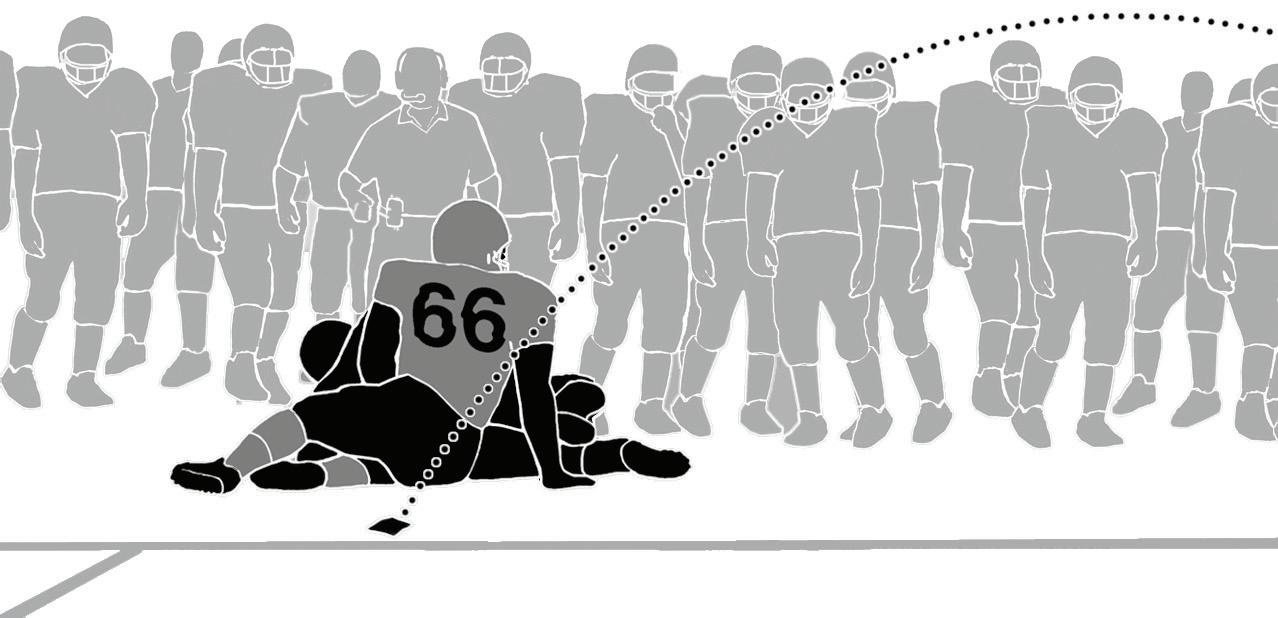
FOOTBALL 22 | REFEREE July 2023
out of bounds (a) in team B’s end zone, (b) on team B’s one yardline, or (c)on team B’s six yardline. Ruling 3: In NFHS, the momentum exception applies in (a) and it’s team B’s ball on the three yardline. In (b) and (c), team B puts the ball in play at the out-ofbounds spot. In (b), that is at the one yardline; in (c), at the six yardline. In NCAA, in each case, the ball is returned to the spot of the fumble and the momentum exception rule applies. It’s team B’s ball first down on the three yardline (7-2-4b-1).
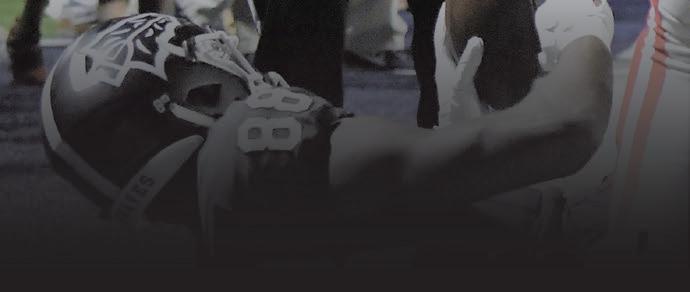
Inadvertent whistle. If the ball is in possession of a player when an inadvertent whistle is sounded, the location of the ball is important because it will determine whether the team in possession takes the result of the play or if the down is to be replayed (NFHS 4-2-3; NCAA 4-1-2).
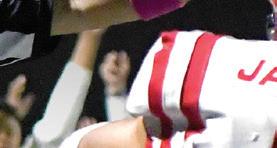



When not to use the beanbag. A beanbag is not needed to indicate the spot where a free kick ends or where a pass is intercepted. Those spots will never be used for penalty enforcement.


It is also not to be used as a substitute for hustle as seen in the PlayPic. When working as a wing official, if a runner goes out of bounds downfield from your position, do not throw or drop the beanbag, then


























run to the spot. Hustle to the spot as you would for any other play. In the event you have to move deep into the bench area to escort players from the opposing team from the bench area or monitor an altercation, it is acceptable to drop a bag at the spot beforehand. Mechanics. A beanbag should be dropped and rarely thrown. It does not have to land on the specific blade of grass where the fumble, touching or possession took place; it only needs to be on the appropriate yardline. Do not launch your beanbag overhand to attempt to hit an exact spot on the other side of the field. You will probably be off by a yard or two. An underhanded toss of the beanbag is desirable since its use is more passive than the use of a penalty flag. Have a beanbag in hand before the kickoff if an onside kick is anticipated.
If you are in doubt whether or not to drop a beanbag, go ahead and use it. There is no such thing as an “inadvertent beanbag.” You can pick it up if thrown in error. Nothing has to be explained to players or coaches. Judson Howard, Los Angeles, is a replay official in the Pac-12 Conference. He officiated more than 20 years, many at the NCAA Division I level.
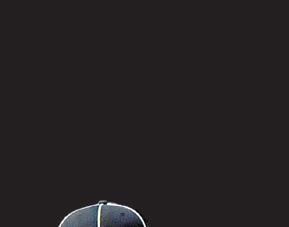
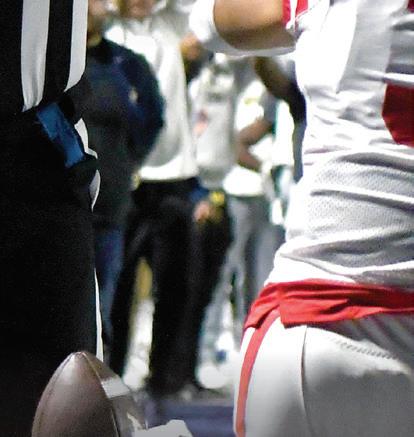
for the fall sports season with our all-new, alldifferent Football Rules Challenge!
Engage in this fun, free, challenging approach to studying the rules for the new season.
Or just take the measure of your skills and























SEE HOW GOOD YOU REALLY ARE!

FOO T BALL EN
GETREADY
ALSO AVAILABLE Volleyball, Baseball, Softball, Basketball & Socer! /RULESCHALLENGE
Anatomy Lesson, football style
There are many moving parts to officiating, as evidenced by the action in this photo featuring Matt Starr of San Diego. Actually, some of the parts aren’t moving, and that’s OK. 1

Starr’s head is still and his eyes are properly focused. The runner isn’t threatened, so his gaze is on the action in front of the runner. Potential problems include blocks below the waist and blocks in the back. 2
Once the ball was legally touched by team R, Starr gave the wind-the-clock signal.
3 Starr hasn’t dropped a beanbag, which means the momentum exception isn’t applicable on the play. 4
Starr is still positioned on the goalline. Once there is sufficient cushion between himself and the runner, Starr can begin to move down the sideline and cover the play. 1 2 3
FOOTBALL
4
HESTON QUAN 24 | REFEREE July 2023
















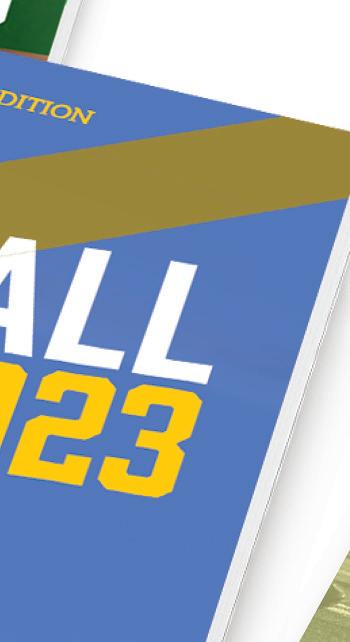

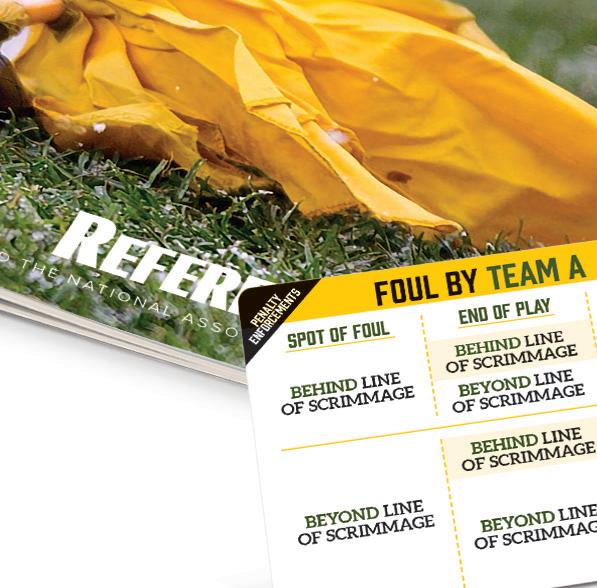


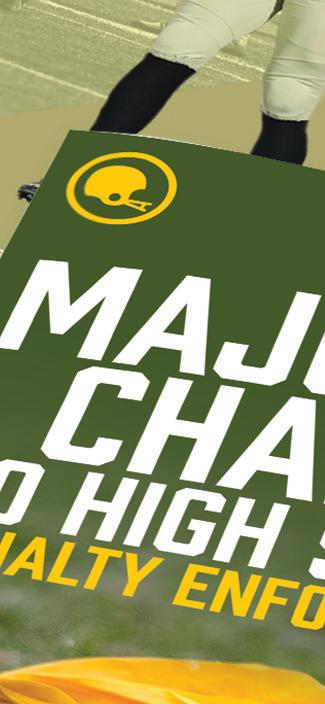
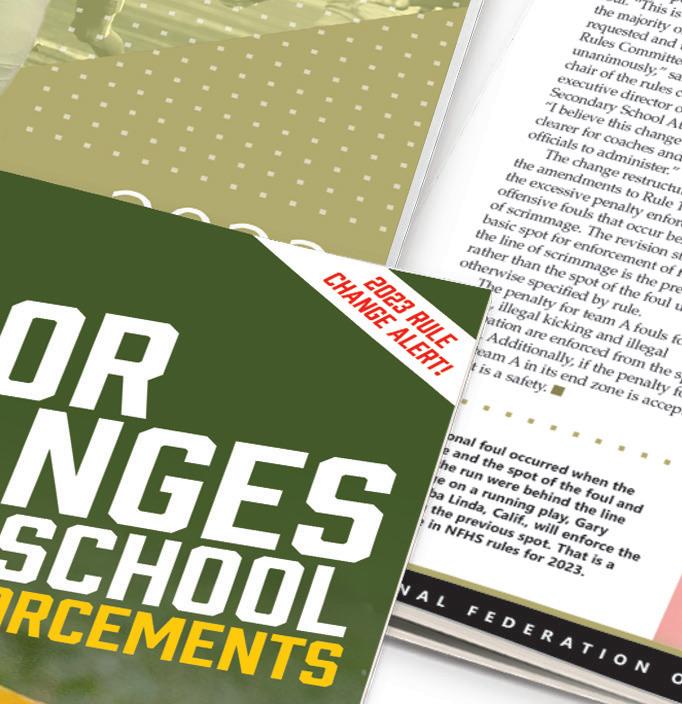

















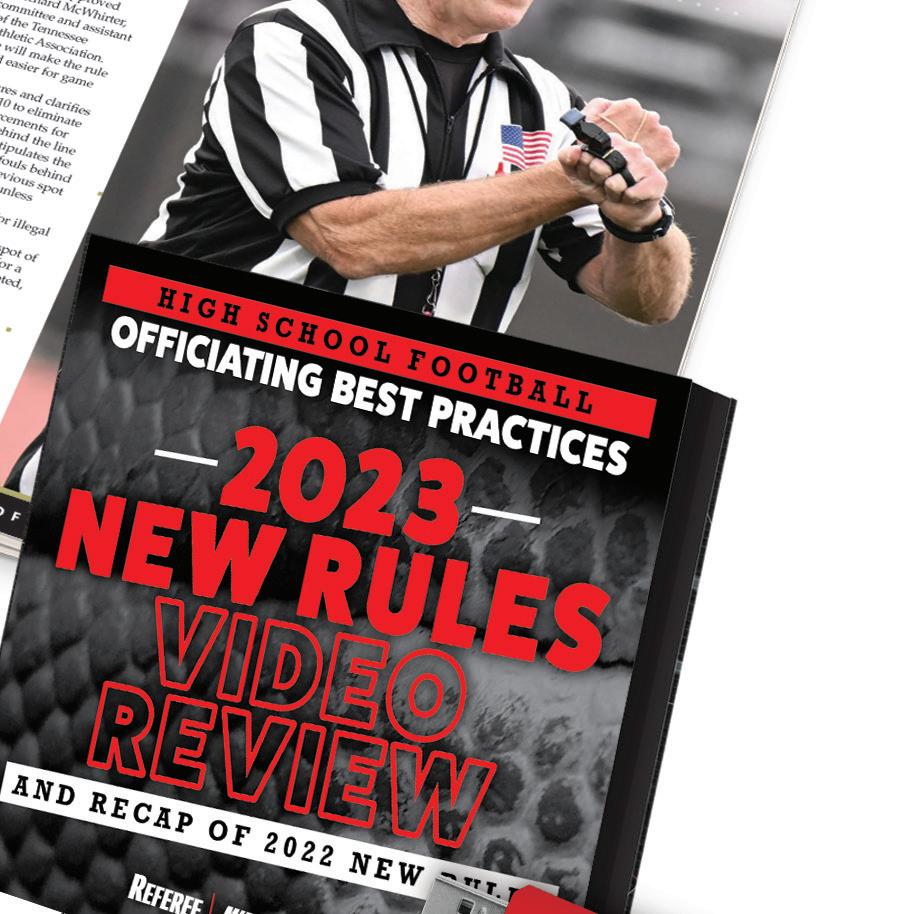





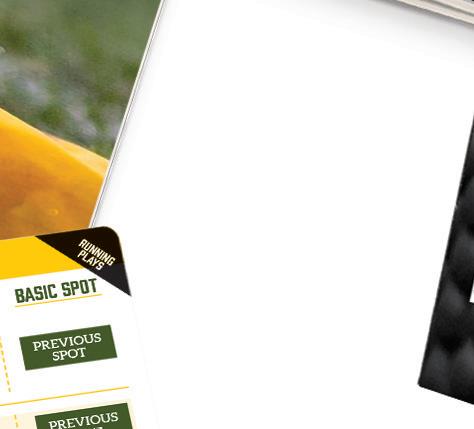

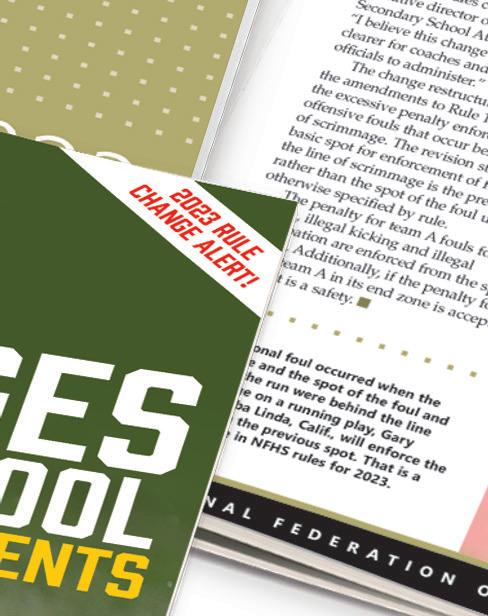



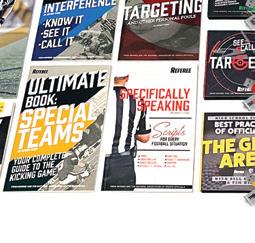













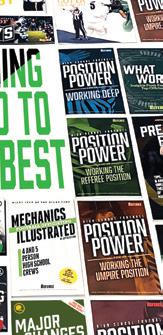
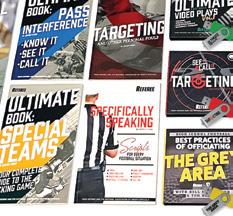


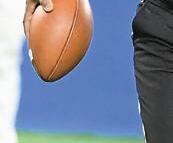











































THE 2023 COMPLETE FOOTBALL PACKAGE AVAILABLE NOW ORDER TODAY AT STORE. /football GET GAME READY! Sharpen your skills and rules knowledge with enhanced video training, rules updates, best practices, and in-depth analysis at one amazing price! ONLY $8495 $32 save $5.00 OFF your next order with promo code: 5bucks NOT VALID WITH ANY OTHER OFFER STORE. /footBALL HIGH SCHOOL FOOTBALL PENALTY ENFORCEMENTS MADE EASY 13th Edition By Jeffrey Stern ENFORCEMENTS PENALTY Made Easy HIGH SCHOOL FOOTBALL FROM REFEREE AND THE NATIONAL ASSOCIATION OF SPORTS OFFICIALS Cover_High_School_PE_2023.indd All Pages $5.00 OFF your next order with promo code: 5bucks NOT VALID WITH ANY OTHER OFFER STORE. /footBALL 2023 EDITION footBALL ALSO AVAILABLE HIGH SCHOOL PACKAGE ONLY $47 95 $ 15 save
order ON THE











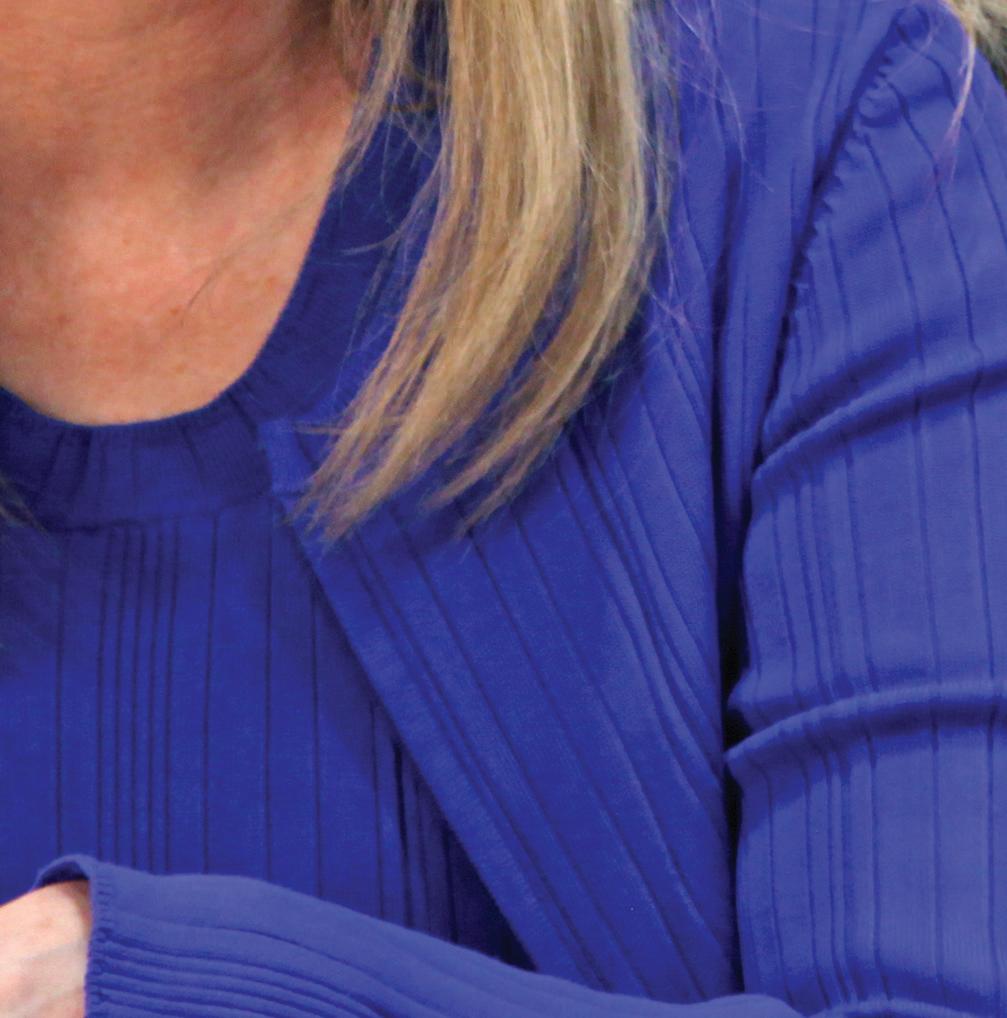



22
| REFEREE July 2023
ON THE












court

Julie Voeck has ascended to the highest






span of more than three decades she has
accomplished keeper of the
Now she is setting out on a new path. Voeck has retired from working women’s collegiate matches. Instead, she is preparing to become the NCAA’s secretary-rules editor for women’s volleyball. She’ll assume that role Sept. 1, taking over for the retiring Anne Pufahl.
At 59, Voeck wasn’t looking to leave the court.

But spending over a decade as the active official on the NCAA Women’s Volleyball Rules Committee and becoming attuned to the rulesmaking process, she found the opportunity to assume the secretary-rules editor’s post appealing.

“I’ve always had an interest in the rules,” she said, “and so there was a lot of encouragement from my colleagues and friends that this would be a good next step for me.
“I actually did want to take on this position.

It came along a little bit earlier than I really was ready for because I wasn’t ready to come off the court just yet. But that was the decision that I made. The position doesn’t come open very often."
Voeck isn’t stepping away from active officiating altogether. While she’ll no longer officiate women’s collegiate matches, she’ll continue to work at other levels, including NCAA men's contests. She also judges high school gymnastics meets.
But she now has new priorities and new responsibilities.
Wisconsin-Madison with a degree in mechanical
Wisconsin-Milwaukee.
REFEREE
REFEREE July 2023 | 23
rules as a veteran college official. Now she’s ready to add another challenge as NCAA secretaryrules editor for women’s
order court ON THE
She didn’t play volleyball in high school outside of gym class; she played soccer, and ran track and cross country, instead. But she got involved in the sport as an adult at the adult recreational level, where custom dictated each team participating in a tournament provide one player to officiate.
“I actually started officiating more out of a requirement than an interest,” Voeck recalled. “I was the only one on the team willing to do it. And then once I did it, nobody else would do it anymore.”
Voeck spent the next eight years officiating primarily adult league matches. Working at the high school level was out of the question at first because of her work schedule.
Often, she was the only official on the court.
“You learned how to do everything by yourself,” she said. “Even though you have a crew and a team as you get into higher levels, I learned very early on, I always have to stay on top of everything. I was the
only person officiating at all, so I had to do everything.
“And that’s a good way to start because you learn how to have an opinion and then, when you have a whole team of professional officials to work with, it’s good to have that base.”
For Voeck, officiating was a part-time job, nothing more. It didn’t become a passion until some years later. But she was good at it, and once she started working high school and club matches she steadily climbed the ranks, eventually working in nine NCAA Division I conferences and compiling a resume highlighted by 18 consecutive trips to the NCAA tournament (2004-21) and Final Four appearances in 2000 (as a line judge), 2011 and 2020.

She also worked four NCAA Division III finals (2011, ’12, ’20 and ’22) and the NCAA Division III men’s championship match three times (2014, ’18 and ’22).
Voeck also spent 15 years as an international referee, working an assortment of
events, including the World University Games, the PanAmerican Cup and other NORCECA tournaments in North and Central America and the Caribbean. In addition, she has worked beach volleyball and since 2002 has been the president of the Professional Association of Volleyball Officials (PAVO).
Approach to the Game
Pufahl, who has been a mentor to Voeck, says it’s her ability to work with people that sets her apart.
“It’s how she communicates,” Pufahl said. “She never gets upset. She’s always willing to listen to her partner, listen to coaches. That’s one of the things she’s really good about.”
Pufahl says Voeck is always approachable on the court and embraces the team concept with her crewmates.
“She won’t say to a coach, ‘No, no, I had the touch,’” she said. “She’s always going to say, ‘Coach, how can I help you? What do you need?’
“Or to a partner, ‘I had a touch, but what did you see?’ She’s very into getting the team together and hearing what everyone has to say before making a decision. That’s one of her greatest assets — her approachability.”

Jim Momsen has worked numerous NCAA matches with Voeck and succeeded her as president of Badger Region Volleyball, which serves the entire state of Wisconsin. He cites Voeck’s demeanor on the stand as one of the keys to her success.
“She gets in, through no fault of her own, some stressful situations,” Momsen said. “(But) she just has a composure about her and analyzes a situation, and acts appropriately without adding to the excitement, if you will. She’s just matter of fact, she understands the rules forward and back, and applies them appropriately.”
24 REFEREE July 2023 COURTESY OF JULIE VOECK
Voeck became an international referee in 2004. Her assignments abroad included the 2009 North, Central America and Caribbean Volleyball Confederation Final Four in Lima, Peru, and the 2010 Pan Am Cup in Mexico.
Momsen notes Voeck is not afraid to admit when she has made an error, either.
“Debriefing with Julie is a pleasure,” he said, noting she will share how both she and the officiating team can improve.
Steve Thorpe is the NCAA’s national coordinator of officials for women’s volleyball. Before he retired from collegiate officiating to assume the coordinator post, he and Voeck were frequent partners, notably in the Big Ten and the Missouri Valley conferences.
“The same reason that I look forward to working with her is the reason I feel confident when I assign her,” he said. “She comes very prepared and if you’re the first referee, you know you’re going to have a calming presence, and as a second referee, you know you’re going to have a first referee with a calming, authoritative presence.
“I know if she’s assigned to a match that things are going to be taken care of.”
Real Life Skills
Voeck, who is single and one of three sisters, utilizes her interpersonal skills on a regular basis in her day job, as the senior director of legislative and regulatory affairs for NextEra
Energy Resources, where she has worked for nearly 15 years. In that role, she represents her employer and the energy industry, appearing before state legislatures and other regulatory bodies and assisting with the development of policy positions.
She developed an interest in the regulatory side of the energy industry early in her career.
“My first job out of college was working as an engineer for Wisconsin Electric,” Voeck said. “I started out in the energy field. Because energy is a regulated business, I got involved with regulatory agencies and state government. In those roles, I became interested in policy issues in energy as well as other topics.”
Voeck travels frequently throughout the Midwest, working with state legislatures. Most of her traveling takes place in the first quarter of the year and doesn’t conflict with the women’s volleyball season.
“I have a hard time not being myself,” Voeck said. “I don’t like overpowering and not taking people’s feelings into consideration just in life in general and I think that’s carried over into officiating as well as my profession.
“I’ve often been asked to work with groups of people
At left, Voeck served as the president and commissioner of the Badger Region Volleyball Association in Wisconsin from 2008-19 and remains on the board of directors. She is the president of PAVO and recently participated in a 5K run fundraiser (right) sponsored by the organization.
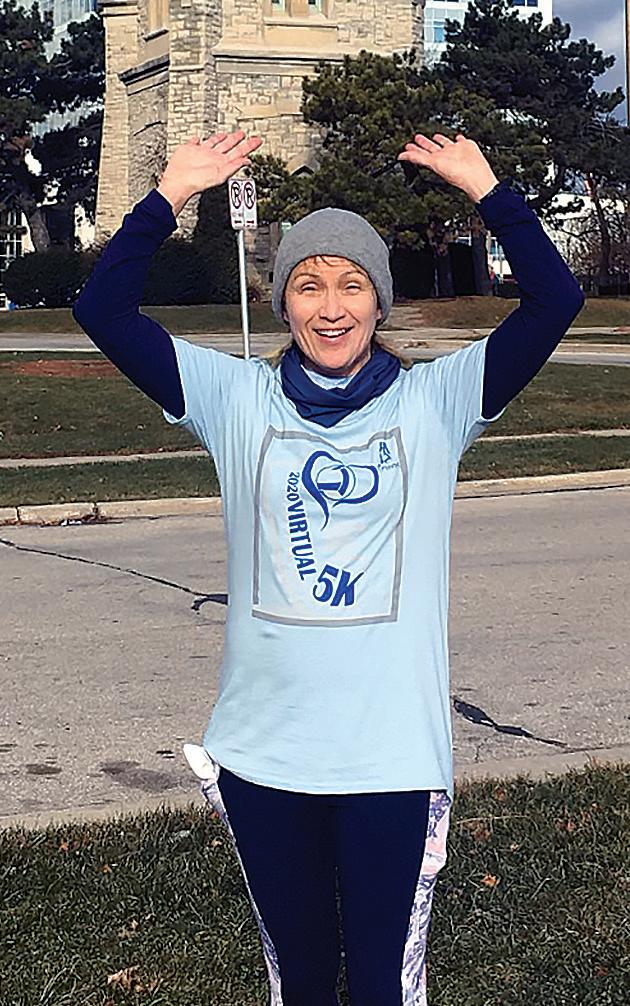

that have different viewpoints in officiating as well as my profession, so I’m often part of coalitions, or trying to get consensus on certain things and come to the best solution. I think that comes naturally to me.”
New Role Call
Voeck has worked with the NCAA Women’s Volleyball Rules Committee in an advisory role for over a decade, giving her an up-close and personal view of how the committee functions, and how Pufahl handled the secretaryeditor’s role.
“When I was interviewing for (the secretary-editor’s position) and they asked me what I thought was the hardest thing about this job, I said, ‘Following in Anne’s footsteps,’” she said.
“Because she’s been an amazing secretary-rules editor. I’ve had a little bit of a window into that job by participating in the rules committee, but what I’ve seen this year is just how Anne needs to balance the interests of so many parties.
“The interests of conference coordinators, the interests of the NCAA, the interests of athletes, the interests of coaches, the interests of media, which is now such a big part of the game, and the balancing she needs to do. She does a great job at it.
“She has promised me that
REFEREE July 2023 | 29
order court ON THE
she will be a resource for me, and I plan to rely on her pretty extensively.”
As the secretary-rules editor, Voeck will chair meetings of the committee but will not have a vote.
“I see my role as primarily a facilitator,” she said. “And as the game continues to evolve and grow, I’d like to be able to facilitate discussion on what makes sense for the game, and having been an official, you perceive a lot of things. You know what referees do during a match; you know where they look, how they look, why they look and what they see. You also see the reactions of coaches, you see the reactions of athletes.
“So, having that perspective of an official I think will be helpful. And one of the most exciting things is I will now be free to have conversations with coaches and conference coordinators outside of being an official.”

As secretary-rules editor, Voeck will, in conjunction with the committee, assume the task of drafting rules that referees can administer in a practical manner.
“That’s absolutely critical,” she said. “There have been times when a rule comes out and it has to go back and be
Voeck officiated in many major women’s volleyball conferences, including the Big Ten, Big 12, Big East, Horizon, MAC and Summit League. She has officiated in 18 consecutive NCAA tournaments, including three D-I Final Fours.
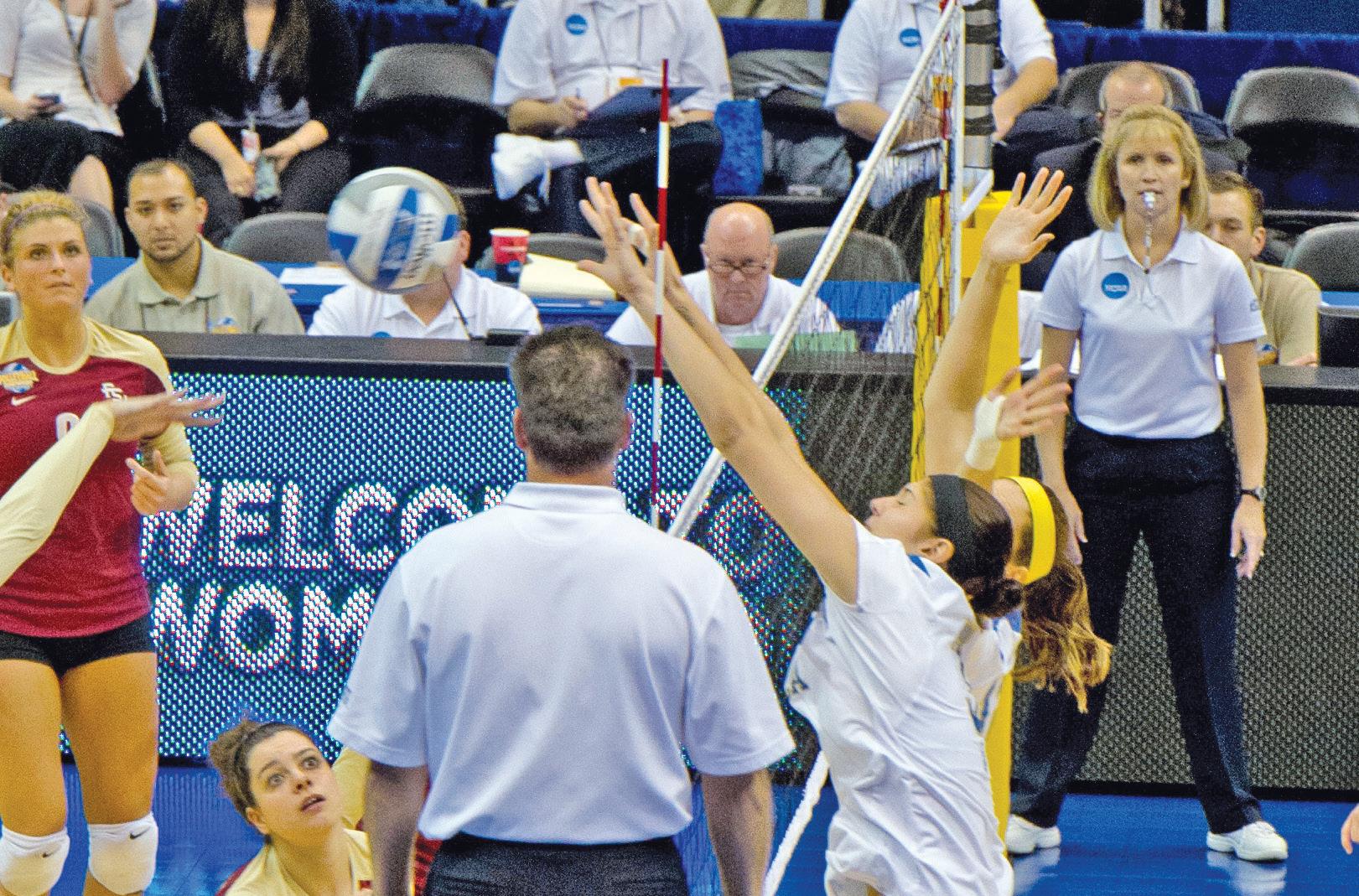
tweaked because it couldn’t be administered. It was confusing for coaches and athletes.”
Thorpe addressed the importance of the relationship between the secretary-rules editor and the national coordinator. He worked with Pufahl and Marcia Alterman, her predecessor, not only in his role as national coordinator but also when he was serving as the rules interpreter for USA Volleyball.
“We would talk on a regular basis,” Thorpe said. “Just to try and make things good for the game but also good for our officials.
“If the rules editor has officiating training on their mind and the rules coordinator has the spirit of the rule in mind, I think that they can each do their jobs that much better.”
Over the course of her career, Voeck has been a witness to the growing popularity of volleyball and the evolution of the sport on the court, including the introduction of the libero/ defensive specialist and perhaps most significantly, the liberalization of ballhandling rules.
“There have been a lot of things to speed up the game,” she said. "When I first started, officiating had a lot to do with
quality of the contact; was it legal or illegal?
“When the ball was served you had to put your arms together and underhand pass the ball. If you used your fingertips, you were pretty much going to be called for a double hit. Now, with contact on the first ball, you’re allowed to double hit it so the ball doesn’t travel as far. On the second and third contact, you can’t double hit it, but we’re a lot more liberal when a player is making an athletic action. We allow them a lot more leniency on what they can do. There is an interest in taking the officials out of it and letting the power of the players take over.”
As she prepares to step into her new position, Voeck speaks to the importance of helping coaches and officials adapt to today’s game.
“We continue to train both coaches and referees on play underneath the net at the center line,” she said. “(Because) there is judgment involved and the reason that there’s judgment is that we allow a player to step onto the opponents’ court.
“Safety becomes a factor. If an opponent is nearby it’s called a foul but if an opponent is not nearby, we allow play. That’s a judgment. What does nearby mean? There is not a specific measure. So that’s a little bit confusing for athletes and coaches so there is continuing education.”
Video challenge/review has been part of NCAA women’s volleyball since 2016. The challenge/review protocol has continued to evolve in the years since.
“Some of the challenges have gotten a little bit complicated,” Voeck said, “and we’re continuing to educate there as we find the cases related to challenge/review so coaches and officials can be better informed.
“If it’s not clear and it can’t be administered, that creates a bad environment for all involved.”
Voeck embraces the idea of
26 | REFEREE July 2023 COURTESY OF JULIE VOECK
compiling all the information pertinent to video review in a single document. She calls the concept her top priority as she prepares to assume the secretary-rules editor’s post and notes that a precedent exists in football.
“There is a document that has been put together for NCAA football on their video review,” she said. “I think it’s like 81 pages. They put all the stuff related to video review in a separate document.
“I would like to see something similar put together for volleyball so it can be a reference for coaches as well as officials. I really think having them all in one place would be helpful.”
Moving the Game Forward
Voeck, who served on NASO’s board of directors from 2015-19, is committed to expanding the pool of officiating talent. She addressed the topic with the American Volleyball Coaches Association (AVCA) board of directors at the most recent Final Four in Tampa, Fla.
Voeck embraces the concept of bringing former college players into the officiating ranks and putting them
on a fast track to reach the collegiate level as officials.
While it typically might take new officials five to eight years before they’re prepared to work at the collegiate level, Voeck contends novice officials with backgrounds as players can and should follow a different path.
“Athletes that played at the top level don’t want to start at the bottom,” she said. “When you tell folks who have had a four-year or maybe a five-year college career that it takes five to eight years before you can get a college match, that’s not very appealing.
“I would like to see us partner with the AVCA and the PAVO and come together to create a streamlined process for players to become collegiate referees.
“What I’m envisioning is looking at our volleyball year, after the season ends, in November or December, depending on the level,” she said.
Athletes could get some kind of scholarship where they would go to a camp in the spring.
Voeck envisions the camps being open to any official who wanted to attend and would emphasize training as opposed to being a tryout camp.
Voeck still plans to officiate NCAA men’s volleyball, but she’s stepping off the court from NCAA women's volleyball to assume the secretary-rules editor position.

“These are for any officials who want to go,” she said. “No guarantee you’re going to be on any (conference) roster. We’d invite conference coordinators. We’d send reports to conference coordinators, but they wouldn’t be run by conferences.
“Officials would get feedback, the evaluators would provide an assessment, if they want that to be sent to a conference coordinator, we will.
“In the summer, the athlete would go to a clinic. They would have to take the rules test; we have an online testing program, and they would get assignments that fall. Not at the Division I level but entry-level collegiate volleyball. We would work with local assigners to get them three matches where they would work with an experienced official."
Voeck understands there is a shortage of officials throughout the country. She believes the scenario she has in mind will address the issue and enhance the game going forward.
Voeck feels the novice’s background as a player and familiarity with the competitive environment would offset their lack of officiating experience.
“It’s not foreign to them,” she said, “because they’ve been a player.”
Rick Woelfel, Philadelphia, is a freelance writer and softball umpire.
REFEREE July 2023 | 31
REFEREE
CLEAR AS MUD
Determining Block, First Contact Not as Simple as Rules Knowledge
By Bill Thornburgh
When making decisions on whether a block just occurred or if it was the first team contact, most of the time it is pretty clear. The routine plays, standard techniques, normal player positioning and player (or coach) reaction contribute to our comfort in either allowing play to continue or whistling one of these possible faults: two hits if the player (the blocker) was below the height of the net when first contacting the ball, then the same player made a second attempt to play the ball; two hits if the player (the blocker) was deemed to be an attacker, the ball did not cross the net and the same player played it again; four hits if the first contact was not considered a block and the team contacted the ball three more times; or an illegal attack if the player reached over the opponent’s court and attacked the ball instead of blocking it.
We use our knowledge of the rules to determine if a block occurred using one of the various rulebooks, which state the following:
NFHS — Blocking is the action of a player(s) close to the net that deflects the ball coming from the opponent by reaching higher than the top of the net at the moment of contact. A block may involve wrist action provided there is no prolonged contact.
NCAA — Blocking is the action of a player(s) close to the net that deflects the ball coming from the opponent by reaching higher than the top of the net. A blocked ball is considered to have crossed the net. The blocking action ends when the blocking player makes a subsequent attempt to play the ball.
USAV — Blocking is the action of players close to the net to intercept the ball coming from the opponent by reaching higher than the top of the net, regardless of the height of
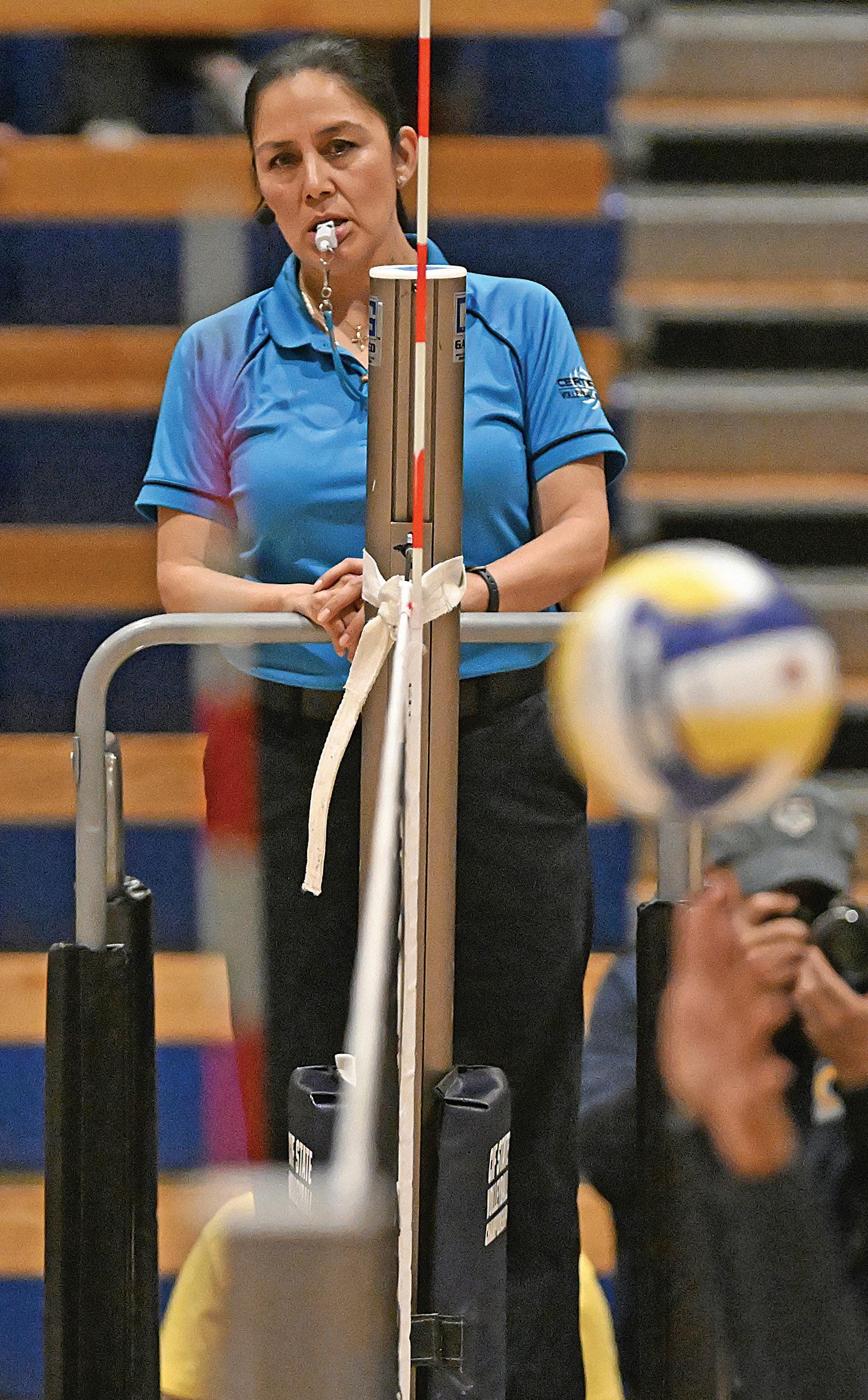
VOLLEYBALL RULES, MECHANICS, PHILOSOPHY 32 | REFEREE July 2023 EDITORS: BRAD TITTRINGTON btittrington@referee.com
Olga Espinoza, Los Angeles, must make a determination if this contact is considered a block or if it constitutes a team’s first contact. The decision is not always clear cut and not everyone will always agree.
the ball contact, but at the moment of the contact with the ball, a part of the body must be higher than the top of the net.
Each rule set also includes information about an attempted block, a completed block, a collective block and clarification statements regarding who, when and where.

Or we use other rules to determine if player contact with the ball counts as the first team hit. The various rulebooks state the following:
NFHS — A team shall not have more than three hits before the ball crosses the net into the opponent’s playing area or is touched by the opponent. When the team’s first contact is simultaneous contact by opponents, or an action to block, the next contact is considered the team’s first hit.
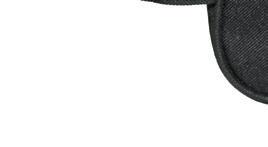
NCAA — A blocking contact is not counted as a team hit. After a block contact, a team is entitled to three hits to return the ball to the opponents. The first hit after the block may be executed by any player, including the player who blocked the ball.
USAV — A block contact is not counted as a team hit. Consequently, after a block contact, a team is entitled to three hits to return the ball. The first hit after the block may be executed by any player, including the one who has touched the ball during the block.

If the rules are clear on what constitutes a block or what is a first team contact, how can referees make errors on this decision? Well, I am sure many of you have encountered certain plays when you, your partner or referees on television struggled to make the correct decision. What was it about that play that was not clear? What do you think led to others having a different opinion on whether it was a block or first contact?
Here are some possible things that could be going through a referee’s head, which could affect decisionmaking:
Was the player close to the net?
Yes. No. Maybe. It was pushing a “normal” blocking position by being off the net.
Was the player reaching higher than the top of the net?
Yes. No. Whew, it was close. Did the player touch the ball?
Yes. No. Maybe. I’m not sure. I hope my partner can help me.
Was there a back-row player involved in blocking?
Yes, they contacted the ball while blocking. Yes, that player did not contact the ball but was part of a collective block. Yes, but I’m not sure if anyone attempting to block touched the ball. Come on partner, help me out.
Did the player make a blocking action or an attacking action?
It was a clean (legal) block. It was an attempt to block, but ended up caught and thrown. It was not determined to be a block, but an attack hit.
Did the same player make two attempts to play the ball?
No, it was a block followed by first contact. Yes, it was first contact followed by an additional contact. Maybe, it was very close and participants are reacting strongly that they disagree with my decision.
Did a teammate play the next ball?
Yes, a teammate blocked the ball and another player made the next contact. No, the blocker completed a block and then made the next contact. No, the blocker played the first ball (but it wasn’t a block) and then immediately made a second attempt. How many hits did the team make?
If you determined it was a block, they get three more. If you determined it was first contact, they better only hit it two more times before sending it over the net. Oh boy, I don’t know what just happened.
In an attempt to find out how top-level referees approach a block versus first contact situation and identify when it can be difficult to decide, I interviewed four of the best: Jung Park, Carla Bunner, Bill Stanley and Michelle Prater. Here are their responses, as well as my personal take, in no particular order:

Prater: “If a player is in a blocking motion and the hands or body is/ are above the net when contacting the ball, it is (and I say it in my head) a block. But there are times
DID YOU KNOW?
According to the 2022-23 NFHS Handbook, only two state associations hold a statesponsored championship in beach volleyball. Arizona and Florida hold state championships for girls. Florida holds one on the boys’ side as well. According to the handbook, there are 7,207 participants at the high school level in the sport nationwide.
QUICKTIP
TOOLS
Referee Bag
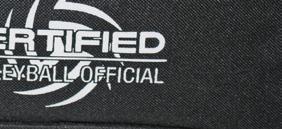
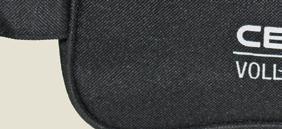

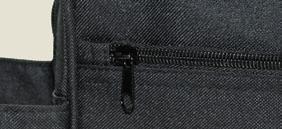

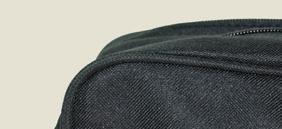


Do you need a bag in which to keep all of your accessories? The referee bag from Roof Sportswear is perfect. This handy bag has two pockets, is embroidered with the “Certified” logo and can be embroidered with your name to distinguish yourself. The bag fits nicely inside of a backpack to carry into the gym and then can sit at the scorer’s table for easy access. The cost of the bag is $24 and you can have your name embroidered for an additional $12. It can be ordered at roofsportswear.com.

REFEREE July 2023 | 33
When a play ends with a replay, ensure the official scorer understands there was no point awarded and that the rally will be replayed. Once that is done, verify the scoreboard operator has the correct score displayed as well to avoid confusion.
TEST YOURSELF
In each of the following, you are given a situation and possible answer(s). You are to decide which answer(s) are correct for NFHS, NCAA or USAV rules, which might vary Solutions: p. 85
1. A1 spikes the ball to the floor on team B’s court. After the ball hits the floor and the first referee blows the whistle, which of the following will result in a fault?
a. A1 steps completely across the centerline and touches team B’s court.
b. A1 touches the net.
c. A1 touches the antenna below the top of the net.
d. All the above result in a net fault.
e. None of the above will result in a fault by A1 since the play immediately becomes dead when the ball contacts the floor.
2. Following the third team hit by A1, A2 and B3 simultaneously contact the ball above the top of the net in the plane of the net (joust).
a. No fault has occurred. The team receiving the ball after the joust will have three hits remaining.
b. Because team A has used its three team hits, team B must be allowed to touch the ball before team A can legally play it again. The result is a “four hits” call against team A.
c. Team B has committed a blocking fault. After team A’s third hit, the ball must cross completely beyond the net before team B can contact it.
d. Double fault. Team A is guilty of “four hits” and team B is guilty of “reaching beyond the net.”
3. A1 moves toward the net to set a pass. After completing the set, A1’s entire foot crosses the centerline and touches the opponent’s court.
a. If there is no opponent in the vicinity of the encroaching foot, and consequently no interference and no safety hazard occur, the referees should allow play to continue.
b. Provided A1 has one foot still in contact with team A’s own court, that is always considered legal and play should continue.
c. It is a fault to touch the opponent’s court with any part of the body while the ball is in play. A centerline fault should be called.
d. It is legal for a player to touch the opponent’s court across the centerline with a hand(s) or foot/ feet only when a part of the foot/feet or hand(s) remains on or above the centerline. A centerline fault should be called in this situation.
when it is questionable, like when a player does not jump or when a player ‘swipes’ at the ball with a directional block.”
Park: “Judging a mistimed block can be very difficult, as it could look like a first contact. I would ask all referees to remember there is nothing written that says blocking has to be a forward or straight up motion. Similar to ballhandling, ugly blocking does not equal first contact.”
Stanley: “I base a block on the definition, and then look at the amount of motion (or action) the player uses to contact the ball. A block is a player near the net, reaching higher than the net and intercepting the ball coming from the opponent.
“I start with that. The typical scenario is an attack into arms and no chance of really moving a hand or any action that would look like an attack.
“When the opponent’s attack is slower and has time to react to the ball, now I look for more of an attack motion we would normally see from hitters. Is the elbow loaded or behind the head? Or is the hand making more of a snap on the ball as opposed to a deflection off the hand? The more (a player) starts looking like an attacker, the more I may call it first contact and not a block if (that player) happens to make another attempt at the ball.
“There are times where it is difficult to say if a player was a blocker or made first contact. It comes down to how you judge the first contact and you have to make up your mind quickly, right or wrong.
“Like with any call, you have to have an opinion. That tells you what can happen next. Sometimes the blocker is in that gray area where the (player) could meet the definition of a blocker, but is really trying to push or snap the ball down. This looks more like an attack than a block.
“It comes down to making a quick decision and knowing what can happen next (based on that decision). It’s not an exact science.”
Bunner: “I determine block versus first contact based on the explanation in the rules of what meets the definition of a blocker. The times it has been difficult to determine if it was a block is when ‘close proximity’ becomes too subjective. Where does that line really exist?
“Additionally, sometimes it becomes difficult to determine a block or first contact due to what the blocker’s physical motion is and if there seems to be any kind of attacking motion, compared to an attempt to intercept the ball coming from the opponent.”
Here are my thoughts: I use the stated rule when making a determination if a block has occurred. Is the player(s) close to the net, reaching higher than the top of the net, attempting to intercept the ball from the opponent, and contact is made with the ball (regardless of the height of the contact)?
Situations I have seen that create uncertainty for me, or create excitement for players and coaches, are when the blocker is off the net, the blocker makes contact with the ball when on the way down from the jump, a one-handed block (or poke) occurs, or when the blocker makes more of an attacking motion than a traditional blocking motion. While it isn’t always clear, and others may not agree, we just need to make a decision and go with it.
I hope this has helped you think about the many things that go through a referee’s head when making a (perceived) simple decision, as well as knowing that even some of the best referees get it wrong.
As you consider your own whistling and experiences, here are a few things to remember: know the rules, anticipate play, stay focused, communicate with your partner, and understand that poor technique does not mean illegal.
Bill Thornburgh, Shelbyville, Ky., is a National USAV and PAVO referee, as well as a FIVB International referee. He works in the Big Ten, Atlantic Coast, Southeastern and other D-I conferences around the Midwest.
34 | REFEREE July 2023 VOLLEYBALL
PHOTO COURTESY OF SOUTH DAKOTA PUBLIC BROADCASTING. ©2022 SDPB JOSH JURGENS
Net ReMinders




















For referees, plays at the net can be difficult to adjudicate. For Kim Weed, Sioux Falls, S.D., there is a lot to sort out on this play for her and her partner to properly rule on it. For the purpose of this illustration, assume the player in blue is the setter and she is attempting to make a play, which would be the team’s second contact, on an overpass by one of her teammates. The referees must ponder the following to correctly rule on this play.
1 2 3 4 5








Is the ball in the plane of the net? If so, it is fair game for both players to play. If not, the player in red may be guilty of a fault for reaching over the net.



Is the setter in the front row or back row?


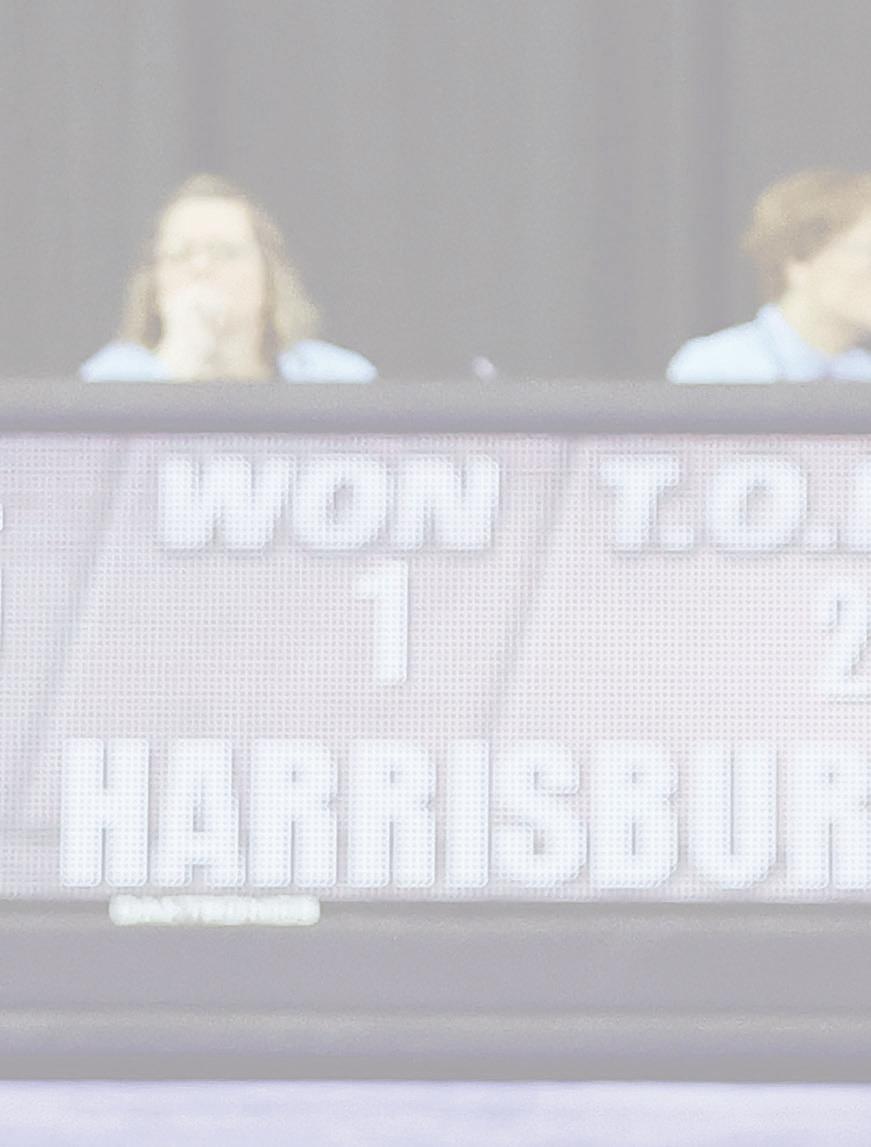

If she is a front-row player, this contact is legal, regardless of the height of the ball. If she is in the back row, this may be an illegal attack or an illegal block by her. See No. 3.


If the setter is in the back row, the height of the ball matters. If the ball is not completely above the height of the net, no issues. If the ball is completely above the height of the net and the setter touches the ball first, causing the ball to contact the red player’s hands, the setter is guilty of a back-row attack. If the player in red played the ball first (or it is simultaneous contact) and the setter is contacting the ball completely above the height of the net, it is an illegal block by the setter.



Neither player must touch the net in this situation. With both players having body parts close to the net, it is important for the second referee to keep focus at the net and make sure neither player makes contact with the net, either on the way up or on the way down.
Assuming everything about this play is legal, the final factor to consider is the feet of the players at the net. When the players return to the floor, it is important to make sure neither player commits a centerline violation.

2












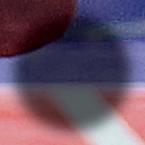

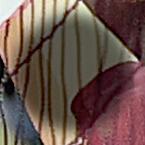




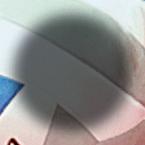



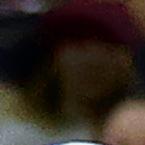
3 4 4 5


1
REFEREE July 2023 | 35
CASEPLAYS
Server Positioning
Play: S1 wants additional space for the serve and lines up outside the sideline to get a running start toward the endline. S1 tosses the ball and takes two steps toward the endline, with both feet contacting the floor completely inside of the sideline extended, but behind the endline, before jumping and contacting the ball. Ruling: Legal in all codes. It is legal for the server to start the service approach outside the serving area beyond the hash marks that define the service area. However, the contact of the serve must take place within the service area, and the server cannot be touching the endline, the court or the floor outside the service area hash marks at the moment the ball is hit for service (NFHS 2-1-6, 8-1-2; NCAA 13.1.3.6; USAV 12.4.3).
Substitution During Timeout
Play: During a timeout, team A’s coach indicates to the second referee the team would like to make a substitution. No substitutions were completed by team A prior to the timeout being called. The second referee indicates any substitution requests will be administered at the end of the timeout after the teams have returned to the court. Ruling: Correct ruling by the second referee in all codes. A substitution request during a timeout will be recognized at the end of the timeout (NFHS 10-2-5; NCAA 11.3.3.2.6; USAV 15.2).
Ball in Plane of Net
Play: A1, who is near the net, reaches higher than the top of the net to save an overpass. The ball enters the vertical plane of the net where B2 simultaneously contacts the ball with A1. Both players are contacting the ball completely on their own sides of the net. The ball returns to team B’s side of the net, where B3 passes it to the setter, who sets the ball to B2 for a successful attack hit. Ruling: Legal play in all codes. Both teams have a right to play a ball that has entered the vertical plane of the net. When two opponents touch the ball simultaneously over the net and the ball remains in play, the team receiving the ball is entitled to another three hits (NFHS 9-4-6d; NCAA 14.3.2.1; USAV 9.1.2.2).
Get in the Book
By Robert Doan Study?
Who needs to study? I have been a volleyball official for years. I do not need to study. I showed up for clinics; isn’t that enough? Similar to conversations we have with our teenagers and their study habits in school, officials have an obligation to study as well. Simply showing up for clinics before the season or “learning on the court” is not enough. To be a great official, one must spend quality time studying the rulebook, caseplays and the manual. This article will explore ways to study all three.
Rulebook
The rulebook can be dry at times. Have you ever read several rules and stopped and thought to yourself, “What did I just read?” It is important to stay focused when reading the rulebook because it is different than reading a novel or any other book for pleasure. For new officials, reading the rulebook is important to learn actual rules the average fan does not know. For example, screening is not a common fault the average fan sees during a volleyball match. New officials should pay a little more attention to the uncommon calls, rule differences between multiple rule sets and scoring.
Each year, officials should read the entire rulebook once, if not multiple times. One must be very familiar with all rules and be able to apply pertinent rules to game situations. In addition, officials must also be able to explain the rule, should a coach seek information about a certain call. When studying the rulebook, it is important to pay attention to language and visualize the rule being enforced.
For example, all rules codes basically define blocking in a similar way. Here are the four key points:
1.The player(s) must be near the net.
Studying: It cannot be a block if the player is not near the net. One point of reference might be if the player is closer to the net than the 10-foot line.
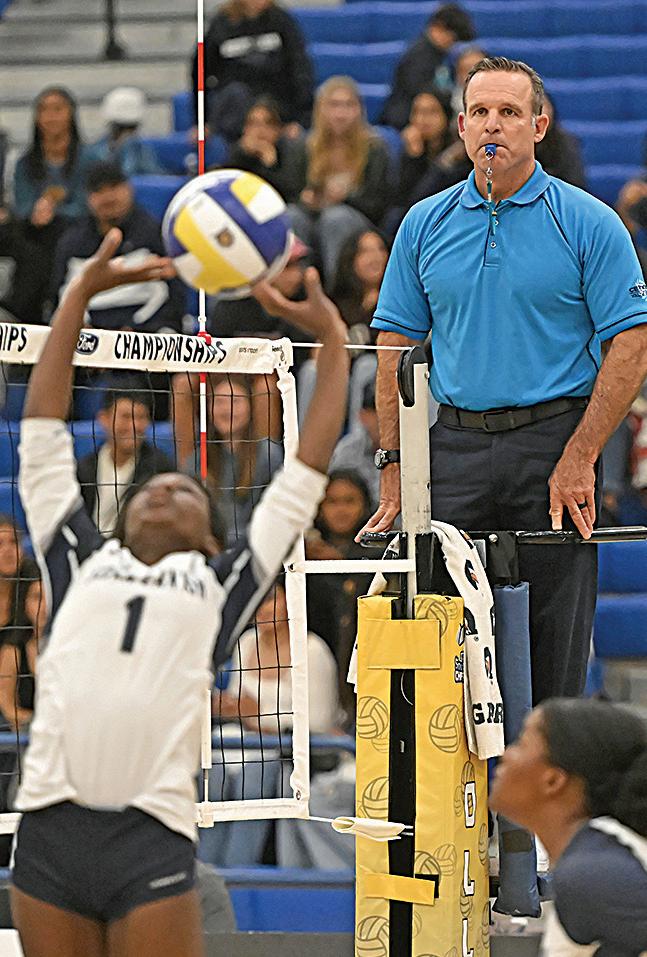
2.The player(s) must be reaching higher than the net.
Studying: An illegal attack is judged by the height of the ball, while an illegal block is judged by the player’s hand or body part in relation to the net.
3.The player(s) is/are attempting to deflect or intercept the ball coming from the opponent.
Studying: A block cannot be a pass from a teammate, it must be a ball coming from an opponent’s side of the net.
4.The ball does not need to be higher than the top of the net when the blocking contact occurs, but the player(s) need to be reaching higher than the net.
Studying: Again, focus on the player’s reaching height and not the ball.
Caseplays
If an official is having a hard time visualizing a rule, the casebook
36 | REFEREE July 2023 VOLLEYBALL
HESTON QUAN
It is important for officials to study the rules, mechanics and caseplays before the start of each season to stay on top of all interpretations and changes. Ty Boyd, Chino, Calif.
is a great place to “see” the play in a game-like environment. It is common for all officials, not just new officials, to struggle with the application of rules. Reading through and studying caseplays can really help an official when an unusual play happens.

To study the casebook, there are several strategies. If you are studying by yourself, cover the answer choices with an index card to see if you can make the ruling without the help of the answer choices or any hints. Then, remove the index card and see if you are correct. Another great way to study the casebook is to study with a group of friends. Have one person read the question out loud and everyone provide the answer they would give. This can lead to healthy discussions, especially if there are disagreements. After the answer is revealed, go back to the applicable rule and discuss what in the rule made the answer correct or incorrect. Caseplays can be a fun way to test your knowledge. This magazine
uses caseplays to help officials with their rule knowledge.




Manual
Some would say the referee manual is less exciting than reading caseplays. Although that may be true, it is still an important tool for volleyball referees. There have been many times where common practices did not actually match up to what the governing body requires officials to do. As an example, several referees always beckon the players to shake hands from the floor next to the referee stand. Different manuals require referees to beckon from the referee stand. With different rule sets, it is important to read and study the manual.
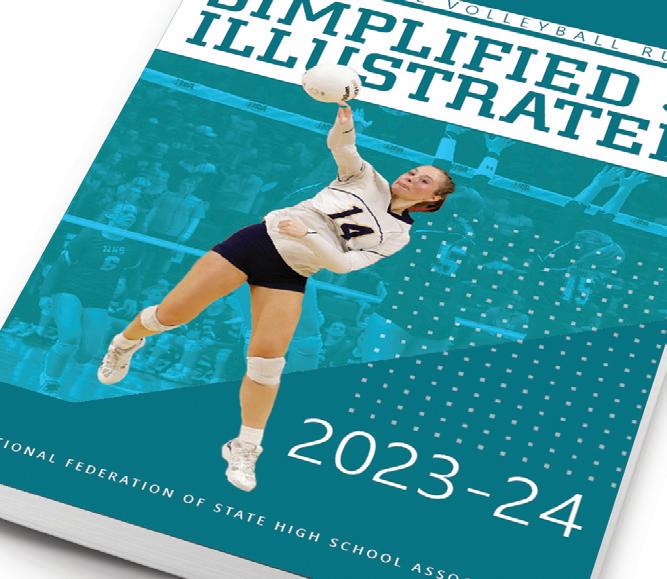
If you are studying the manual by yourself, take notes on practices and procedures that you need to polish. Several officials make a timeline or cheat sheet to make sure they are performing the mechanics and

procedures correctly. If studying with a friend, quiz each other on procedures or timeline of events. The more the correct procedures are reviewed, the more an official can focus on the match rather than the items in the manual.
Summary



Being a great official involves many variables. Some say you need to have a certain look or have the “it” factor. Others talk about the officials who are consistent and have a great personality. These variables or characteristics can be debatable when considering which makes an official great. However, one indisputable characteristic of a great official is one possesses the knowledge and ability to properly apply rules and procedures. This is the measuring stick by which all officials are measured. Robert Doan, Ph.D., has been a high school, college and USAV official for more than a decade. He is a resident of Charleston County, S.C.
LEARN VOLLEYBALL RULES FAST & EASY


Volleyball’s
illustrations. $1595 STORE. /VOLLEYBALL $350
most complicated rules are explained in everyday language and
reinforced with 100s of
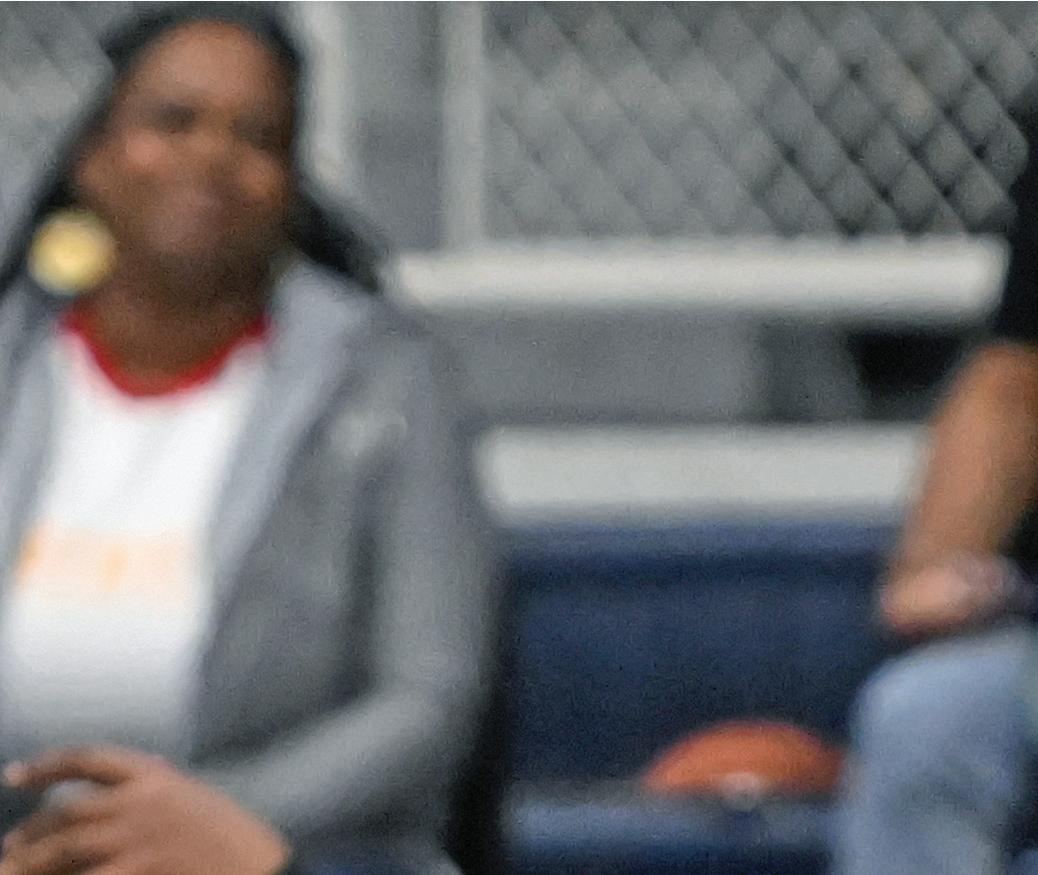


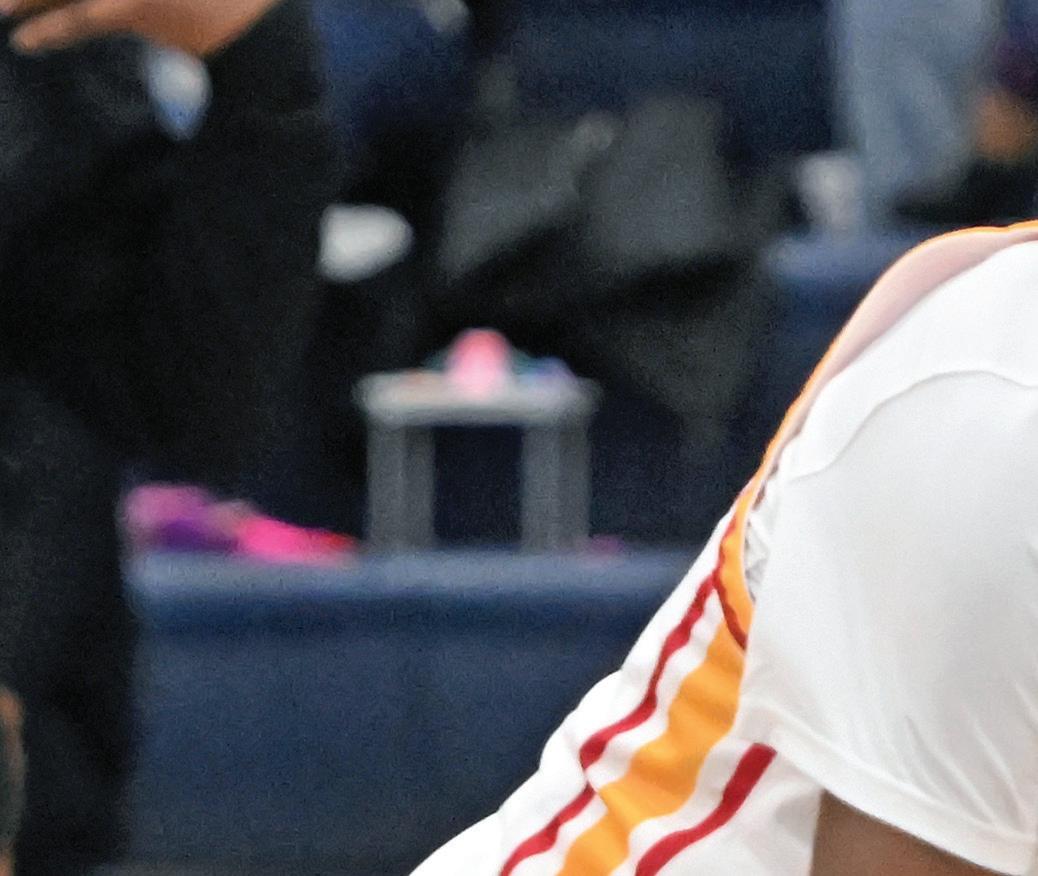

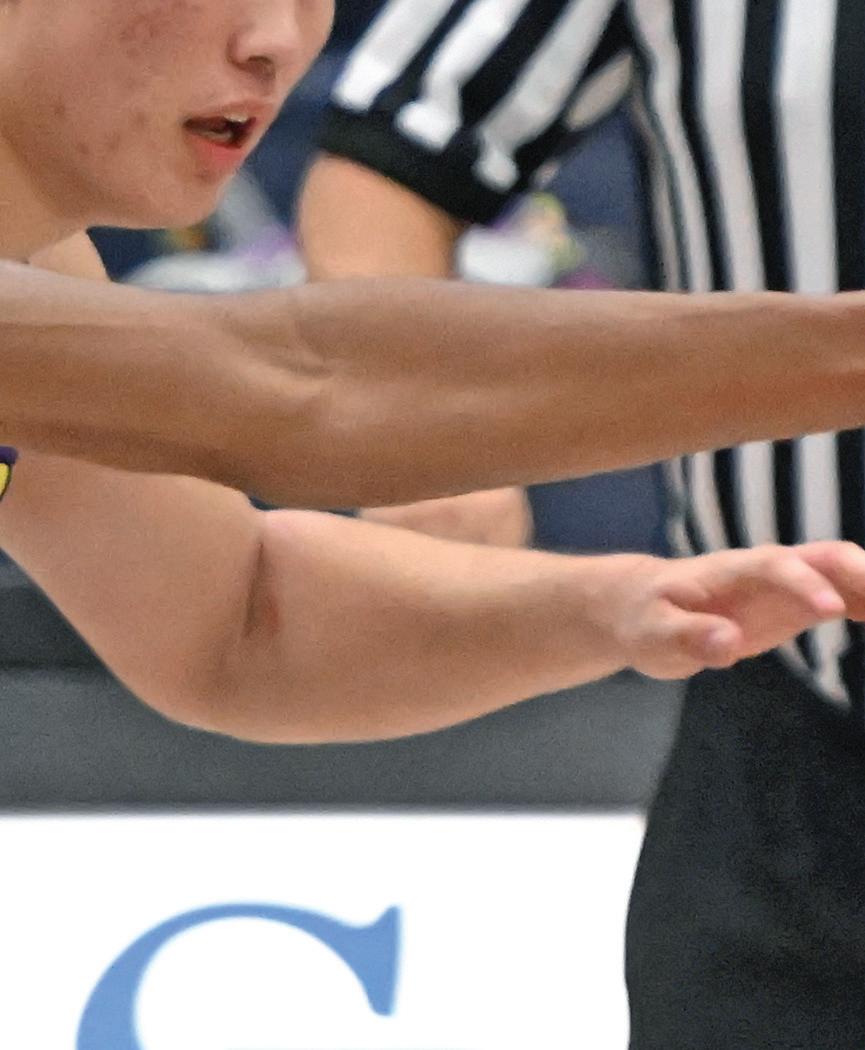









| REFEREE July 2023
WAYS TO GET BACK IN THE ZONE







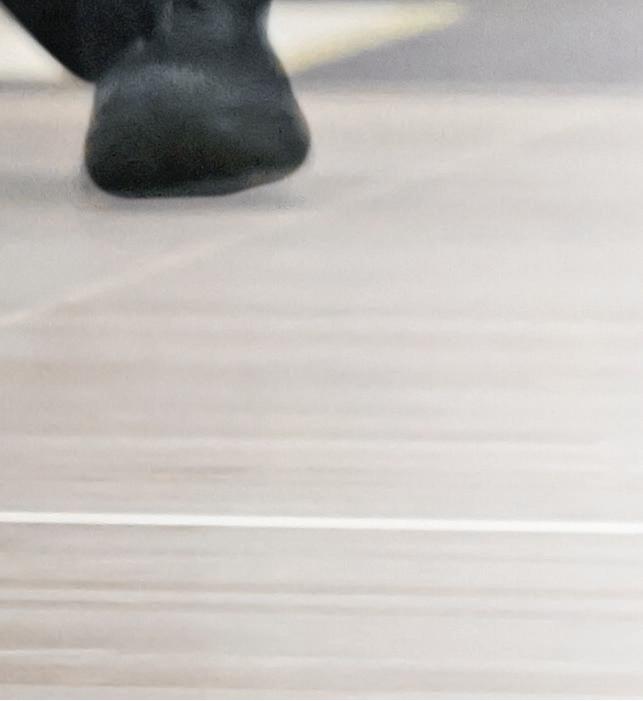

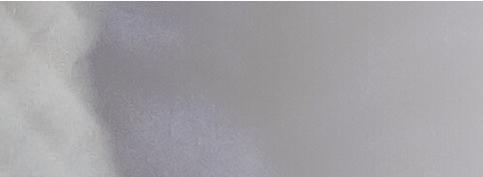

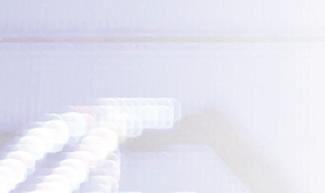






Readjusting After the Unexpected




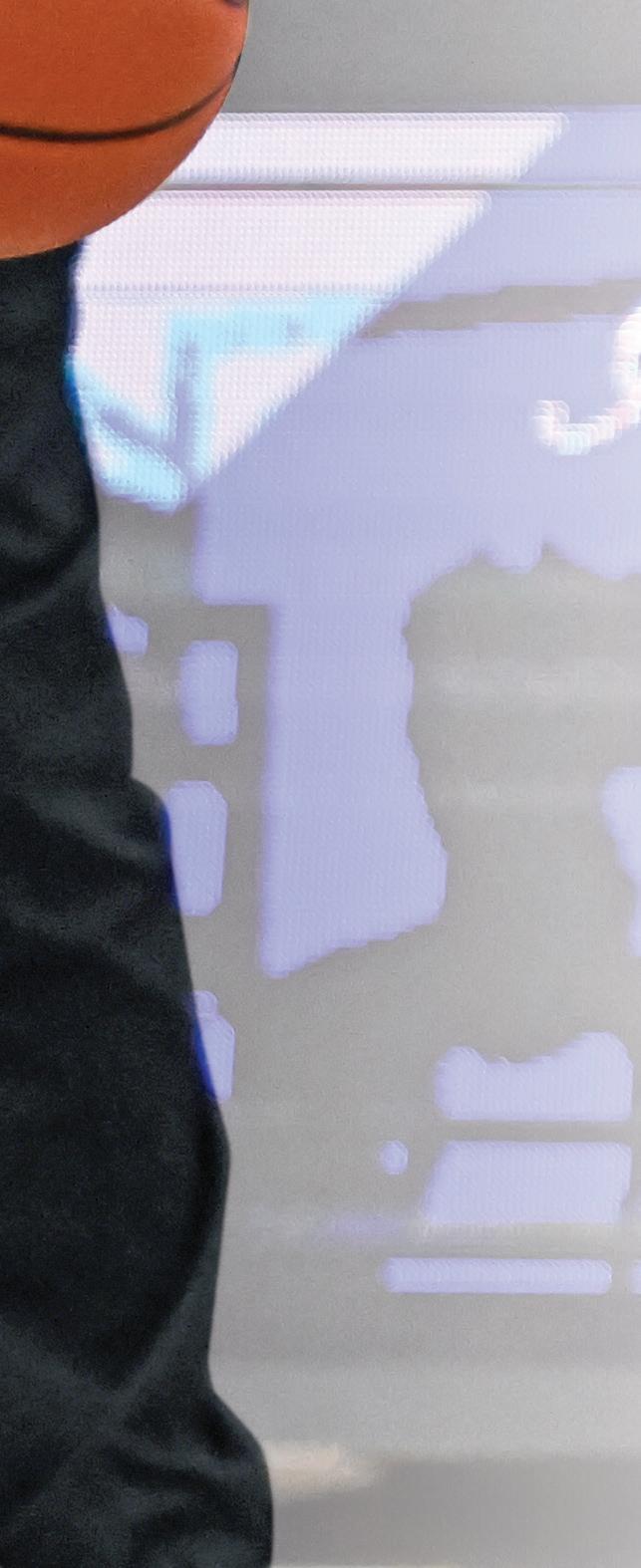







 BY PETER SACCO
BY PETER SACCO
Touse a baseball expression, “sometimes life will throw you a curveball” is perhaps the most appropriate way to lead into this article. After all, this is a magazine dedicated to sports of all sorts, including baseball and softball for all the umpires reading along. Back to the “curveball” for just a moment — as a batter, what happens when you are guessing fastball and you get a curveball instead? You are usually left standing frozen at the plate. When the unexpected happens, it can throw timing completely out of whack. This is especially true in the world of officiating. Have you ever been in a situation where you were officiating a game, things were
running along smoothly and all of a sudden things went to pot? Clock or equipment malfunctions, you blow a call, athletes or coaches start a squabble and it leads to a full-out brawl, or maybe one of the teams does something totally unexpected? You can honestly tell yourself, “I didn’t see that coming, but where do I go from here?” The task at hand becomes all about getting things back on track and doing what you were expected to do, which is facilitate to the best of your abilities. How do you get back into your officiating routine when what transpired was anything but routine? It is all about “getting into the zone.”
REFEREE July 2023 | 39
7
When the unexpected occurs, George Arredondo, Whittier, Calif., must have the focus and concentration necessary to react appropriately to the new situation presented.
7WAYS TO GET BACK IN THE ZONE
to take direct control and inventory over your thoughts. When anxious or negative thoughts flow into your mind, you quickly identify them and remove them before they can take root and lead you to spiral into more anxious cycles of thoughts. Mental toughness is “taking your thoughts captive” as you control your thoughts.
Get Back Into the Rhythm
Getting into the zone means getting into your mind’s eye and living in the moment. You have to shift your focus from what just happened into what is happening in the here and now. Whenever you get into the zone, you are feeling the moment with the entirety of your senses as they become highly focused. Most successful artists, athletes and professionals from all walks of life have this ability to get into the zone, as they rely on their tunnel vision to help them tune out everything else around them so they can give 100 percent of their attention to the task at hand. Referees and sporting officials are no different!
Getting back into the rhythm of the game or “the zone” requires one to shift his or her mindset into one of greater concentration and focus. Interestingly, concentration and focus are not one and the same. Whenever you focus on something it places your utmost attention on it, while conversely concentration is honing
the skills developed in your mindset to do what you have to do. Concentration and focus are both processes that, when applied together, allow you to master your circumstances — the game you are currently officiating. Focus relies on dedication, placing your mind on the event or situation you most want to center your attention on. Concentration comes from discipline and practice, from doing something repetitiously until your mind can automatically shift to the skill set you have learned to complete a task in the most efficient and successful way. Just as you were able to facilitate the match that was running smoothly, because you have conditioned yourself to do so, you can prepare your mind to deal with things that go less than smoothly.
Tap Into Mental Toughness
The key to success in overcoming uncontrollable situations in the sporting arena is to tap into your own mental toughness. Mental toughness is the ability

To become “mentally tough” you have to become aware of your continual thinking pattern. This means you have to monitor your “self-talk,” which is what you are telling yourself at any given moment in time. In this case, what are you telling yourself when all hell breaks loose in a game that was once progressing along smoothly? We all speak to ourselves in microseconds when we see images that project our thoughts. It is our perceptions of the events that lead these images to create our thoughts. Negative perceptions will create negative images in our minds, which will in turn perpetuate negative thought patterns. Conversely, positive perceptions will lead to positive images, which will lead to positive thoughts. It is the positive side of the coin (your positive self-talk) that leads to mental toughness.
Supercharge Your Focus
One of the things you can quickly do to get back into the flow and get re-focused on your officiating so the rest of the contest isn’t disrupted is to “supercharge” your focus. Emotions are the most powerful element when it comes to drawing or keeping our attention on something. This statement has never been more accurate when it comes to emotion and focus. Emotions supercharge
40 | REFEREE July 2023
HESTON QUAN
1 2 3
When adversity strikes, the best thing football official Glenn Inigo, San Diego, can do is find a way to mentally get back into the rhythm of his performance and not allow one negative moment to take him out of the “zone.”
your thoughts — they add power and life to them. What you focus on the most — your thoughts, where your mind often wanders to — is where your energy will be channeled toward. You first need to see the end result that you desire — getting the game you are officiating back on track, and getting everyone to buy into it. Since you are the facilitator, you are like a maestro leading an orchestra. All of the players and coaches will follow your lead and hopefully fall into unison. It is up to you to “maestro” the match back into unison. Everyone will follow your lead and this comes from demonstrating confidence in your ability to reset the game because you are using your mental toughness. See the ending of the match going forward (the way you would like to see it conclude) and develop a way to get to that ending.
Avoid Over-thinking
One of the traps many officials get caught up in when things go wrong is to start overthinking and play the “blame game” with others or themselves. Sometimes you have to let go of what happened and stop trying to figure things out or to make perfect sense of what happened. That is the past and you need to move your mindset into the present so you can progress forward in your competition. The first way to overcome overthinking so much is to get rid of that dirty word “why” at the start of all of your questions. In fact, stop asking yourself so many questions, especially ones that require definitive, exact answers that for all intents and purposes do not have any definitive answers in the first
place. It sounds so simple, but it is so difficult for so many to let go of the “why’s.” When you are tempted to “why” yourself — “Why do there have to be technical malfunctions?” “Why are these players arguing and fighting?” “Why is the coach acting like a jerk?” — then you just have to respond, “So what? I can’t control them, I can only control how I move this game forward!” Things happen and sometimes there is no “why,” so get over it and blow your whistle and march onward and forward.
Keep Emotions Off Your Face
When things go bad during a game, it is best to be as “poker faced” as possible. By keeping emotions and expressions in check, it offers you an advantage in that others can’t “read” you. Have you ever heard of the expression, “Never let them see you sweat”? If the game you are officiating encounters the unexpected, this mental state has never been more true, figuratively and literally! If others can’t read you, they
can’t manipulate you in terms of guiding the conversation, or asking more intense questions that would truly reveal what you are thinking. If they can’t read and manipulate you, then you appear in complete control. Players and coaches will respond to your lead, which is all about facilitating and controlling perceived outcomes.

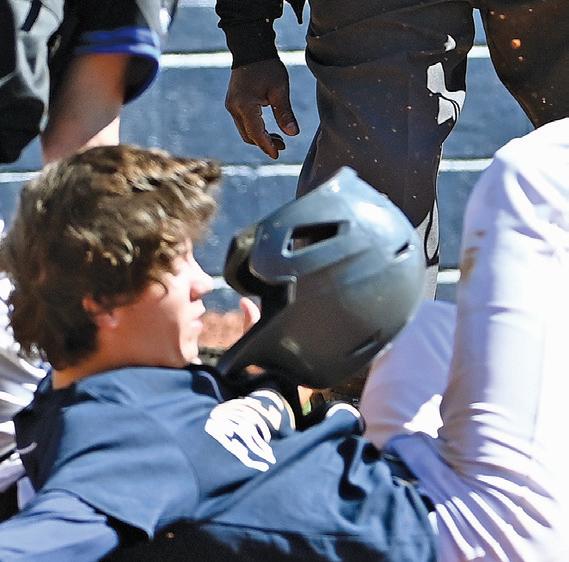



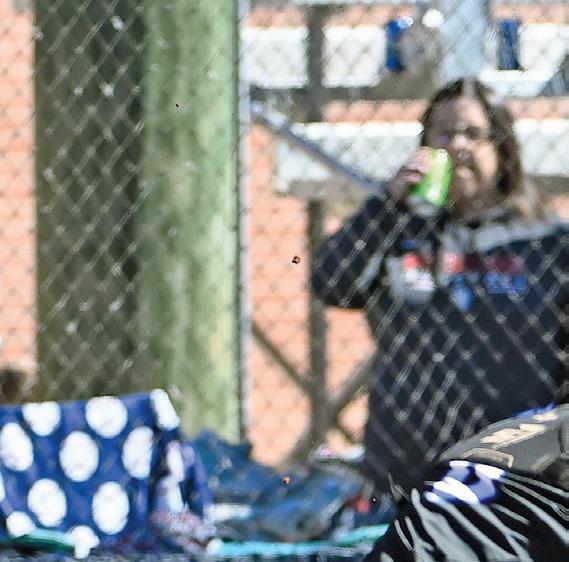
Avoid Expectations
It is difficult to “expect” people and situations to go a certain way, as there will always be glitches and hiccups. When you create expectations for yourself based on how others will act and react, you are setting yourself up for greater frustration and disappointment when they do not go as planned. We live in a technological age where things are bound to go wrong. We live in the same age where there are people who have emotions and express them. When they act or react a way that goes against what you had hoped for, rather than expected, it is easier to reel things in versus if you were hell-bent on expecting them to
REFEREE July 2023 | 41 KEN KASSENS
4 5 6
Umpire Alan Banks, Whiteville, N.C., sees the play and then renders a decision. That is the only thing he can control. If his ruling draws a negative reaction, the next thing he can control is his own response to those reactions.
7WAYS TO GET BACK IN THE ZONE
act out the way you wanted them to in your perfectly scripted game or match.
Time to Readjust
Once the original disappointment, or in some cases, “shell shock” wears off, it is time to get the game back in order and it is time to blow your own whistle. There are some quick and easy strategies you can use to put things back in order.
You need to own your own thoughts. Always remember you have the right to think whatever you want and no one can think for you. Coaches, players or colleagues might start telling you what to do, or how you should act, but this is all on you. The truest mark of mental toughness is learning to think for yourself.
Many of us are influenced by what others tell us, even though this is not how we would think, act or react for ourselves. You can’t let this influence your officiating, especially as things are unfolding on the playing field. At the end of the game, you have to live with yourself, what you think and the decisions you made. Make decisions based on the thoughts you choose.
Always try to keep things in proper perspective. Too many officials get caught up in the heat of the moment and create “end of the world” mentalities when something goes wrong in their matches, and further compound things after making knee-jerk decisions. Everyone makes mistakes, even the best officials with the best mental toughness components. Mental toughness is about keeping things in perspective and then moving on. Do not let mistakes define you or dictate your current or future matches.
Always do your best to live in the present moment
Just as these soccer players will continually adjust their plan of attack throughout a match, referee Alexandria Goodrich, Logan, Utah, must be prepared to do the same from a mental perspective depending on what transpires during the competition.

and present match. Always remember, the only thing you are in control of is the present moment. Thinking and rehashing past mistakes or outcomes in games won’t change things or what has happened. You can only focus on what you are thinking about in the present moment.
Try to focus on the positives. There have to be things you have done well in your game up to that point. You didn’t get as far as you are in officiating because you made a ton of mistakes and never learned from them. If you are going to focus on anything, focus on your successes and achievements. Use them as inspiration and motivation to move you toward readjusting the situation.
Always deal with any officiating mistakes in a more positive manner. To be successful, you need to overcome your mistakes, avoid perceiving them as failures and view them as learning experiences. The key is to re-define and label these
obstacles as minor setbacks or learning experiences. Use them as opportunities to change the way you think and act, as well as demonstrate to other officials, players, coaches and fans that you can facilitate whatever comes your way. Getting back in the zone takes practice and experiences that place you often in a baptism-by-fire learning curve. The mind learns success through mental rehearsal which creates both a sense of mastery and optimism in completing the tasks at hand. When the actual event or task occurs, the mind is able to switch over to auto pilot and bring you into a more focused, relaxed, confident and eager mindset. You are able to set the game back on its proper course!
Dr. Peter Sacco, Ph.D., of Niagara Falls, Ontario, is a university professor, freelance writer, psychotherapist and author of several books including What’s Your Anger Type?
42 | REFEREE July 2023
BOB MESSINA 7

ONE TOO MANY IFAB
Rule Change Clarifies Extra Person on the Field
By John Van de Vaarst
For the 2023-24 season, the IFAB has made nine changes/clarifications to the Laws of the Game. These changes were made March 4 at the annual general business meeting in London. The changes/clarifications provide additional information on the Laws of the Game and the match officials.
Law 3 − The Players
The first change is a clarification to Law 3 and provides guidance on what to do if the referee realizes there was an extra player on the field and a goal was scored. “If, after a goal is scored, the referee realizes, before play restarts, that an extra person was on the field of play when the goal was scored, and that the person interfered with play …” The new words (shown in italics) clarify the referee should only take action against an extra person on the field if that person interfered with or affected the play. The Law does not expect the referee to punish a team if an extra player merely encroached on to the field during the normal course of play and did not impact the play.

Play 1: An extra player for team A enters the field on the defensive side of the halfway line. While the player is on the field, A3 shoots and scores. Ruling 1: The extra player is to be removed from the field and the goal would count since A3 did not interfere with the play.
Law 6 − Other Match Officials
The fifth paragraph of Law 6 has been amended to provide more responsibility to the reserve assistant referee. Previously, the reserve assistant referee did not have the power to assist the referee with offenses when having a clearer view than the referee. The words “with the exception of the reserve assistant referee” have been deleted from Law 6 so the reserve assistant referees now can assist in
44 | REFEREE July 2023 COORDINATOR: JOHN VAN DE VAARST jvandevaarst@referee.com SOCCER RULES, MECHANICS, PHILOSOPHY
DALE GARVEY
The 2023-24 IFAB rule changes provide guidance on how to handle an extra player entering the field and a goal is scored.
these matters and have the same powers as the other “onfield” officials.
Law 7 − The Duration of the Match
The referee keeps the time for matches played under the Laws of the Game. Law 7 provides the referee with the responsibility to add time during the half for time lost due to substitutions, injuries, etc. After a goal is scored, there could be significant time lost due to celebrations. Previously, adding time for this was covered under “any other cause …” The adding of time for goal celebrations is now listed as a separate item under Law 7.
Law 10 − Determining the Outcome of a Match
The phrase “kicks from the penalty mark” has become outdated and rarely used. Based on this, Law 10 has been modified to remove that wording and is replaced with penalties (penalty shoot-out). This change has been made throughout Law 10 wherever the phrase “kicks from the penalty mark” was previously used. This change also impacts Law 2.2, 3.5, 5.3, 12.3, Glossary, and Practical Guidelines for Match Officials. It is important to remember IFAB Laws differ from NFHS and NCAA rules regarding cautions issued to players and coaches during the match. Under IFAB Laws, these cautions do carry over to the penalties (penalty shoot-out).
Law 11 − Offside
Wording that was published in the IFAB’s Circular 26 (July 2022) has now been incorporated into Law 11. This wording clarifies the guidelines that distinguish between deliberate play and deflection. These distinctions clarify whether an attacker in an offside position should be declared offside and be penalized when receiving a ball that comes from a defender.
The new language is as follows: “A player in an offside position receiving a ball from an opponent who deliberately played the ball, including a deliberate handball, is not considered to have gained an advantage, unless it was a deliberate save by any opponent.”
Deliberate play (excluding deliberate handball) is when a player has control of the ball with the possibility of:
•Passing the ball to a teammate;
•Gaining possession of the ball; or
•Clearing the ball (e.g., by kicking or heading it).
If the pass, attempt to gain possession or clearance by the player in control of the ball is inaccurate or unsuccessful, this does not negate the fact the player deliberately played the ball.
The following criteria should be used, as appropriate, as indicators a player was in control of the ball and, as a result, can be considered to have deliberately played the ball:
•The ball traveled from a distance and the player had a clear view of it.
•The ball was not moving quickly.
•The direction of the ball was not unexpected.
•The player had time to coordinate their body movement, i.e., it was not a case of instinctive stretching or jumping, or a movement that achieved limited contact/control.
•A ball moving on the ground is easier to play than a ball in the air.
Play 2: A3 passes the ball toward A2, who is in an offside position. B3 attempts to intercept the pass with an outstretched leg. The ball deflects off B3’s leg and goes to A2. Ruling 2: A2 is offside since an advantage was gained by being in that position and B3 did not make a deliberate play on the ball.
Play 3 : A3 takes a shot on goal. Defender B2 runs in front of the goal and clears the ball off the goalline with a head ball. The ball goes to A4, who was in an offside position at the time of the shot. Ruling 3: A4 is declared offside since this was a deliberate save by an opponent.
Play 4: A3 attempts to pass the ball forward to A2, who is in an offside position. B4 intercepts the pass and attempts to play the ball to B3. A2 moves toward the ball and gains possession. Ruling 4: A2 is not ruled offside since B4 made a deliberate play on the ball.
Law 12 − Fouls and Misconduct
Law 12.3 provides several examples of what is considered to be
DID YOU KNOW?
Prudencio “Pete” Garcia (18991984) was the first American to serve as an official at the World Cup. He served as a linesman in four matches — two in the group stages and two in the final group — at the 1950 World Cup held in Brazil. Garcia was born in Spain and emigrated to the United States as a child. He refereed in the Municipal League of St. Louis from 1937-57 and founded the Missouri Referees Association. He was inducted into the National Soccer Hall of Fame in 1964.
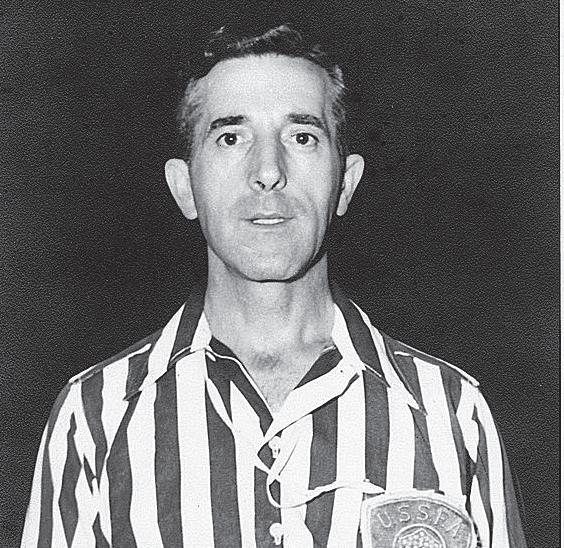
SOURCE:
DID YOU KNOW?
The halftime interval may be shortened in NCAA and NFHS matches by mutual consent of the coaches. Under IFAB, it can be shortened if players of both teams agree. This option may be helpful for matches starting late and the potential of loss of daylight.
SURVEY SAYS
How often do you use your mobile device or tablet for pre/postgame meetings with fellow officials?
REFEREE July 2023 | 45
NATIONAL SOCCER HALL OF FAME
... Always 65% 25% 7
3% Sometimes Never Frequently
SOCCER OFFICIALS ANSWERING THE 2017 NASO NATIONAL OFFICIATING SURVEY
%
SOURCE:
TEST YOURSELF
In each of the following, decide which answer or answers are correct for NFHS, NCAA or IFAB rules/Laws. Solutions: p. 85
1. A2, in the attacking area, with back to the goal, has the ball. A2 passes the ball back to A3, who dribbles past A2 toward the goal.
a. A2 is offside since A2 was ahead of the ball at the time of the pass.
b. A3 is offside upon receiving the pass.
c. There is no offside and play continues.
2. B2 challenges A3 from behind with a tackle in a reckless manner.
a. Direct free kick for team A.
b. Red card issued to B2 for tackle from the rear.
c. Yellow card to B2 for reckless tackle.
3. Goalkeeper B1 controls the ball with the hands just at the edge of the goal area and goalline. After possession is taken, A3 nudges B1, who stumbles over the goalline.
a. Award a corner kick.
b. Award a free kick for team B since the goalkeeper had possession.
c. Caution A3 and award a free kick for team B.
4. A2 is fouled by B3 in a reckless manner. The referee cautions B3 for the foul. Just as the caution is administered, A2 takes the free kick and scores.
a. No goal since the referee did not indicate the restart of play. Kick is retaken.
b. No goal; caution A2 for taking the kick.
c. Goal since team A was ready to restart play.
5. Team A is awarded an indirect free kick just outside the penalty area. The referee raises the hand above the head and keeps it raised as the kick is taken and shot directly into the goal.
a. Award the goal.
b. No goal and retake the kick since the ball did not touch a second player.
c. No goal. Award a goal kick for team B.
unsporting behavior and a cautionable offense. Additional wording has been included to provide clarification to one of these examples. “Commits any other offense which interferes with or stops a promising attack except where the referee awards a penalty kick for an offense which was an attempt to play the ball or a challenge for the ball.”
The same words are added to Denying a Goal Scoring Opportunity (DOGSO). “Where a player commits an offense against an opponent within their own penalty area which denies an opponent an obvious goal scoring opportunity, the referee awards a penalty kick, the offender is cautioned if the offense was an attempt to play the ball or a challenge for the ball. In all other circumstances (e.g., handling, pulling, pushing, no possibility to play the ball, etc.), the offending player must be sent off. This text was added since it is not always clear whether there was an attempt to play the ball or challenge for the ball.
Additional text has also been added to deal with team officials. “Where an offense is committed by someone from the technical area (substitute, substituted player, sentoff player or team official) and the offender cannot be identified the senior team coach present in the technical area will receive the caution.”
Play 5: The referee hears dissent coming from the team bench. The referee cannot identify who is making the remarks. Ruling 5: The referee will stop play and administer a caution to the senior coach in the technical area.
Law 14 − The Penalty Kick
Additional text has been added to the procedures for taking of a penalty kick. Law 14 has revised wording for the requirements of the defending
goalkeeper: “The defending goalkeeper must remain on the goalline, facing the kicker, between the goal posts, until the ball is kicked. The goalkeeper must not behave in a way that unfairly distracts the kicker, e.g., delay the taking of the kick or touch the goal posts, crossbar or goal net.”
Play 6: The kicker is ready to proceed with the penalty kick. The goalkeeper moves off the goalline with an arm extended moving toward the kicker as if to shake the kicker’s hand. Ruling: The referee must stop the goalkeeper and sanction the player for delaying the kick.
Video Assistant Referee Protocol
The last change is in the Video Assistant Referee (VAR) protocol 3. Practices has amended text: “The use of VARs during a match involves the following practical arrangement:
•The VAR watches the match in the video operations room (VOR) assisted by one or more assistant VARs (AVAR).” The replay operator has been omitted in this section.
•“Depending on the number of camera angles (and other considerations) there may be more than one AVAR and one or more replay operators (ROs).”
It is important every official not only keep up with the changes to the Laws of the Game but also be a student of the Law book. Officials should be thoroughly familiar with all the Laws. This will prevent confusion or misapplication when an unusual circumstance occurs on the field of play.
John Van de Vaarst, Ellicott City, Md., is a NISOA National Clinician, National Assessor and former State Level USSF Referee and Assessor. He is Referee’s soccer coordinator.
NFHS Announces 2023-24 Points of Emphasis
Each year the NFHS Soccer Rules Committee incorporates points of emphasis into the rulebook. These items are considered important for
coaches, players, administrators and referees. For the 2023-24 season, the committee included four points of emphasis: wearable technology,
SOCCER 46 | REFEREE July 2023
coaching and team area decorum, denying an obvious goal scoring opportunity, and substitutions.
Wearable technology. Wearable technology is becoming more available at all levels of soccer. These items measure various aspects of the player’s performance including training, in-game performance and recovery after an injury. They monitor such things as heart rate, blood pressure, and pace and distance traveled. This technology transmits and receives data so the athlete’s performance can be evaluated and, if necessary, adjusted based on the information received. It is legal to wear these monitoring devices under the uniform or on the shoe. They may not be worn on the arm or below the level of the shoulder. Referees are not to be confused with rule 4-1-1 that indicates “with the exception of socks, equipment shall not be modified from its original manufactured state. …” The adding of wearable technology to the shoe does not modify the shoe and is legal.
Coaching and team area decorum. Displaying good sporting behavior has always been critical in interscholastic soccer. This point of emphasis reinforces the need for coaches, bench personnel and players to exhibit proper behavior. The high school soccer field is an extension of the classroom and all participants’ behavior must be at an acceptable level. A positive, open line of communication between officials and coaches ultimately results in a better contest for everyone involved. Inappropriate bench behavior shows a clear lack of respect. Several examples of unacceptable bench behavior include but are not limited to:
•Kicking or throwing objects in reaction to a decision (as shown in the PlayPic).
•Entering the field of play to dissent a call or confront an official or player.
•Acting in a provocative or inflammatory manner.
•Arguing calls consistently.
•Engaging in a verbal or physical confrontation with the opposing coaching staff or players.
•Confronting or arguing with spectators. Referees must be able to distinguish between a sudden outburst in the heat of the game versus unacceptable behavior and manage it appropriately. It is important for referees to always act in a professional manner. While coaching and team area decorum is a point of emphasis, it does not mean the referee should be looking for reasons to caution or disqualify a coach, substitute or bench personnel. Referees should use their people management skills to try to defuse any situations prior to the use of a card. Developing an “us vs. them” mentality when dealing with coaches or players does not normally improve the situation, but usually escalates the problem. Approaching the bench in a calm, professional manner and explaining the problem to the coach and advising that the behavior must change is a good first step.
Denying an Obvious Goal Scoring Opportunity (DOGSO). The NFHS Soccer Rules Committee has provided several items for the referee to consider when determining if a red card is appropriate for DOGSO.

When considering if a player is to be disqualified for DOGSO, the following four criteria must all be present.
1.Distance between the offense and the goal (the closer the foul is to the goal, the more likely it is an obvious goal scoring opportunity).
2.General direction of play (the attacker must have been moving toward the goal at the time the foul was committed).
3.Likelihood of keeping or gaining control of the ball (the attacker must have been close enough to the ball at the time of the foul to have played or continued playing the ball).

4.Location and number of defenders (not more than one defender between the foul and the goal, not counting the defender who committed the foul).
When considering the criteria above here are some questions to ask yourself:
•Where does the offense occur on the field?
•Did the foul occur inside or outside the penalty area?
•What is the distance between the offense and the goal?
•What is the direction of play?
•Does the player have control of the ball?
•Can the player gain control of the ball?
•How many defenders are involved in the situation?
•Where are the defenders located?
•Does the offense lead to a direct free kick or an indirect free kick?
•If no offense were to occur, would the player have an obvious opportunity to score a goal?
•Does the player deliberately handle the ball to deny the opposing team a goal?
•Was the offender attempting to play the ball?
DOGSO is an egregious attempt to prevent opponents from scoring. If any element is missing, the offender cannot be disqualified for DOGSO. All of the above questions should be reviewed by the referee as the decision is made to determine if DOGSO is appropriate. The referee should be in good position when making this decision and sound the whistle in a manner that there is no question about what the referee believes has happened.
The referee must also be aware of what the sanction will be for a DOGSO infraction. If the player commits the offense within their own penalty area and the referee awards a penalty kick, the offender is cautioned if the offense was an
REFEREE July 2023 | 47
CASEPLAYS
Goal Negated
Play: A1 receives a pass in the penalty area and kicks the ball into team B’s goal for an apparent score. After the ball has been kicked and before it enters the goal, A2 pushes B3, who then falls to the ground. The offense occurs on the far side of the penalty area and has no impact on the remaining players and their ability to play the ball. Ruling: No goal and the match is restarted with a direct free kick for team B at the point of the pushing incident (NFHS 12-3; NCAA 12.1.9; IFAB 10.1).
Bait and Switch
Play: A3 shoots on goal and B1, the goalkeeper, saves the ball with the chest and it drops to B1’s feet. B1 keeps the ball there and bends over as if to pick up the ball but does not. B1 merely extends the arms toward the ball and stops short of picking it up. A2 runs toward B1 in an attempt to play the ball. B1 picks up the ball just as A2 arrives. A2 is frustrated by the “baiting” of B1 and violently pushes the goalkeeper to the ground and the ball crosses the goalline. Ruling: A2 is to be ejected for the violent push. The match is restarted with a direct free kick by team B from anywhere inside the goal area (NFHS 12-8-2a; NCAA 12.7.4.1; IFAB 12.3).
By a Hair
Play: A2 is in an offside position just beyond the goal area. A3 has the ball at the edge of the penalty area. A3 shoots on goal and the ball just touches the top of A2’s hair. The ball does not change direction and continues into the goal. Ruling: The offside rule indicates that a player is to be judged offside if the player becomes involved in active play. Since the ball touched A2, A2 is now considered involved. The goal is negated. The match is to be stopped and restarted with an indirect free kick for team B (NFHS 11-1-4; NCAA 11.2.1; IFAB 11.2).
attempt to play the ball. If the offense was holding or pushing and no possibility of playing the ball exists, the offending player must be disqualified.
If the player denies an obvious goal scoring opportunity with a deliberate handling offense, the player is disqualified wherever the offense occurred.
These situations can be highly emotional. The referee must stay calm and professional and advise the player the reason for the yellow or red card. Also, in accordance with rule 5-3-1f, the referee must notify the coach and scorekeeper of the reason for the dismissal. The clock is stopped so the referee does not have to rush through the process. If a word or two of explanation is necessary and will help with the coach’s reaction, the referee should take the time to do so.
Substitutions. The final point of emphasis deals with substitutions. Managing substitutions is one of the many tools an official has to manage the game. Generally, substitutions are made prior to a throw-in, a corner kick, after a goal, at halftime or because of an injury. If a player is being replaced, the player shall exit the field on his or her team bench side unless the player is injured and unable to exit to that side of the field. By exiting on the team bench side, the player does not have to walk in front of stands, behind an opponent’s goal or near an opponent’s bench.
If a player is injured and a team elects to play shorthanded while the injured player is being evaluated, this is a coach’s choice. Injured players may be attended to anywhere off the playing field, but if the player is cleared to play, they must re-enter from the official’s area on the bench side of the field when beckoned by the referee.
The requirement of having the substitute exit the field on the bench side eliminates several potential problems for the referee. If the player was to leave on the far side of the field and walk behind the opponent’s goal, there could be words exchanged with the goalkeeper. This is not only poor sportsmanship but
could also distract the goalkeeper during an attacking situation. Also, if a player exits from this side of the field the referee or assistant referee on the far side of the field may confuse this player with a field player when judging offside. This could result in an inadvertent whistle or a player who is offside not being penalized because it was thought the substituted player was the second-to-the-last defender.
If substituted players are allowed to exit the field near the goalline, they could be passing by the opponent’s bench when returning to their bench area. This could result in inappropriate comments between the substitute and bench players or even the possibility of a physical altercation. This is another reason why this point of emphasis on where the substitute is to leave the field is important.
Substitution management is a duty of the officials assigned to the game. If there is an assistant referee, that individual should ensure the proper number of players exit and enter the game. Also, the players must be at the official’s area prior to the substitution request. If two officials are assigned, the referee closest to the officials’ area must manage the substitutes. If there are multiple players exiting and entering the game, take a moment to count the players on the field prior to the restart to prevent any problems.
If an injured player is being attended to off the field, but on the far side, one of the referees or an assistant referee must be aware when the player is returning to the bench side to be part of the substitutes or prepare to re-enter. Again, there should be no dialogue with the opposing goalkeeper when going past the goal area.
The points of emphasis are incorporated into the rulebook because the rules committee members feel they are critical to the success of the season. All referees must be very aware of these items and use their professional judgment when interpreting and enforcing them in a professional manner.
48 | REFEREE July 2023 SOCCER
VISIONINACTION




Join the Sportsmanship Discussion

You’re invited to the premier officiating event of the year. Gather, talk, and engage with fellow officials July 30–Aug. 1 in Riverside, Calif., at the Riverside Convention Center. The theme for this year’s event is “Good Sports, Bad Sports, Better Sports Through Officiating.” Delve into discussions about sportsmanship at all levels as well as the effect it has on officials and officiating.
Behavior issues arise from players, coaches, and most often parents. Poor sportsmanship is the leading cause of current national official shortage. It has a negative impact on both recruiting new officials and on retaining existing ones. Survey after survey confirms that. In fact, 70 percent of all officials quit within the first three years.








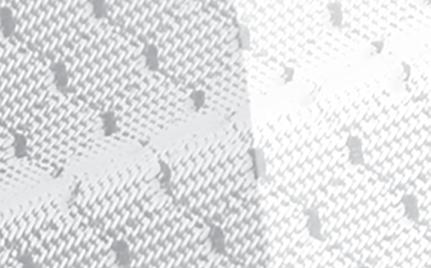

Your voice is needed to add to the cutting-edge discussions that will take place on-site at the Summit. There are questions: What is the official’s role? How does poor sporting behavior impact our games? How does it impact our industry? You’ll be part of coming up with the answers. This year’s attendees will experience real-world efforts to combat bad behavior in our games and be the first to see the latest data on the state of officiating in 2023.
Sessions scheduled for the 2023 Summit include:

• 2023 Officiating Survey Powered by Referee. com - 35,000 officials had something to say. The results premier exclusively here in a


WE’RE ALL IN THIS TOGETHER!
THESE ORGANIZATIONS SUPPORT OFFICIALS
concise and coherent manner.
• Sports is Life with the Volume Turned Up - A critical focus on understanding and surviving today’s officiating environment.
• Too Few Of Us - A strategic approach to getting more officials. Learn about factors that play a role in the shortage of officials.


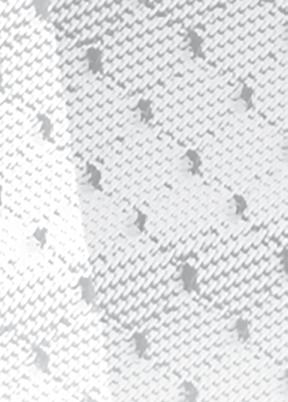
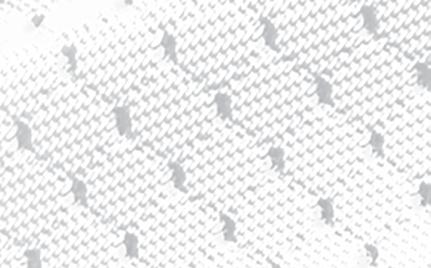
• Sportsmanship They’re Doing Something About it - Who’s doing what to tackle the sportsmanship problem? Real stories, real solutions.
• Innovation by Invitation


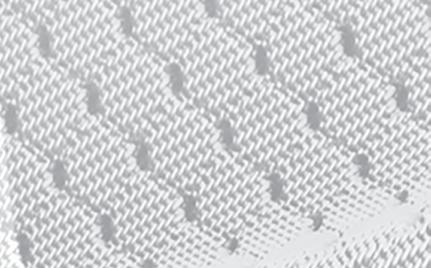
– Cutting edge technology, programs, experiments and research all rapid-fired in four-minute segments. You won’t want to miss this one!
The annual Sports Officiating Summit is the only event of its kind addressing critical topics impacting all aspects of the officiating industry. Leaders of state high school officiating programs, local association officers, supervisors, and coordinators, assigners, conference administrators, and sports officials at all levels from around the country and the world benefit from the critical discussions and breakouts. Every year, nearly 500 leaders and decision-makers attend the summit.
Make plans now to attend the 2023 Sports Officiating Summit in Riverside. Go to www. sportsofficiatingsummit.com or call the NASO offices at 1-800-733-6100 to register today.
ATTENTION REFEREE MAGAZINE SUBSCRIBERS

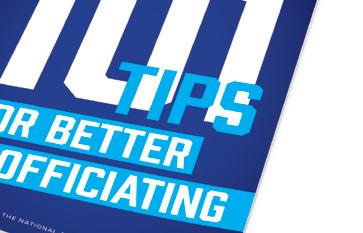

It’s time to join the rest of us in the National Association of Sports O cials. Not only will you continue to receive the world’s #1 o ciating publication, you’ll enjoy all of the additional benefits NASO members enjoy.
Go to naso.org/upgrade2023 to join NASO for the special introductory price of $114 and receive these two FREE books!

NATIONAL ASSOCIATION OF SPORTS
OFFICIALS
FOR NASO MEMBERSHIP INFORMATION OR TO SIGN UP, GO TO NASO.ORG, CALL 262-632-5448 OR EMAIL CSERVICE@NASO.ORG
$ 114 JOIN TODAY
DISCRETION DECISIONS
Certain Base Awards Involve Your Judgment Only
By George Demetriou
The rules are fairly explicit on explaining the number of bases to award and the point of origin of the award. The amount of the award can be anywhere from one to four bases, with a three-base award extremely rare. The starting point for the award can be the last base occupied either at the time of the pitch, or at the time of the throw or other illegal act.
There are two types of plays (and a third in NFHS) when the script can be ditched and the number of bases to be awarded is at the umpire’s
discretion. There are no limits on the awards for obstruction or spectator interference and there is not always a minimum award. Umpires must thoroughly understand the parameters with which they have to work.
Except where noted, the material applies equally to NFHS, NCAA and pro rules.
Spectator Interference
When a spectator or any other individual intentionally interferes with any thrown or batted ball, the ball is dead at the moment of
interference and the umpire shall impose such penalties as will nullify the act of interference.
The definition of a spectator is somewhat obvious, but the rule also applies to personnel who are authorized to be on the field and intentionally interfere. Those include coaches in uniform, athletic trainers, team managers, bat persons and authorized home attendants including security personnel (NFHS 2-21-3, 5.1.1K; NCAA 4-7; pro 4.07a). Photographers and other media personnel can be treated as either authorized personnel or spectators
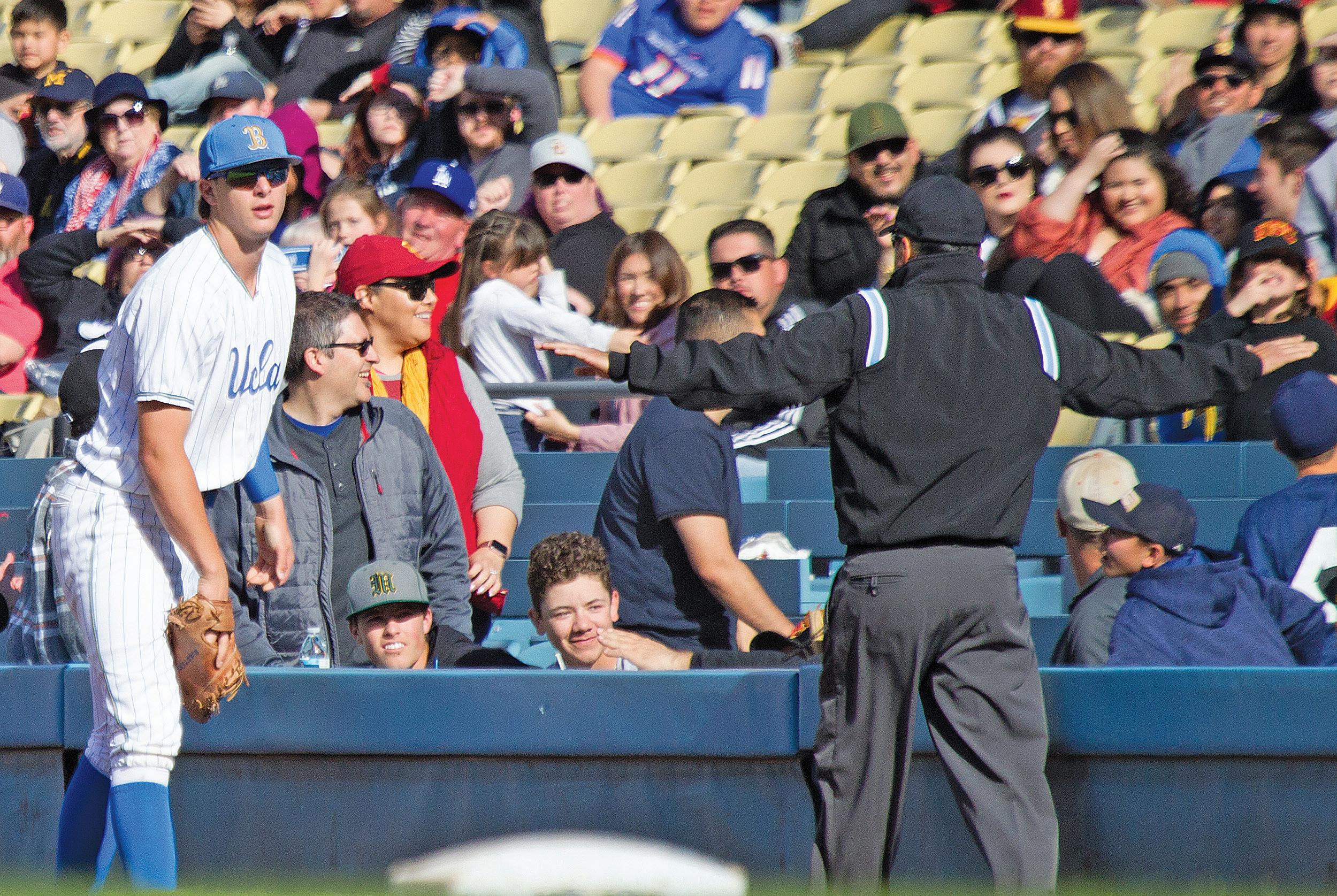
50 | REFEREE July 2023
BOB MESSINA
BASEBALL RULES, MECHANICS, PHILOSOPHY EDITOR: SCOTT TITTRINGTON stittrington@referee.com
First-base umpire Alex Ortiz, Highland Park, Calif., rules there is no spectator interference on this play. Had Ortiz ruled there was interference, the umpiring crew would use its discretion to determine any necessary base awards.
depending upon where they are located. In NCAA and pro play, media personnel are treated as authorized personnel only if they are in the area they are “authorized” to be (NCAA 4-7; pro Evans interp). In NFHS play, media must be confined to a dead-ball area which may be added to accommodate them (1-2-8).







Interference can include a spectator reaching out of the stands, or going on the playing field and touching a live ball. Obstructing the vision of a fielder, throwing objects at him or pouring liquids on him is also likely interference. For authorized personnel, it is intentional interference if they field, kick or push a ball, regardless of possible motives (NFHS 5-1-1f3, 8-3-3e; NCAA 4-8a1, 6-4a, 8-3n; pro 6.01e).
If such personnel are inadvertently touched by the ball or their contact with a player does not alter the play, the ball remains live and in play. Examples include a base coach, bat person, etc., who tries to evade the ball but it touches the individual or touches such a person without their being aware the ball was coming.
As mentioned, when interference occurs, the umpire must use judgment to nullify the effect of the act. Runners should be placed where they would have been had the interference not occurred. In making this determination, the umpire should evaluate the speed of the runner, the position of the nearest fielder and the location of the runner at the moment of interference. The umpire’s decision need not necessarily be a base award and base awards do not have to be the same for all runners.
Play 1: With a runner on third and one out, B3 hits (a) a fly ball deep to left near the fence, or (b) a popup just past the dugout. A spectator interferes with the catch. Ruling 1: The umpire should declare B1 out on the interference. In (a), if the umpire judges R3 could have tagged and scored, he will award home to R3. In (b), R3 remains at third.
Obstruction
The umpire’s discretion on obstruction awards differs slightly

from spectator interference in that a minimum award of at least one base beyond the base last legally touched before the obstruction may apply. Obstruction is the act of a fielder who impedes the progress of a runner. Contact is not a prerequisite (NFHS 2-22-1; NCAA 2-55; pro Obstruction Definition).
Under NFHS rules, obstruction is always a delayed dead ball and play is allowed to continue until all action ends (5-1-2b). In NCAA and pro play, obstruction is also a delayed dead ball if the runner is not being played on, but the ball is immediately dead and the play is stopped if the obstructed runner is being directly played on (NCAA 2-55, 6-3c, 6-3d, 8-3e; pro 6.01h2).
In NFHS play, an obstructed runner is always awarded a minimum of one base beyond the base last touched legally before the obstruction (8-3-2). Under NCAA and pro rules, the same applies, but only if a play was being made on the runner (NCAA 8-3e1 Pen.; pro 6.01h1). If a play was not being made on the runner, there is no minimum award that must be made. The runner is awarded any base(s) justified to nullify the act of obstruction, which means the bases they would have reached, in the umpire’s judgment, if there had been no obstruction. In cases when the batter-runner is obstructed before reaching first base, it’s possible for an obstructed runner to not receive any award (NCAA 8-3e1 Pen.; pro MLBUM II-62).
In determining what base(s) a runner will be awarded, the umpire should consider the position of the ball and the fielder, and the speed and position of the runner at the moment the obstruction occurs. However, the ultimate decision in awarding bases should not be made until all play has ceased and is to be based on the principle the obstructed runner is entitled to the base he would have reached had no obstruction occurred.
If a play is subsequently made on the obstructed runner (after the umpire allows play to continue) and such play results in the runner being tagged out before reaching the base
SURVEY SAYS ...
Do you like the move by MLB to make permanent the rule that starts extra innings with a runner on second base?
35% Yes No
64%

RESPONDENTS
DID YOU KNOW?
Umpire Ron Kulpa will live in the history books as the umpire responsible for the first ejection of an MLB player related to the new pitch clock rules instituted for the 2023 season.
The ejection happened April 4 following a violation by San Diego’s Manny Machado that resulted in a third strike against the Padres third baseman. Kulpa ruled Machado, who was in the batter’s box but fidgeting with his batting gloves and equipment, was not alert to Arizona pitcher Zac Gallen in time, and assessed the third strike.
Machado was visibly upset with the ruling and after a brief argument, Kulpa ejected him from the game. San Diego manager Bob Melvin came onto the field to argue and was also ejected.
THEY SAID IT
“I wouldn’t be here without the Academy. That’s where it all started — my passion, my love of baseball, the discipline. The moment you step in there, you become attached to a higher standard.”
— Malachi Moore, the first graduate of MLB’s Compton Youth Academy to be hired to the league’s full-time umpiring staff
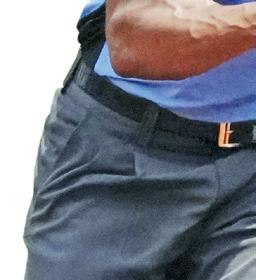
SOURCE: USTIMESPORTS. COM

BILL GREENBLATT/UPI/NEWSCOM
SOURCE: REFEREE TWITTER POLL OF 122
TEST YOURSELF
In each question, decide which answer is correct for NFHS, NCAA or pro rules. Solutions: p. 85
1. With R1 on first base and R2 on second, B4 gets a base hit. R2 is held up by the third-base coach as he rounds third trying to score. He slips as he tries to stop, contacts the third-base coach, then gets up and scrambles back to third. The umpire judges the contact was accidental.
a. The coach did not physically assist the runner when the contact is accidental. The ball is live and in play.
b. The coach is guilty of physically assisting the runner. The ball is dead immediately and R2 is declared out. All other runners return to the last legally touched base at the time of the interference.
c. The coach is guilty of physically assisting the runner. It is a delayed dead ball. After the play, R2 is declared out and the other runners remain at the bases they obtained during the play.
d. The coach is guilty of physically assisting the runner. The ball is dead immediately, R2 is declared out and other runners are awarded the base they would have obtained had interference not occurred.
2. With no outs, R1 attempts to steal second base. B2 hits a fly ball to left field that is caught. R1 misses second base on his way to third. While returning to first base to properly tag up, R1 touches second on his way by. When the ball comes into the infield, the defense throws the ball to second base and appeals R1 missed it.
a. R1 is out on appeal for missing the base his first time by.
b. R1 is not out since he touched second his last time by.
3. When an improper batter reaches first base, he becomes a proper batter and the results of his time at bat become legal when no appeal has been made and:
a. A pitch or illegal pitch has been delivered to the succeeding batter.
b. An intentional base on balls has occurred.
c. All the infielders left the diamond if the half-inning has ended.
d. All of the above.
he would have been awarded, the umpire does not call time until all other playing action has ceased. The runner must continue to “do what he is supposed to do.” If he does not, or if an obstructed runner subsequently commits a baserunning infraction (most likely a missed base), the umpire should be guided by the closeness of the play and the amount of delay caused by the obstruction. If the runner advances beyond the base he would have been awarded, he does so at his own risk. If he is subsequently tagged out, the umpire must determine whether the obstruction had any bearing on the out. If not, the out shall stand despite the obstruction. Any preceding runners, forced to advance by the award of bases as the penalty for obstruction, may be advanced.
Malicious Contact
In NFHS only, there is a specific rule banning malicious contact by either offensive or defensive players. If a fielder intentionally uses excessive force on an opponent such as delivering a blow to the head during a tag, the ball is immediately dead and the umpire will award the runners the bases the umpire judges they would have obtained had the malicious contact not occurred. In practice, such contact is most likely to occur on a tag play and if the runner was out on the play, the call would stand and the fielder would be ejected. Any runners who were not attempting to advance are not awarded any bases (3-3-1m, 8.3.3O). George Demetriou, Colorado Springs, Colo., is the state’s rules interpreter.

Cash in on the Correct Clinic
By Alex Skandalis
Not another mandatory requirement. These are feelings we have all had when faced with the thought of continuing education in the officiating,
52 | REFEREE July 2023 BASEBALL
Not another clinic. Not another training. Not another meeting.
DALE GARVEY
When choosing an umpiring camp clinic, there are several factors to consider, such as the student-to-teacher ratio and whether there is going to be instruction or game evaluation only. Here, Greg Olmstead, Sammamish, Wash., leads a cage session for a small group of umpires.
If we first acknowledge we must do continuing education, our second step is realizing we must advocate for ourselves and find our own path to improvement through serious introspection, not simply
get pushed or leveraged into certain courses by those in power, including coordinators, assigners and those running associations. There are many great umpire training opportunities for umpires of all levels. There are people of all umpiring backgrounds and levels willing to spend their time making you a better umpire. The people who take the time to put on clinics, teach at clinics and put valuable information on Facebook, Instagram, YouTube and even TikTok analyzing plays or starting high-level discussions should all be commended. These are time-consuming activities, typically with little or no reward other than making the umpire community better.
I encourage every umpire to deeply consider your individual umpiring abilities — the level you are at, the level you want to be at, the level you think you could be at — and evaluate clinic options across the board before deciding what continuing
education is best for you. Take a clinic through a virtual interview in your mind and consider all the following and more before deciding which is best for you and why.
Training vs. Live Game Evaluations








How much of a clinic is simply working games versus a structured curriculum of training supplemented with games? Which one are you looking for and why? Both are great tools and have their place, but know which you are attending to maximize your learning experience. If you are going to a “game only” clinic, make sure you have a high-level understanding of the system in which the games are being worked, for your own good and also for the good of those other umpires trying to get evaluated for higher-level baseball.
Innings

If I am trying to be get evaluated, how many innings am I actually
Longtime MLB umpire Sam Holbrook brings his years of onfield and umpire school experience to this new video focusing on the mechanics that will take you to the next level in your umpiring career. LEARN MORE STORE. /baseball
the mechanics that
$2495
and specifically the umpiring, field. Continuing education is necessary and beneficial to individual umpires and the preservation of our game because like anything else, our game and our profession evolve. Would you want to hire a lawyer who didn’t complete continuing legal educuation courses or an accountant who didn’t complete continuing professional education courses? As someone who worked in the accounting field and has lived with a lawyer for several years, I understand the task of completing continuing education becomes daunting and tedious if you choose an inappropriate course, something that will not challenge you, or something that is too far over your head. To that end, let’s explore how this applies to umpiring.
CASEPLAYS
Balk Accepted
Play: With the bases loaded and one out, F1 balks as he delivers the first pitch to B5. B5 hits a fly ball that is caught. All runners tag and advance after the catch. R3 scores, but R2 goes for an extra base and is out at the plate. Ruling: In NFHS, the ball is dead immediately and the balk is enforced with B5 remaining at the plate. In NCAA and pro, the balk is also enforced because the batter-runner did not advance one base. There is no option (NFHS 5-1-1k; NCAA 9-3 Pen. 1 & Pen. 3 Note 1; pro 6.02a Pen.).
Number of Trips
Play: In the top of the first inning, team A’s coach comes out to the mound to visit his pitcher. After a brief chat, the coach departs, making it halfway to the foul line before turning around and returning to the mound for further discussion. Ruling: In NFHS, one conference is charged. A conference is not concluded until the coach crosses the foul line on his way back to the dugout (3-4-3). In NCAA and pro, two conferences are charged. A conference is concluded when the coach leaves the dirt portion of the mound (NCAA 9-4a1, 9-4d; pro 5.10l).
Distance Matters
Play: B1’s swinging bunt bounces high in front of the plate near the first-base line. F2 fields and throws the ball while B1 is running with both feet inside the foul line about 30 feet from the plate. The throw is wildly high and well inside the line to a spot where F3 has no chance to make the play. Ruling: Interference cannot be called in this situation unless it is intentional; the runner’s lane begins at the 45-foot mark (NFHS 8-4-1g; NCAA 7-11p; pro 5.09a11).
Late Walk
Play: In the fourth inning, B2 comes to the plate. After the first pitch, the defensive coach yells from the dugout for B2 to receive an intentional walk. Ruling: Legal play, the award can be made anytime during the at bat (NFHS 2-4-3; NCAA 2-7, 8-2b; pro 5.05b1 Cmt., Base on balls Definition).
working in the clinic environment at each position and how many of those will be in front of the coordinator/ assigner that I want to watch me?
Instructor to Student Ratio
How much individual and smallgroup attention am I getting versus a large lecture group in a classroom or on the field?
Quality of Instruction
Are the leaders and instructors at a particular camp considered to be reputable in the industry?
Technology
Are video or strike zone evaluation tools being used to supplement the training curriculum and improve your ability and accuracy?
Appropriate Geographic Evaluation
Am I getting myself in front of the instructors, evaluators, coordinators and assigners who can help my career? If I live in Nevada, does it make sense for me to travel to a clinic in New Jersey, or would it be better for me to work with and assimilate myself into my local area where I can progress through the high school/JUCO/DIII/D-II/D-I ranks?
Pre-Registration Communication
Is the group running the particular continuing education event willing to spend time with you via phone and email to discuss and answer any questions you might have as you try to determine if the clinic is right for you?
This is just a sample of questions I might ask myself when considering a clinic. I am sure there are other questions that would be important to all of you individually or collectively. Consider all your questions, consider your wants and needs and talk to other umpires, instructors, peers and evaluators. When you have done all of this, you are in a much better position to decide which camp or clinic is best for you.
Here are a few landmines to be cautious of along the way.
Honesty and Self-Reflection
You can ask all the questions in the world, but not accurately assessing your own ability level will render
the answers to all your questions meaningless. If the highest level of baseball you have worked is high school varsity, going to a high-level three- or four-umpire system clinic where coordinators are hiring umpires to mid-major and major NCAA Division I conferences is not the best use of your time and money. Do not skip the advanced two-umpire and the intro to three-umpire clinics because you want to rub elbows with a certain group of instructors or say you went to a certain camp teaching the fourumpire system. There is a process to success — build the foundation of your pyramid and be ready to build slowly and steadily to the point.
Clinic Overload
There is only so much information the brain can process in a short clinic season. Allow time to absorb information, put it into practice and then obtain more education or evaluation opportunities to build on the foundation of your umpiring pyramid. Avoid the temptation, even if in a proper progression, to attend too many camps in one season. Patience is never easy to have when you are trying desperately and frantically to advance, but in the end it will make your understanding of the material more comprehensive and easier to utilize over time.
We are living in a time of uncertainty when finances are tight and opportunities for advancement may not be readily available. Continue to further your umpire education in a way that is advantageous to you as an umpire — be honest with yourselves and I am sure you will find the right path. Remember to achieve excellence and master fundamentals. Demonstrate an ability to work a certain level of game and then work to get to the next one.
It is hard to be honest with yourself; sometimes it’s even harder to make the right decision when you want to achieve the most in the least amount of time. I hope reviewing this article will aid you in this process.
Alex Skandalis is CEO of the United Brand, which coordinates the continuing education and placement of umpires nationwide, ranging from youth baseball through NCAA Division I.
54 | REFEREE July 2023 BASEBALL
5 MINUTES WITH PAUL GUILLIE

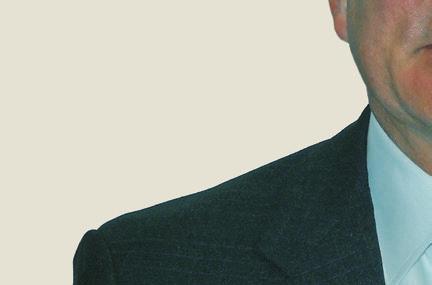
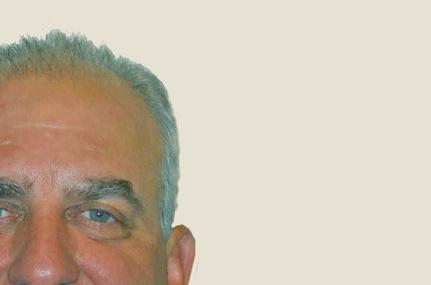

Hometown: New Orleans






















Experience: Coordinator of umpires for the Atlantic Sun, Ohio Valley, Southeastern, Southern and Sun Belt conferences. Spent 24 years as onfield umpire in the SEC.
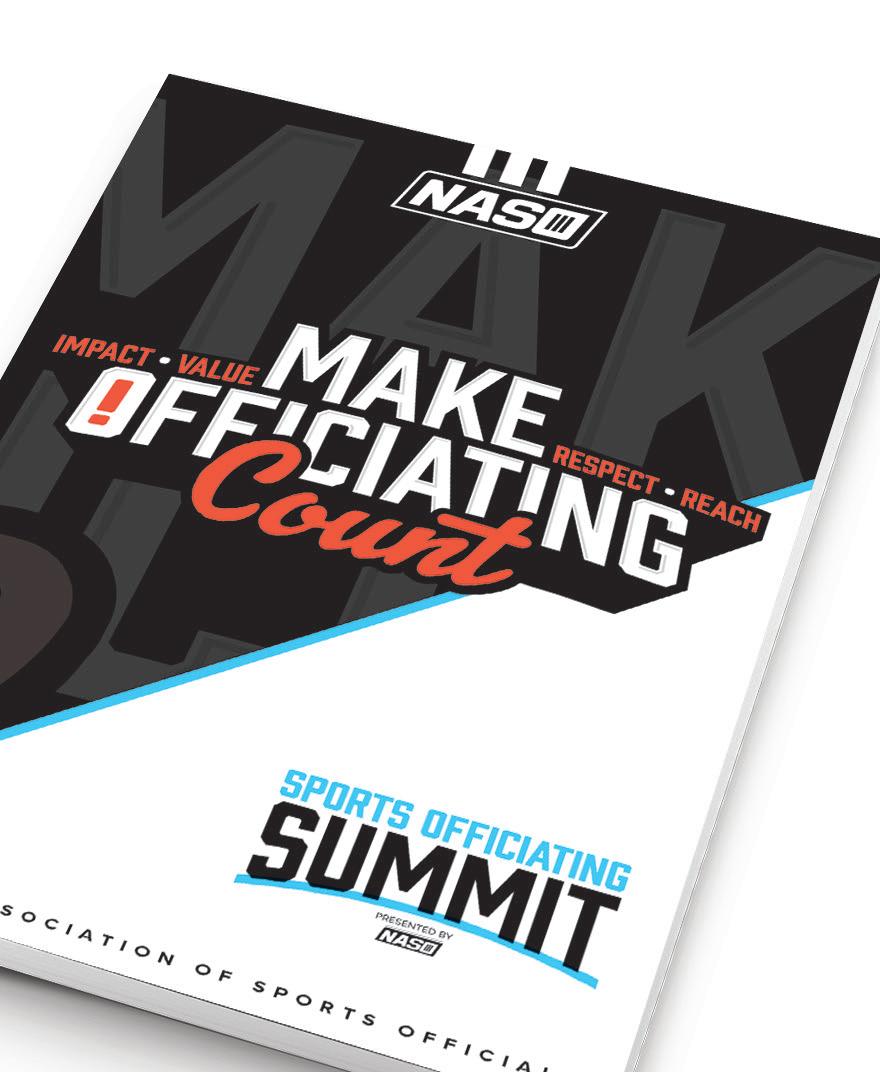
REFEREE: What prompted the decision to start having umpires wear headsets in the Southeastern Conference?
GUILLIE: Just like you’re seeing across the board in the game, it’s all based on pace-of-play initiatives. And everything we’ve tried to do from a conference standpoint, and this has been the direction of Commissioner Greg Sankey, is what can we do to improve the pace of play outside of the normal baseball rules? What can we do in deadball time that improves the pace of play?
REFEREE: Is this season the first that you have used this new technology?
GUILLIE: We experimented with it last year in our conference tournament at the end of the year. Everything associated with video review was onsite already. But the communication directly from the field to the replay center was executed last year at the tournament. So it was a test to see the feasibility within baseball and how it would work.
REFEREE: How is the video review process different using headsets in the SEC compared to what is being employed by other conferences?
GUILLIE: With O2O (official to official communication) we’re trying to eliminate the necessary reason for an onfield huddle unless the review is extremely complex. So that all goes into the stoppage time. If we don’t have to come together, the officials can talk to each other. And, also, what we do in the SEC during conference play, we move to centralized input. So this allows the umpires to communicate directly with the centralized replay center, and replay is already looking at the review and could possibly have an answer when there’s a close play. They’re able to get on top of that review. They’re talking to the crew, and the crew stands directly in their spot. While we may not improve the overall review time, we’re improving the stoppage time.
REFEREE: Is the technology strictly used for video review, or may it be used for other crew communication on the field?

GUILLIE: They can. Obviously, if there’s a particular situation — they want to make sure
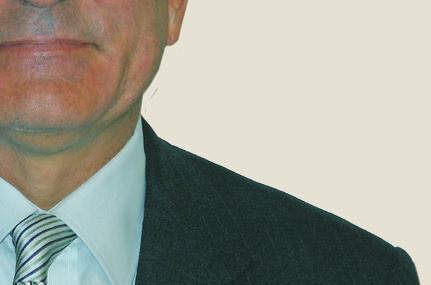
there’s going to be a certain rotation that everybody needs to be aware of, or if there’s a particular ground rule or something as a reminder if this was to happen, that kind of situation, it’s there that they could use it without having to come together and meet. Also, again, the idea of, if we have a play that doesn’t need to go to review but yet it could fall under the getting the play right guidelines in the rulebook, they could talk to each other without having to come together in a huddle.
REFEREE: Take us through the process of a video review using this technology. Who is communicating with the replay center? Is it just the crew chief? The umpire who made the original ruling?
GUILLIE: When the challenge is initiated on the field, the crew chief is the one who initiates the contact with the centralized replay official. And then obviously they have a designated person on the field. And since we’re using centralized replay, we actually use the calling official. Because if there was some additional information that was needed, that calling official could contribute to the conversation. So, those are the two umpires. But all four umpires would hear the review. And then the crew chief or his designee — a lot of times if the crew chief is working the plate, they may not want to carry a two-pack system because we’re now doing public address, we’re doing PA as well — would snap on the button for the public address system. They would announce that the previous play is under video review. When they come back from the review, they click the PA on and say, “After further review” and announce the result. And part of that is just trying to improve the overall fan experience in the stadium. Everybody is getting the result of the play at the same time.
SEC umpire coordinator discusses use of headsets for video review.
COURTESY OF PAUL GUILLIE SOLUTIONS $995 only ORDER TODAY AT STORE.REFEREE.COM/DEVELOPMENT OR CALL 800-733-6100
officiating
is vital not only to the officiating world, but also to the larger sports world. Better officiating
to a more enjoyable experience for the participants and ultimately to the overall improvement of the
*NASO member discount available. $895 * DIGITAL $995 * PRINT $1395 COMBO START HERE
Making
count
leads
game.
GETTING IT RIGHT INSPIRATION, MOTIVATION, ELEVATION
A Signature Moment
By Joe Jarosz
Any basketball official will tell you the season can sometimes feel long by the time March rolls around.
For Jordyn Keeney of Wahoo, Neb., however, the end of this past season felt a little different. She reached the current pinnacle of her young basketball officiating career — coincidentally at Pinnacle Bank Arena in Lincoln, Neb. — March 11 when Freeman defeated Amherst in the Nebraska School
Center court on the campus of the University of Nebraska following her semifinal assignment, she noticed a young fan waiting for an autograph — a seemingly routine occurrence. What was different that evening was the fact the young fan, Jordyn Ropers, was not waiting for a player or coach. She was waiting to get an autograph from the female official who shared her first name.
“It brought a tear to my eye,” Keeney remembers. The request was unique, one very few officials will ever experience.
Keeney’s officiating journey to the high school basketball state championship began in 2015. With some encouragement from her multisport official father, Keeney began officiating as many do — a part-time job to make some extra cash during school. She quickly “caught the bug” and hasn’t looked back.

Keeney currently officiates high school and women’s college basketball.
“There’s not a lot of us (women officials),” she said. “If I can inspire any females to come referee, no matter the age, I want to.”
The family nudge that got Keeney started in officiating has grown into something very special to her. Currently, Keeney’s father and two younger brothers are active officials and she says, “Any time you can spend with family — especially now that we are all adults — and have fun doing it, is amazing.”
‘Crowning Courage’
Retired NBA referee Bob Delaney and Atlanta Hawks principal owner Jami Gertz teamed up to honor more than 150 active duty and military veterans at the seventh annual “Crowning Courage” event March 21. The event was sponsored by Crown Royal and was held at State Farm Arena prior to the Atlanta Hawks-Detroit Pistons game.
Atlanta Hawks season ticket holders donated courtside seats to active duty and retired military personnel. The recipients were greeted by team executives and Hall of Famer Dominique Wilkins prior to the game.
The highlight of the evening took place when Delaney addressed those in attendance and offered insights on leadership, resiliency and self-care. His message was built on experiences as an undercover New Jersey state trooper and a 25-year NBA referee.
SOURCE: NBA.COM
Truth and Reconciliation
The Sault Ste. Marie Football Officials Association undertook the initiative of wearing the Indigenous Logo T-shirts created by Football Canada. The effort was in recognition of the National Day for Truth and Reconciliation, a Canadian holiday established to recognize the legacy of the Canadian Indian residential school system.
The T-shirts were worn in conjunction with games played Sept. 29-30, 2022, and signified the connection of the Sault Ste. Marie football officiating community with the local First Nations — Garden River and Batchewana.
Activities Association (NSAA) Class C2 championship game. With that assignment, Keeney became the first female to officiate an NSAA boys’ basketball state final.
As historic as that championship assignment was, a moment from the day before — during the semifinal round of the tournament series — is what Keeney says she will cherish for as long as she officiates.
As she left the Devaney
As she contemplates her basketball officiating career aspirations, Keeney reflects on the experiences of her young, but already incredibly successful, career. She realizes those moments like she experienced that March weekend in Lincoln don’t come often. As she recalls signing that autograph for an inspired youngster, the emotion in her voice is palpable.
“This is why I do this,” she said. “This is why I officiate.” Joe Jarosz is an assistant editor for Referee
Many young First Nations individuals participate in football programs within the local high schools, and the Sault Ste. Marie Football Officials Association initiative was intended to acknowledge their participation in the sport in conjunction with efforts aimed at reconciliation with First Nations people.
SOURCE: SAULT STE. MARIE FOOTBALL OFFICIALS ASSOCIATION
Have you heard an inspirational or motivational officiating story?
Send your ideas to GettingItRight@referee.com
COURTESY OF NSAA
Jordyn Keeney (left) pauses her postgame routine to autograph a game program for an inspired youngster, Jordyn Ropers.
56 | REFEREE July 2023

CRISIS

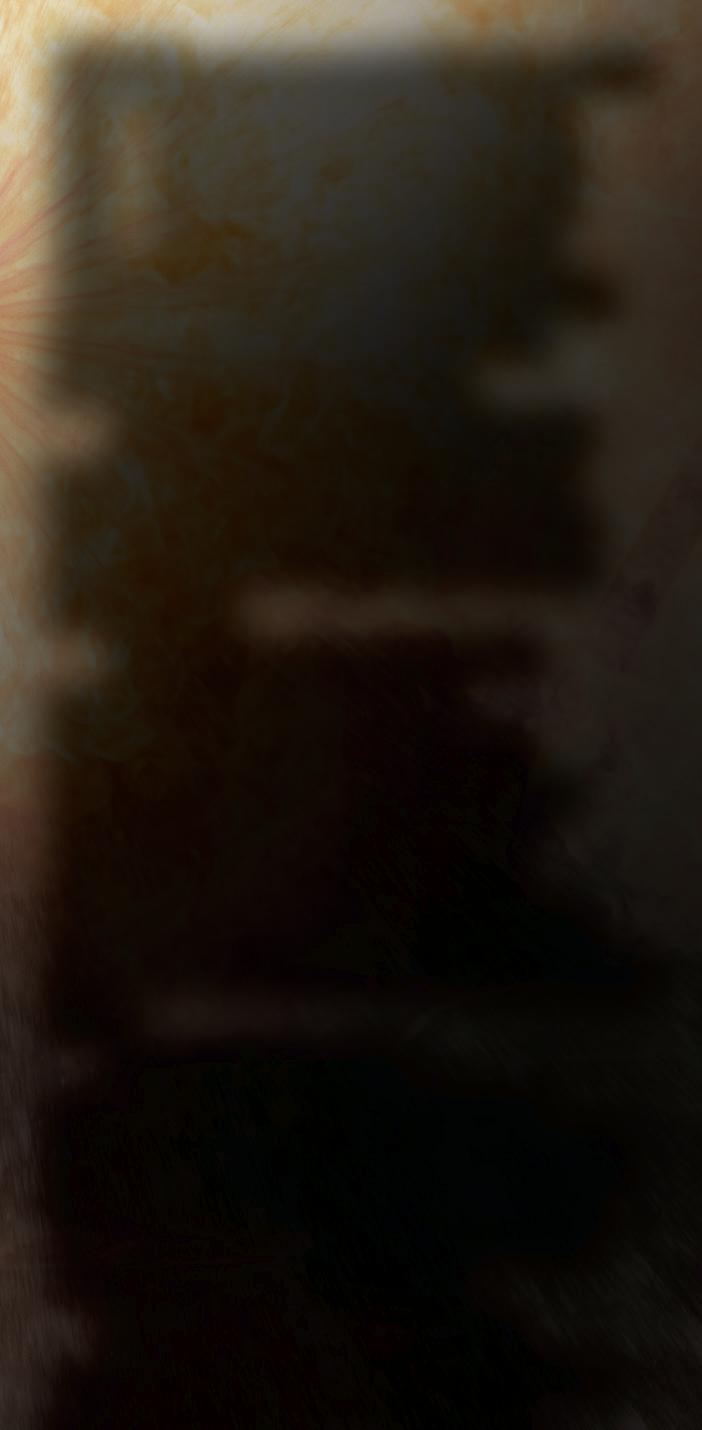
Damage control in the midst of a scandal involving a high school official is a scenario to which no officials association is immune, especially with the immediacy of information available on social media.
As much criticism as officials receive, it can be comforting for them to know their local officials associations often pledge to have their backs.
But do most local officials associations have a crisis management plan in place to deal with toxic situations if they arise? In many cases they do not, often leaving the official and accompanying local officials organization in a less-than-favorable light.


A pair of strategic communication experts share strategies to help officials and their local organizations better navigate through the often uncharted and choppy waters of a crisis.
Roger Harvey, an awardwinning former national television news reporter for nearly two decades, has been on the front lines covering national and international crises. He has shifted his focus to helping clients behind the scenes, working as managing editor of strategic communication at Bose Public Affairs Group in Indianapolis.
SHUTTERSTOCK
58 | REFEREE July 2023
CALLS
BY WADE TURNER
Julia Schultz, a professor in the Strategic Communication Department at Marquette University in Milwaukee, returned to the university-level classroom recently after accruing nearly 20 years of professional experience in marketing agency leadership, public relations and consulting roles.
Whether it be in response to a blown call in a high-profile state tournament game, a racially charged comment allegedly made by an official or accusations of inappropriate conduct by an official with a student-athlete, both experts agree that a response to a crisis from the official’s perspective must be transparent, authentic and done in a timely manner.
“In my opinion, the best approach is to be prepared,” Schultz said. “They say that crises are unpredicted but not unpredictable. It’s always great to have a contingency plan in place so if something happens that’s less than ideal, you’re not left scrambling. You are making sure you are giving an authentic, transparent response while still monitoring the situation and keeping an eye on social media. And research shows that these situations often break over social media since it is available to so many people, so quickly and at any time of the day.”
Harvey said, unfortunately, it’s only a matter of time before
a crisis could happen within an organization.
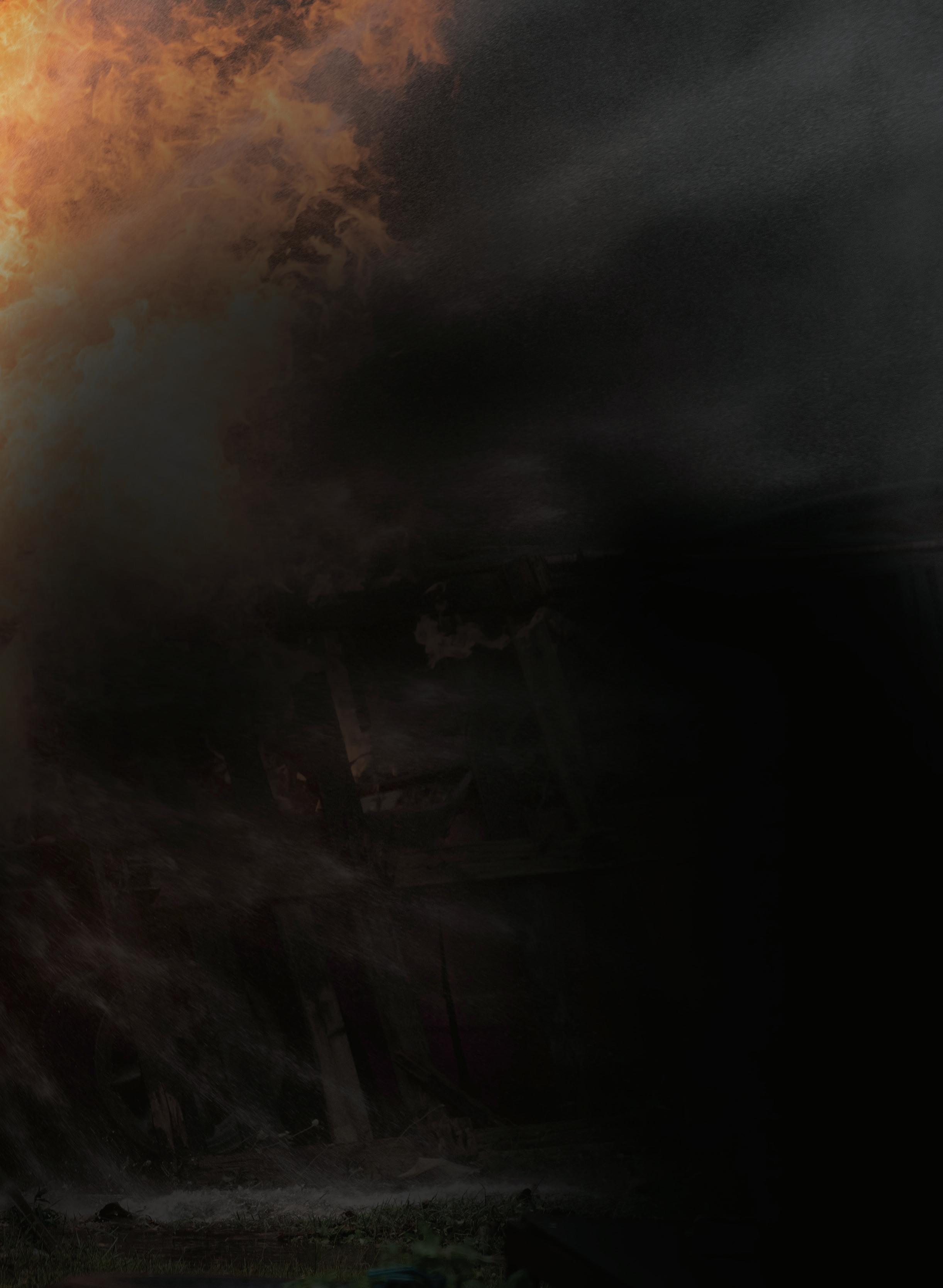
“Transparency is really important and being authentic in what you say,” Harvey said. “You have to be completely honest with people as to what happened. If someone screws up, you need to say, ‘Hey, we’re going to learn from this. We’re going to put protocols into place so we’re going to make sure this doesn’t happen again.’
“What you can’t do is called the half-apology,” Harvey said. “And you see this quite often. ‘I’m sorry if I offended someone.’ You’re saying you’re sorry, but you’re putting the onus on the recipient and it’s their problem that they’re offended. Instead of saying, ‘I’m sorry for what I said. It was inappropriate.’”
“If a crisis does happen, share as much as you are able to with the media,” Schultz said. “And sometimes, that’s not everything. But share what you’re able to share. And make sure the spokesperson is prepared. That preparedness is very important. And make sure you have talked with that person, and everyone knows that all media calls go to that person. You also want to make sure that media requests are done in a timely manner. Putting time frames in your crisis plan is important.
“You cannot also just sit around and wait for everything to be boxed up with a pretty red bow on it,”
Harvey said. “Sometimes you have to get it out quickly, although you may not have all of the facts or elements. But you have to have communication out there. Maybe a person that is a step removed from the official can handle the communication at first. And, if things begin to flesh out a little bit, you could possibly have the official make a statement. But I think it’s better coming from someone else. And it needs to be selected ahead of time. It’s not something in the moment when you look around the room and say who wants to do this.”
Both experts agree a crisis team should be in place but with limited representation.
“As a public relations practitioner, I tend to have people centralize in the organization and keep them to a minimum number,” Schultz said. “I would make sure that is very clear, so when it happens, the referee or official knows what his/her expectations are.”
“The challenge is you can’t have too many people in the committee,” Harvey said. “Then you have paralysis by analysis. You’ve got too many cooks in the kitchen. You’ve got to have a very small group, whatever the association is comfortable with.”
Harvey recommends a local chapter that’s made up of
‘NO COMMENT’ DOESN'T ALWAYS CUT IT ANYMORE, BUT PLAN AHEAD FOR HOW TO BEST WEIGH IN
REFEREE July 2023 | 59
crisis calls
well-known people in the community. “As local as you can go, that will have the most credibility,” Harvey said. “You want to stay as close in geography as you can to where the incident was to have the best connection to the community.”
“Crisis teams may sound intimidating, but it doesn’t have to be anything fancy,” Schultz said, outlining a brief checklist. “Here are the scenarios that might happen, here’s who will respond, here’s what our organization’s key messages will be and tweak as needed.
“I’m not talking about writing a novel for each scenario,” Schultz said. “I’m talking about a plan to
release the key messages. A contingency plan doesn’t have to be difficult. Just get your leadership team together and put pen to paper. Think through these scenarios and you will feel much better from the beginning, knowing that you have a plan in place if you need it.”
“The conversation should not be at the water cooler, ‘Oh, did you see what happened to them; I’m glad it wasn’t us,’” Harvey said. “Let’s look at how they responded. We like what they did here, and this is what they could have done better. Because now, you’re turning what happened in another part of the country into a learning tool for you. I highly recommend that the
core group revisit the plan at least twice per year.”
“It’s important that your plans are current and then just be ready,” Schultz said. “Something that starts out as a small issue, that is not managed or flies under the radar, could become an issue with much more pressure and intensity. Then it will need a response, and that’s when the plan needs to be ready and in place.”
“Whoever is chosen for the spokesperson, make sure they are well-versed on media interviews,” Harvey said. “There is a big difference between traditional media interviews and crisis communication reputation management interviews. I would encourage that spokesperson to have some type of media coaching with scenarios just to make sure they are up to speed.”
While professional and collegiate crisis management teams for officials seem to be fairly well choreographed in public relations, situations at the high school level often leave local associations blindsided when a crisis occurs.

But Schultz said more than 70 percent of the issues that have been brewing end up being a true crisis. “It’s important to rely on environmental scanning,” Schultz said. “This is being aware of different issues that are already in the environment that affect key stakeholders. Always be aware of how other organizations are handling things and be aware of how the public is responding.
“We can never predict everything, but research shows us that most crises don’t just land at your feet out of nowhere,” Schultz said. “Only less than a third are said to come out of
60 | REFEREE July 2023
With proper planning, an officials association can weigh in on crisis situations affecting a member, whether that’s a controversial game situation or accusations of misconduct.
Michael Yousef, Irvine, Calif.
nowhere. There are a handful of scenarios, and if something does happen, it will probably land in on of those sets of scenarios, And if not, at least you’ve got a starting point.”
According to Harvey, organizations must look at the big picture when trying to be proactive about dealing with potential crisis situations. He posits a simple question that doesn't always have a simple answer: “What keeps you up at night? And working from that question, you are able to develop what are the three or four most likely things that could go wrong. You’re never going to be able to come up with every scenario and every combination. But statistically, you will have a good idea of what those three or four are. You try to create what I call a holding statement. When something bad happens, you never want to be staring at a blank computer screen. You want some basic framework of what you’re going to say. And then you just fill in the blanks. So in that first hour, you’ve got something out there.”
Harvey relates the adoption of a crisis management plan to a homeowner’s dilemma on whether to pay for insurance.
“I view it as sump pump coverage on your homeowner’s policy,” Harvey said. “If you’ve never had a flooded basement in your home, you are unlikely to get the sump pump coverage on your home. But if you’ve had a flooded basement, you’ll get that coverage on your home. It’s kind of how I deal with crisis work. Unfortunately, some people will say it will never happen here and don’t see the value because nothing has happened. And all of a sudden it happens, and you’ve got a real problem. Fortunately, more businesses and organizations are
becoming a little more savvy, as they are watching things on TV from across the country. It’s almost like, ‘Whoa, if it happens here, how would we handle that?’ And, that’s a good way to look at this.”
Being proactive with association members regarding their conduct — both on and off the playing field — also “begs the question of expectation-setting,” Schultz said. “Remind your organization members of those expectations that are in play, what behaviors are expected and what is unacceptable. Everyone does better when there are clear expectations. If we are extremely clear with our expectations of our athletes and coaches and administration … and officials, then no one is left wondering whether something is acceptable or not. Those expectations out there are a good first preventative step. Expectations are getting things off on the right track.”
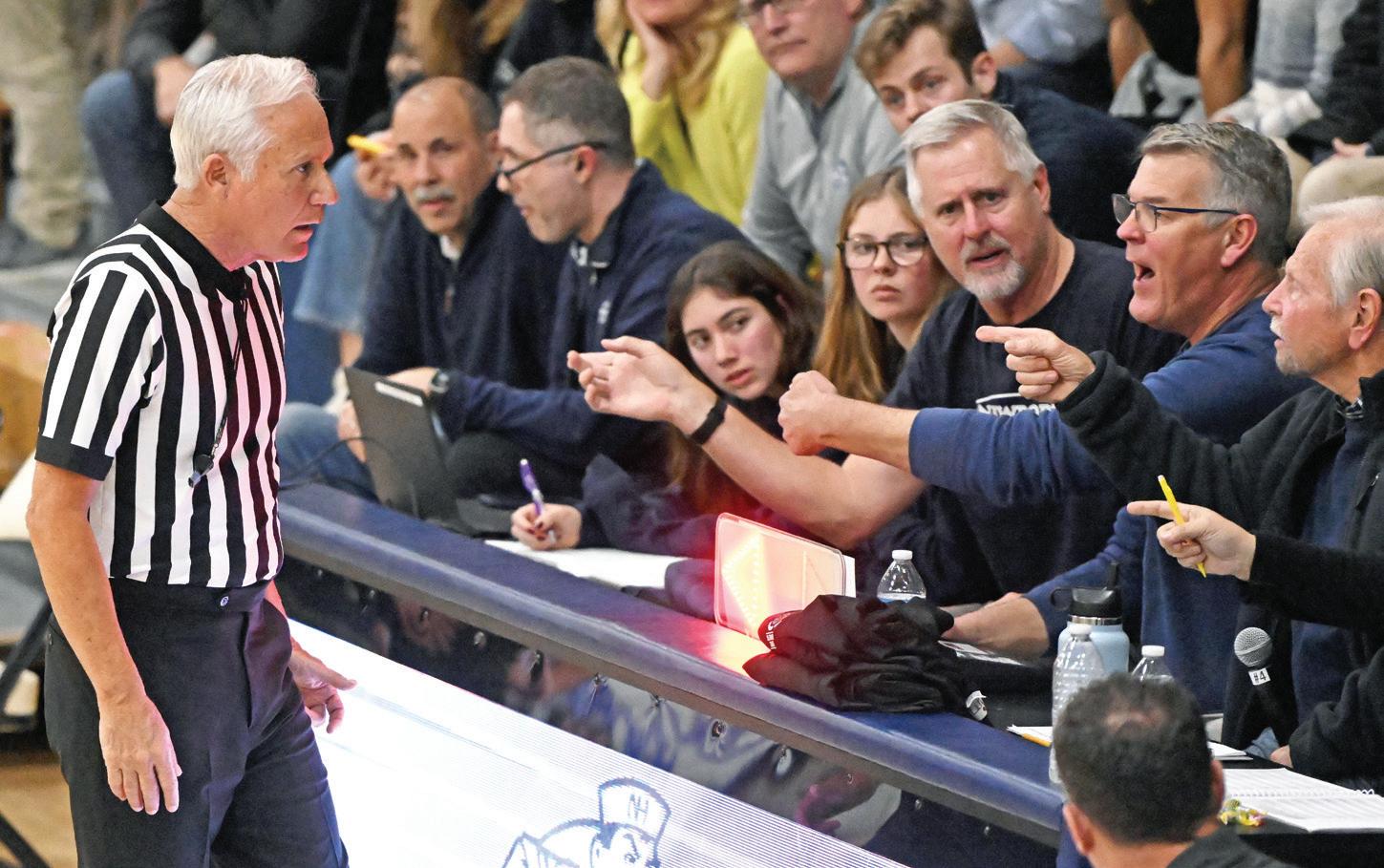
But can silence be the best approach in some high-profile situations? “Normally not,” Schultz said. But according to her husband, an attorney, his response to clients is likely just the opposite of hers, she said with a chuckle.
“Sometimes there is a legal consideration that you are unable to comment on and make sure you tell people that,” Schultz said. “Sometimes it’s a confidentiality issue. If
you feel your association is in the wrong, I don’t think buffering or stonewalling is the best approach. I always err on the side of transparency, authenticity, accuracy and honesty. You may not be able to give all of the information, and you may not have all of the information, and that’s totally fine. I always think it’s better to say something if you’re legally allowed. If not, make sure you let the media know you’re not able to comment.”
"In general, it’s critically important for my client to say something,” Harvey said. “‘No comment’ is just not the way to go,” he said. “In a perfect world there are conversions that take place beforehand. If you’re blindsided, there’s a responsibility to respond and look into whatever that allegation is and determine if there is any factual truth to it. In this day and age, not saying anything is not a good result. You need to respond. Because if you don’t tell your story, one or two things will happen. Either no one’s telling your story, which is bad, or someone misinformed who doesn’t have the facts will tell your story. Either way, those are not good options.”
Wade Turner is a high school football and basketball official from New London, Wis.
REFEREE July 2023 | 61
HESTON QUAN
Things can go wrong that your association may want to address publicly, but it’s important to have a plan for those situations.
Chris Aragon, Viejo, Calif.
GOT YOU COVERED Be Prepared When Dealing with Tarps
By Brad Tittrington
If you live in a warm-weather climate or do the majority of your games in local parks or on turf fields, you may never have had to deal with tarps. However, if you work in the Northeast, Midwest or on all-dirt infields, you may come across tarps every game you work. It is important for umpires to know the rules regarding tarps to make sure to rule on plays involving them properly.

Ideally, tarps should be stored off the field and out of play. However, many schools and stadiums have the tarp located down one of the foul lines up against the out-of-play fence. In these situations, it is important to walk the field before the game and see what the crew will have to deal with in case a ball is batted or thrown down into that area. It is also important to bring the tarp up during the pregame conference with coaches so everyone is aware.
The NCAA rulebook is the only book of the four major codes to specifically mention tarps (2.31), however all codes should handle them the same way. The easiest thing to remember about tarps is a fielder may lean up against a tarp, but a fielder may never put a foot onto the tarp to elevate. When it comes to batted and thrown balls getting lost in the tarp — either inside the tube, wedged between it and the fence or lost in the covering — it should be
SOFTBALL RULES, MECHANICS, PHILOSOPHY 62 | REFEREE July 2023 EDITOR: BRAD TITTRINGTON btittrington@referee.com
DALE GARVEY
Tarps can cause confusion, especially for umpires who don’t encounter them on a regular basis. It is important to know how to treat plays involving tarps in order to rule on them properly.
treated like any other ball going out of play. If a thrown ball hits the tarp and rebounds back to the field, it is still live. Same with a batted ball that is ruled fair and then hits the tarp and rebounds. A batted ball that hits the tarp in the air is simply a foul ball and once it hits the tarp, it is a dead ball.
Some fields place an out-of-play line around the tarp. This makes rulings much easier as it completely takes the tarp out of play. However, this is not typically the case.
Let’s take a look at some plays that commonly occur with tarps and how to handle them.
Play 1: B1 hits a sharp line drive over the first-base bag that hits first in fair territory and then skips sharply to the right. The ball (a) ricochets off the tarp and caroms back into right field, or (b) enters the tubing of the tarp. Ruling 1: In (a), the ball is a fair ball and remains live. B1 may advance with liability to be put out. In (b), the ball is dead once it enters the tarp tubing and B1 is awarded second base.
Play 2: B1 hits a fly ball down the left-field line. F7 races over and (a)places a hand on the tarp, leans over the tarp and catches the ball, or (b)places a foot on top of the tarp, jumps, catches the ball and returns to the field after catching the ball. Ruling 2: Legal in (a). The batter is out on the catch. In (b), the fielder may not place a foot on top of the tarp to elevate. The ball is ruled a foul ball and B1 is brought back to bat with a strike added to the count.

Play 3: With R1 on first, B2 hits a slow ground ball to short. The shortstop fields the ball and makes an off-balance throw to first. The ball skips away from F3 and rolls into the tarp tubing or gets lost in the tarp covering. Ruling 3: The ball becomes dead once it enters the tarp tubing or gets lost in the tarp covering. This is treated the same as any other thrown ball by a fielder that goes out of play. All runners are awarded two bases from the time of the release of the throw. Assuming R1 had not yet reached second base and the batterrunner had not reached first, they would be placed on third and second,
respectively.











Play 4: With R2 on second base, B2 hits a fly ball down the right-field line, near the tarp. F9 races over and makes the catch. After securing the catch, F9 jumps on top of the tarp. Ruling 4: The catch has been completed before F9 jumps onto the tarp. In this instance, the out for the catch stands. However, once F9 jumps onto the tarp, the ball is dead. It is treated like a catch and carry. R2 is advanced to third base (AR 2-11).
Play 5: B1 hits a sharp line drive over the first-base bag that hits first in fair territory and then skips sharply to the right. The ball rolls near the tarp and F9 races over to field the ball. F9 then raises her hands to indicate the ball is lost in the tarp. Ruling 5: The umpires should keep the ball live and avoid killing it in this situation. The base umpire in a two-umpire system or U1 in the three-umpire system should run out to the tarp and see if the ball is in fact lost inside the tarp. If the umpire determines the ball is lost, the ball should become dead and runners awarded two bases from the time of the pitch. If the ball is not lost, the umpire should keep the ball live and runners can advance at their own risk. Remember in these situations, umpires can always move runners back, but we cannot move runners forward if we kill the play and then find out the ball is not blocked or out of play. Keep the ball live until you can figure out its status. Don’t simply kill the play because the fielder raised her arms.
While these five plays don’t encompass everything that could potentially happen when it comes to tarps, they should give you a good foundation on how to handle most plays. The most important thing is to walk the field before the game so you know what you are dealing with, and then understand the principles of the rules surrounding tarps. Discuss the rules with your partner(s) while walking the field to make sure you are on the same page. Brad Tittrington is an associate editor for Referee. He umpires D-I softball and officiates women’s college and high school basketball, college and high school volleyball and high school football.
QUICKTIP


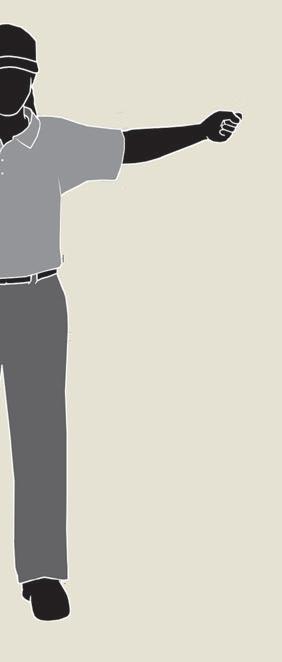
When having a discussion with a coach, be honest about what you saw and why you made the call you made. Never lie. Remember, cameras are everywhere and if you lie about what happened, it will come back to bite you. Once in a while, you may even have to admit to a coach you were wrong or simply didn’t see the play. That is OK once in a while, but don’t make it a habit.

DID YOU KNOW?
With the start of the 2018 season the NCAA changed its obstruction rule in regard to blocking the plate or a base. With the rule change, baserunners were required to have a clear path to a base and defenders could no longer block the plate or a base without possession of the ball. One caveat to the NCAA rule is runners may still be called out if they are clearly beaten by the throw. The rule was changed to try to remove ambiguous language from the old rule.
TOOLS





















to defenders
UMPLIFE Weather-Tek Pro Ball Bag
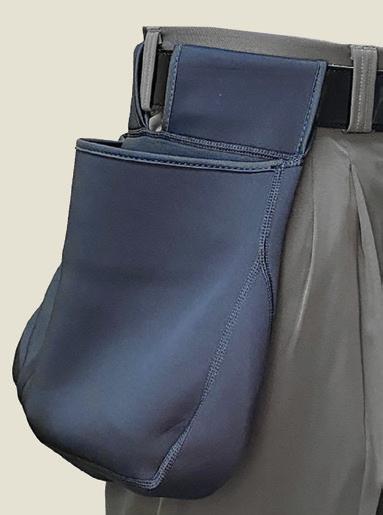
Are you tired of ball bags that are too small to carry multiple softballs and your lineup card holder and accessories? If so, the UMPLIFE Weather-Tek Pro Umpire Ball Bag is perfect. The ball bags securely hold up to five softballs and are made with reinforced, double-stitched, waterproof neoprene to support multiple game balls, as well as keep everything dry. The bags also have accessory pockets to hold your plate brush, indicator and writing utensils. The ball bags can be purchased from umpattire.com and sell for $24.99 each.

REFEREE July 2023 | 63
TEST YOURSELF
Each of the following includes a situation and possible answer(s). Decide which are correct for USA, NFHS, NCAA or USSSA rules and which might vary. Solutions: p. 85
1. B1 hits a hard ground ball that deflects off F1 and strikes R1 who is running toward second base. R1 is unable to avoid the ball and F4 is in position to field the ball.
a. The ball remains live and R1 is not guilty of interference.
b. The ball is immediately dead and R1 is ruled out for interference and B1 is placed on first.
c. The ball is immediately dead. B1 is ruled out and R1 is returned to first base.
2. With R1 on first base and no outs, B2 hits a long, high fly ball to center field. R1, believing the ball will not be caught, touches second base and starts for third when F8 makes an apparent spectacular catch. R1, who is halfway to third, runs toward the pitcher’s plate as she heads back toward first. However, F8 drops the ball as she falls to the ground, not securing the catch. Seeing that, R1 again reverses direction and advances to third base as the throw comes in.
a. R1 is out for running out of the baseline.
b. R1 is out for running out of the basepath.
c. R1 is out for abandonment.
d. R1 is out if the defense appeals that she did not retouch second on her way to first.
e. R1 is not out as she determines her own basepath and no play was ever made on her.
3. B1 hits a ground ball to F5 and beats the throw to first base but doesn’t touch the base. F3 catches the ball while in contact with first base, but makes no appeal.
a. Make no call.
b. Call B1 out.
c. Call B1 safe.
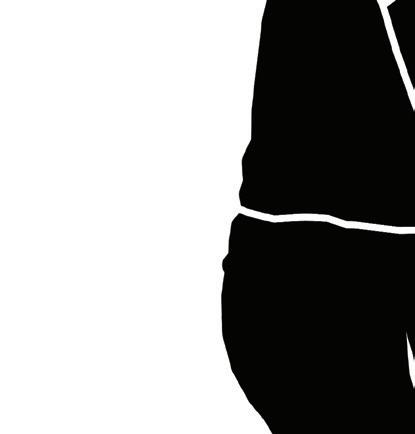
4. With an 0-2 count, B1 swings at an outside pitch and hits the ball to right field for a single. While contacting the ball, B1 has half her front foot outside the batter’s box and the other half inside the batter’s box.

a. Legal. Play continues.
b. Immediate dead ball, batter is out for an illegally batted ball.
c. Delayed dead ball; the defensive coach may take the result of the play or take the standard effect for an illegally batted ball, which would be strike three on the batter.
Carried Away

Overthe past few years, there have been two high-profile instances in games where a player hit an over-the-fence home run, proceeded to get injured running the bases and the opposing team carried the player around the diamond, allowing the player to touch each base, as shown in the PlayPic.
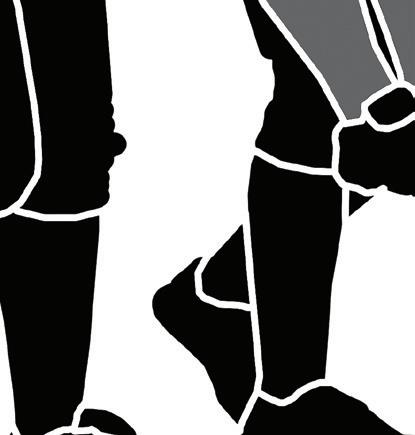
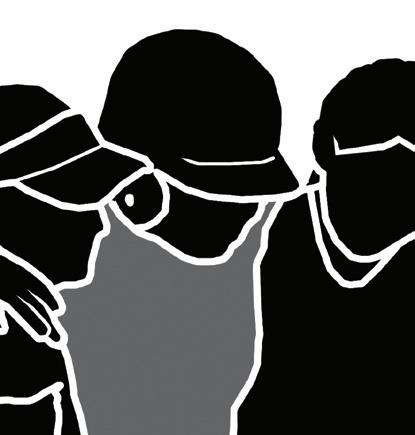
In both instances, newspaper and television reporters incorrectly stated the rules were written in such a way that this was the only way to allow the batter-runner to score. In all rule codes, this is an inaccurate interpretation of the rules.
NCAA rules have a specific rule reference that states if an injury occurs to a runner and prevents that runner from proceeding to an awarded base, the ball is dead and a substitution may be made. The substitute must legally touch all awarded bases or missed bases not previously touched by the injured
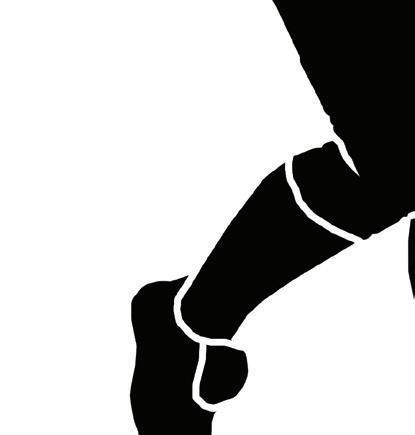

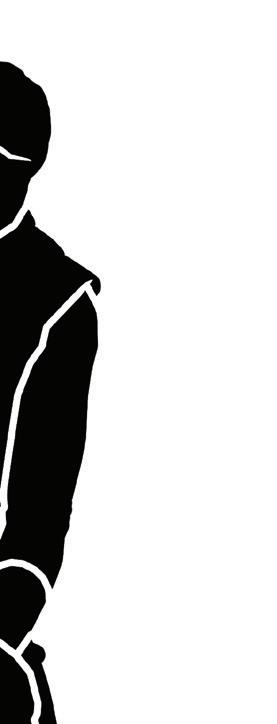

runner (8.5.3.2). NFHS, USA Softball and USSSA do not have a specific rule that is written to cover this situation, but all three have issued interpretations that handle the situation exactly the same way the NCAA handles it. They all allow for a substitute to enter the game and finish the dead-ball award for the injured runner.
The two situations both made for “feel-good” stories about sportsmanship and things being bigger than the game itself. However, the steps taken were not necessary and could have potentially led to a more significant injury to the batterrunner being carried around the field. It is important for umpires to understand the substitution rules and enforce them correctly. While it may be interesting to see the play on a major network or splashed on social media, the reality of the situation is it is totally unnecessary by rule.
64 | REFEREE July 2023 SOFTBALL
Deviation Communication
The mantra of base mechanics is if you deviate, communicate. It is also important to never go into a game with predetermined deviation from prescribed mechanics. However, there are two specific situations in the three-umpire system where it is important to discuss pregame how to handle deviation should either of these situations arise. Both situations involve a single runner on first when the umpiring crew is rotated, as shown in the MechaniGram.
The first involves a bunt play. In this situation, the plate umpire must first get an angle to rule on fair/ foul, but then must trail the runner to first base. The plate umpire is also responsible, by mechanic, to take any plays at third on R1. If R1 is stealing on the play and the bunt is near the line, the plate umpire’s first responsibility is to rule on the status of the ball. If the plate umpire gets “stuck,” it is important for U3 to read the situation and be prepared to take R1 into third base. It is paramount the plate umpire and U3 communicate to avoid two umpires potentially making a call at third base. U3 should “read” the plate umpire is stuck and should begin to take R1 to third. If the plate umpire is able to get to third base, the plate umpire should verbalize, “I am here” or “I’ve got third” to alert U3.
The second scenario involves

R1 stealing on the pitch and then there is an overthrow at first base. By mechanic, the plate umpire takes R1 to third and then U1 must rotate home to take any plays at the plate. However, with R1 stealing on the pitch and a bad throw over at first, R1 may never slow down at second and head straight to third.
Once the ball gets by first base, U1 may get trapped by fielders going after the ball and potentially a batterrunner overrunning first base. If this occurs, the plate umpire needs to be prepared to take R1 home if the runner continues there.
Again, communication between the plate umpire and U1 is key to avoiding two umpires making a call. The plate umpire should read U1 is trapped and begin taking R1 to home. If U1 is able to get down the line and recover, U1 should verbalize, “I am here” or “I’ve got home” to alert the plate umpire.

Both of these situations should be a part of the pregame discussion. They both happen with frequency in the three-umpire system and it can lead to confusion, especially if you are not familiar with working the threeumpire system on a regular basis. Ideally, umpires should stick to the prescribed mechanics, but these two situations don’t always make that possible.
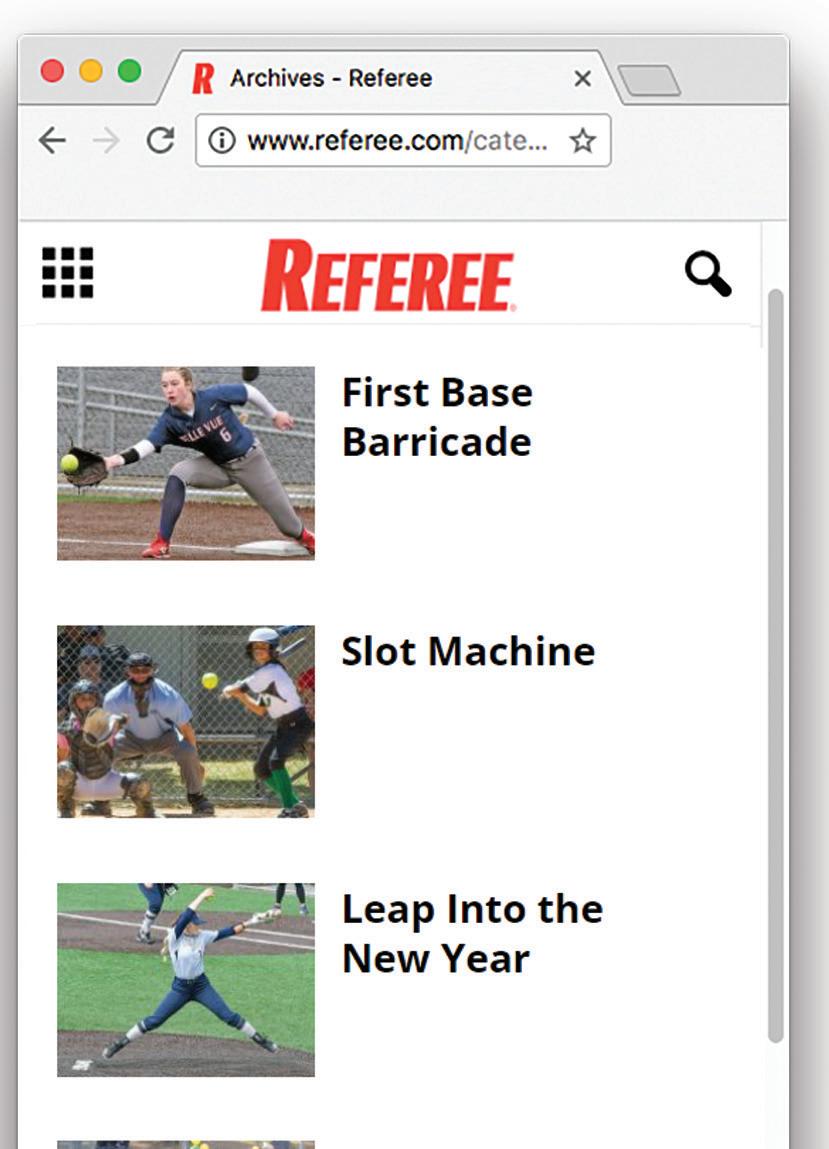
P U3 U1 R1 12-15 feet Approximately 12-15 feet HUNDREDS OF FREE SOFTBALL & OFFICIATING ARTICLES ON
CASEPLAYS
DP/Flex Substitution
Play: In the first inning, A1 (the DP) singles and the offensive head coach asks to have the Flex run for the DP. In the third inning, the A1 is re-entered into the game as the DP and singles again. The offensive head coach asks to have the Flex run for the DP again. In the sixth inning, the offensive head coach wishes to have A1 re-entered into the game as the DP to hit again.
Ruling: Illegal in all codes. A1 has been substituted for twice by the Flex and no longer has re-entry status. The offensive head coach can either leave the Flex in offensively or enter an eligible substitute into the DP position. Preventive umpiring would not allow A1 to re-enter the game, but if for some reason A1 were to play again, A1 would be an illegal substitute (NFHS 2-57-3, 3-3-6d, 3-4; NCAA 8.2.4, 8.2.7, 8.3.4.1.2, 8.6.1 Eff.; USA Softball 1-Illegal Player, 4-3D, 4-6E; USSSA 3-Illegal Player, 5-4D, 5-7B Pen.).
Umpire Interference?
Play: With R1 on first, B2 hits a pop up into short right field. F4 starts backpedaling to get to the ball and trips over the base umpire’s feet. The ball ends up falling to the ground and R1 advances to second base and B2 reaches first safely. The defensive coach calls time and argues F4 would have easily caught the ball had the base umpire not interfered. The umpires agree, call B2 out and place R1 back on first base. Ruling: Incorrect procedure in all codes. An umpire interfering with a fielder attempting to make a play on a batted ball does not fall under umpire interference. In all codes, in this situation, the ball should remain live and all runners advance at their own risk (NFHS 5-1-1f-1, 5-1-2c, 2.32.2; NCAA 9.6 Note; USA Softball 8-1E-7; USSSA 3-Interference B, 8-16G).
Foul Tip
Play: B1 tips an 0-2 pitch that goes directly and sharply to F2’s glove, pops into the air and is then caught by F2 with her bare hand. Ruling: It is a caught third strike and B1 is ruled out. If the ball first touches something other than F2’s glove or hand, it would be a foul ball (NFHS 2-25-2; NCAA 11.6.1; USA Softball 1-Foul Tip; USSSA 3-Foul Tip).
See ’Em Touch ’Em All
Umpires are tasked with a lot of responsibilities. However, one of the most important responsibilities is watching each runner touch each base.

Why? Because at the root of the game, a runner must legally touch all bases in order to score a run. And no umpires want to have egg on their faces when the defense appeals a runner missed a bag and said umpires have to give a half-hearted safe signal because they weren’t watching.
So, how do umpires avoid having this situation? The best advice is don’t be a ball watcher. Whether working in the two-, three- or four-umpire system, each umpire is responsible for certain bases. If you are not responsible for the catch/no catch or the fair/ foul call on a batted ball, you should be focusing on the runners at the particular bases you are responsible for covering. We get ourselves in trouble when multiple umpires are watching the ball and no one is paying attention to the runners as they round the bases.
The best way to avoid these situations is to pre-pitch prepare. Before every pitch, run through your mind where you are going if a ball is hit. If the ball is in your chase area and you choose to chase, by all means chase. However, once your decisions
in the outfield are exhausted, turn your focus back to the infield and keep an eye on what is happening on the basepaths. While you aren’t responsible for ruling on those plays, you may see something and can help if the crew has to get together.
If the ball is not in your chase area, focus on each runner you are responsible for and make sure each runner touches each base. While it is important to know where the ball is so you don’t end up in a possible throwing lane, your main responsibility is the runners.
One example where umpires can help each other, and it isn’t necessarily found in any manuals, is watching runners touch all bases on overthe-fence home runs, especially in the two-umpire system. Often, base umpires will escort the batter-runner to third and then run back across the diamond and never look at home plate. Keep your eye on the batterrunner as you jog across the field and make sure you see the batter-runner touch the plate. You never know when something will happen and your plate partner needs your help. Coaches will pick up if umpires are not paying attention and the last thing you want is an appeal and not have any idea if a base or plate was missed.
SOFTBALL 66 | REFEREE July 2023
Washington umpires David Nicksic, Everett, and Joe Mihelich, Olympia, both make sure the batter-runner touches the plate. It is always better to have two sets of eyes on these plays.
DALE GARVEY
SWIPE TAG 1
The ball clearly beats the runner to the base and the fielder is waiting to make the tag. As the runner begins the slide into second base, she raises her left arm toward the glove, which should be a red flag.

As the runner continues her slide, she swipes through the fielder’s glove, knocking the ball loose. In all rule codes, the runner is out as the ball is not considered as having been juggled or dropped if the runner deliberately knocks the ball from the hand or glove of the fielder (NFHS 2-28-4; NCAA 12.9.1.1.1 Note; USA Softball 8-7b; USSSA 8-18i Note).


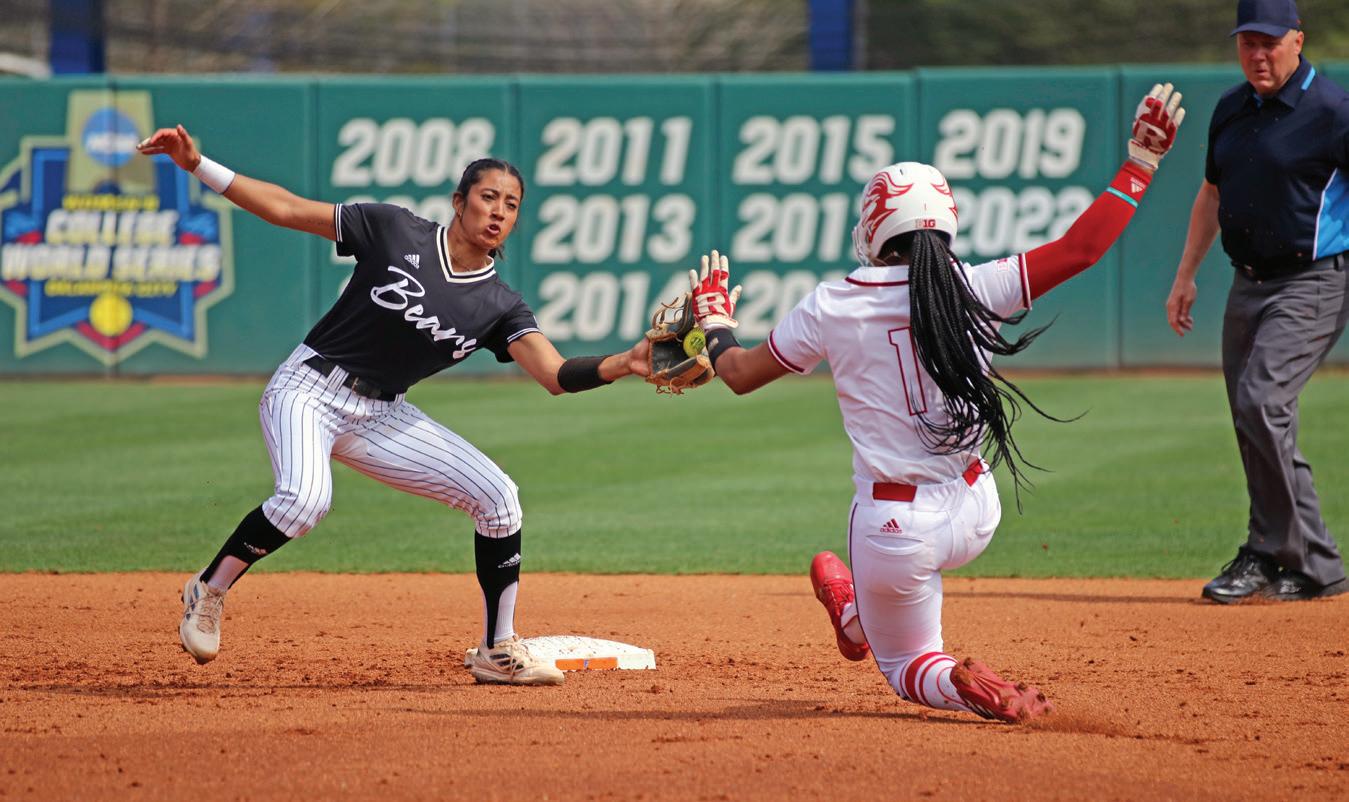
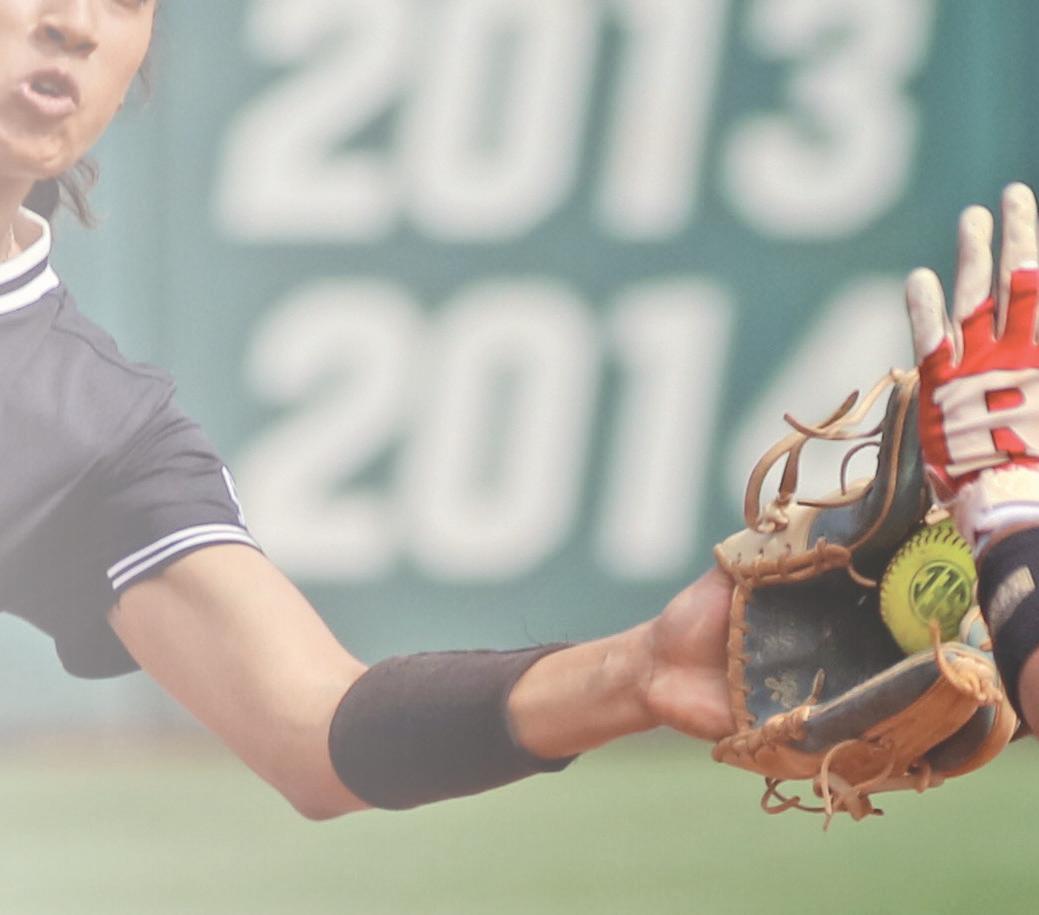
As the runner finishes her slide, the ball comes out of the fielder’s glove and is completely dislodged. The umpire takes his time to see the play through to its conclusion.
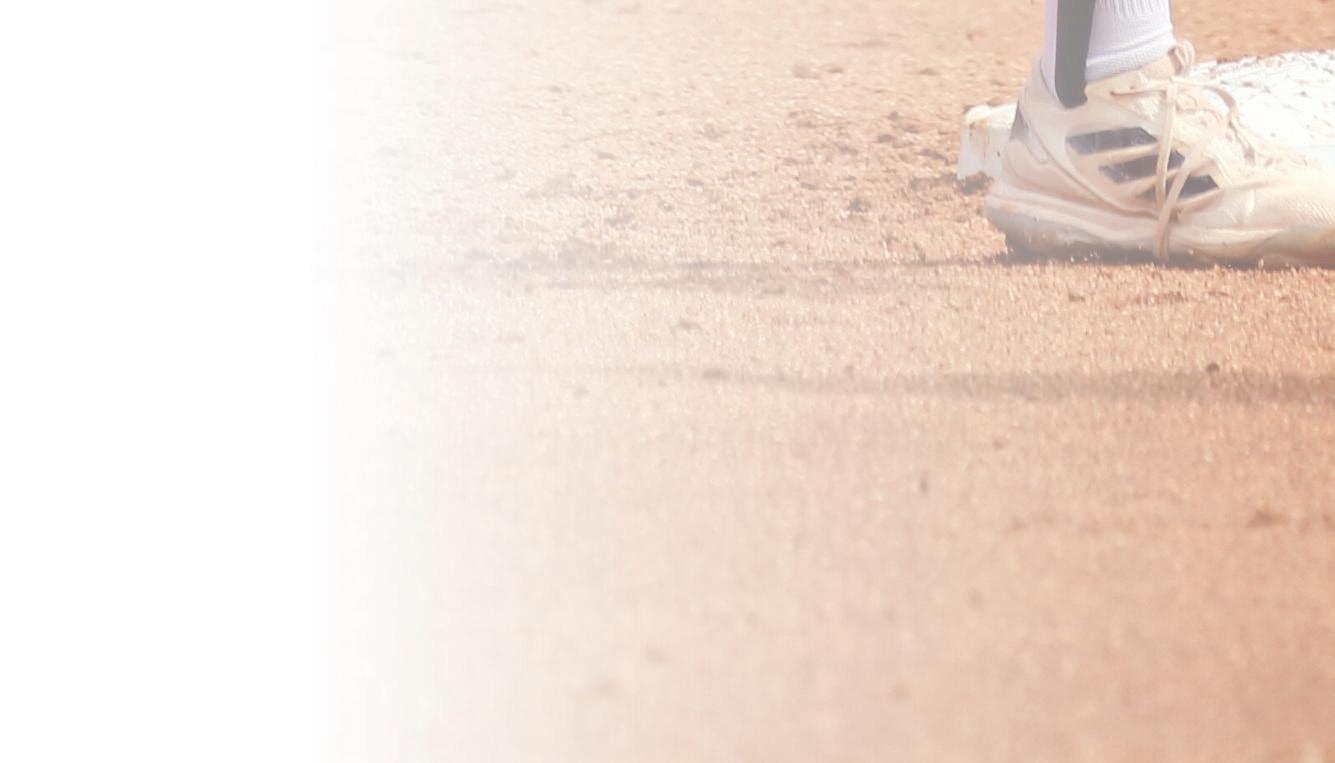
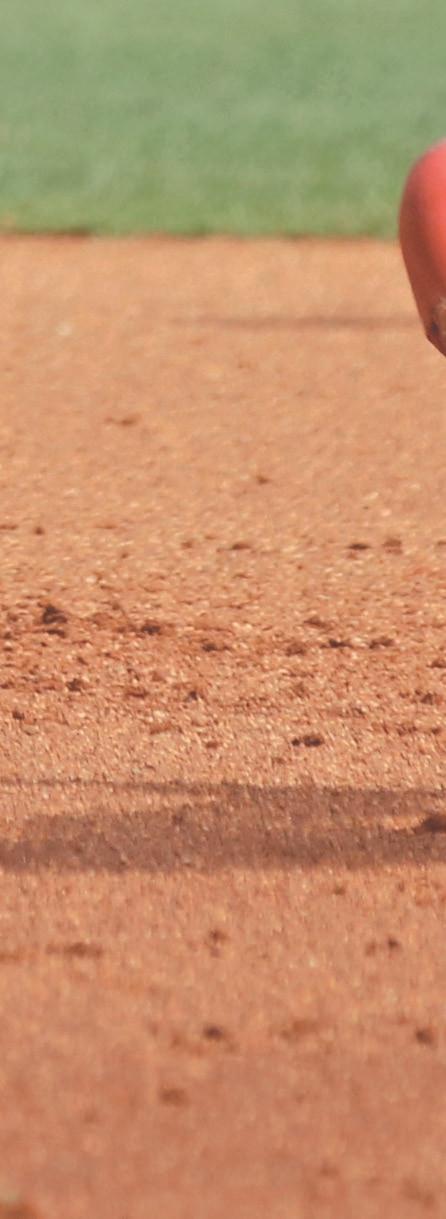

Michael Thibodeaux, Zachary, La., has a perfect view of this slide into second base on a stolen base attempt. The key to getting this call right is patience and watching the play to completion before making a call. 1 2 3 4
The umpire points to the spot of the ball, where the infraction occurred, and will follow that up with the out signal. In most situations, expect a coach to come out and question the call as the coach may not see the swipe or understand the rule.

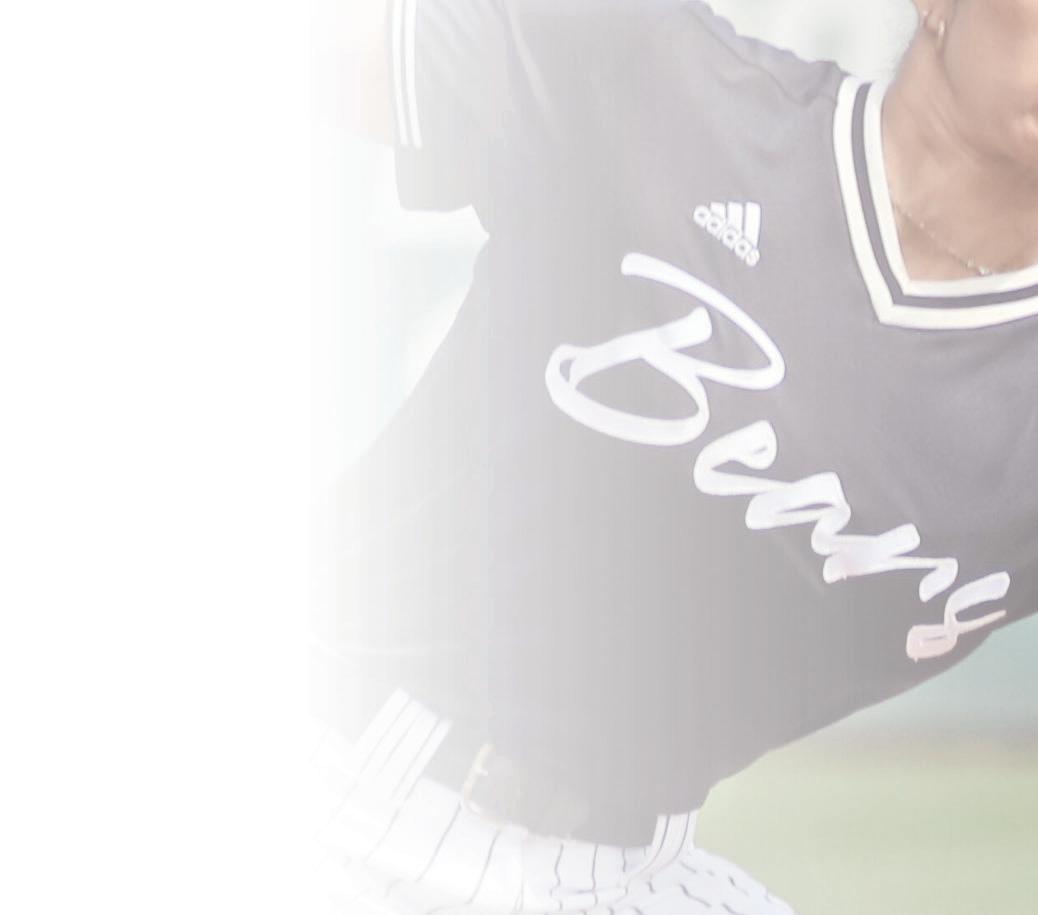


2 3 4

COURTESY JEN JONES/MERCER ATHLETICS REFEREE July 2023 | 67
SPEAK SOFTLY AND APPLY THE CORRECT RULE
A Deeper Dive Into Key NCAA Tournament Rulings
 By Scott Tittrington
By Scott Tittrington
It’s no secret television commentators do game officials few favors during the course of a typical college basketball broadcast.
True, there has been an evolution in recent years with the use of officiating analysts whose job is to break down rulings and explain for viewers why an official is doing something that half the television
audience automatically disagrees with because it doesn’t favor the team of their allegiance. But even with someone in that explanatory and educational role, there are still playby-play announcers and analysts who question, contradict and downright argue what is being offered, sure that they have a better understanding of the rules of the game they must impart to the viewing audience. Nowhere is that more evident
than during March Madness. The volume of games televised is significantly increased, and therefore the actual volume coming through the TV screen of voices exclaiming some ineptitude by a member of the officiating crew is also turned up a few notches on the dial. But just because the announcers get louder and more passionate doesn’t make them any more correct in their understanding of the rulebook.
BASKETBALL RULES, MECHANICS, PHILOSOPHY 68 | REFEREE July 2023 EDITOR: SCOTT TITTRINGTON stittrington@referee.com
© JOSEPH MAIORANA-USA TODAY SPORTS
Shaka Smart reacts to a play in the second half of the Golden Eagles’ second-round NCAA tournament game against Michigan State. A ruling regarding a possible goaltending late in the game caused much discussion by the broadcasting crew.
Let’s break down three plays that drew plenty of attention this postseason and why, by rule, the officials on the floor — not the armchair version sitting courtside and wearing headsets — were in the right.
1.The two-minute warning.

No, we are not suddenly shifting to a discussion about football. Instead, we are taking a closer look at a key ruling during the second-round East Regional men’s game between No. 2 Marquette and No. 7 Michigan State.

With a little more than two minutes remaining in the second half, Michigan State’s Mady Sissoko blocked a shot by Marquette’s Tyler Kolek near the rim that had many clamoring for a goaltending ruling. None of the three officials on the game — Lee Cassell, Brian Dorsey or Clarence Armstrong — stopped play. Replays appeared inconclusive in determining whether the shot attempt had made contact with the backboard before Sissoko touched the ball, one of the elements described in the rule 9-15.3.c definition of goaltending.
However, it was another part of the ruling aside from the pure officiating judgment involved in the play that deserves further discussion. The television analyst, former Villanova coach Steve Lappas, repeatedly stated his belief the officials should have ruled goaltending on the play, then gone to the video review monitors to confirm whether the ruling was correct. His argument was a safety net is in place for these situations and the officials failed to use it.
This is where rules knowledge becomes so important. While it’s doubtful the officials knew the exact time on the clock down to the second as this play was unfolding, the block occurred with 2:01 remaining in the game. According to rule 11-2.1.e.3, officials may voluntarily use replay equipment “in the last two minutes of the second period or the last two minutes of any overtime period, and only when a call/decision has been made, to determine if basket interference or goaltending has occurred.”
Had any of the three officials made a goaltending ruling on this play, the decision would not have been subject to video review. By rule, the goal would have counted and play would have continued with a non-designated spot endline throw-in for Michigan State with no further discussion or review.
The moral of the ruling? Call what you see. Don’t look for a “get out of jail free card” to bail you out when a difficult decision presents itself. If a rule exists to allow your crew to review a play, by all means use it. But don’t officiate to it just to please the masses.




BY THE NUMBERS
The number of games the NBA suspended Atlanta Hawks guard Dejounte Murray after he made contact with official Gediminas Petraitis after Game 4 of their Eastern Conference playoff series with Boston. The NBA rulebookstates, “Any player or coach guilty of intentional physical contact with an official shall automatically be suspended without pay for one game.”


THEY SAID IT
–South Carolina women’s basketball coach Dawn Staley, reflecting on the officiating in the 2023 NCAA Women’s Final Four SOURCE: GREENVILLEONLINE.COM

QUICKTIP










Struggling with a particular mechanic? Need to sharpen your player-control signal? Not sure if a new pair of shoes is right for you? Use the summer basketball circuit as a time to try new things to improve your game. While every game deserves your best effort, these offseason contests are a good time to work on yourself and develop habits that will carry over into your high school and college seasons this

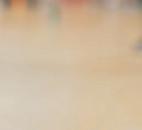

REFEREE July 2023 | 69
Marquette men’s basketball coach
“We should be able to talk about the officials. ... It’s part of our game that we need to discuss, and it’s fair game if they’re going to impact it.”
TEST YOURSELF
In each of the following, decide which answer or answers are correct for NFHS, NCAA men’s and NCAA women’s rules, which might vary. Solutions: p. 85.
1. All of the following result in a technical foul, except which?
a. A player grasps the ring to prevent injury.
b. A player hangs on the ring in pregame warmups.
c. A player intentionally slaps the backboard while a try is in flight.
d. A player places a hand on a backboard to gain an advantage.
2. Which of the following results in a violation by the thrower-in during a designated-spot throw-in?
a. The thrower-in jumps with both feet leaving the floor.
b. The thrower-in dribbles the ball.
c. The thrower-in steps on the boundary line.
d. The thrower-in steps over the boundary line.
e. The thrower-in backs up as far as possible.
3. A1 is attempting a throw-in along the sideline in team A’s frontcourt. Which of the following is true if A1 throws the ball toward team A’s basket?
a. It counts two points for team A if the ball enters the basket.
b. It counts three points for team A if the ball enters the basket.
c. If the ball hits the rim but does not enter the basket, it is a throw-in violation on team A.
d. If the ball enters the basket, it is a throw-in violation on team A.
e. If the ball hits the rim but does not enter the basket, the shot clock shall be reset.
4. When an error for a free throw by a wrong player is corrected, all of the following are true, except which?
a. Any made free throws shall be canceled.
b. Any common foul committed during the free throw shall be canceled.
c. Any technical foul committed during the free throw shall be canceled.
d. Any time consumed prior to the recognition of the error shall not be nullified.
e. Any foul that occurs after the free throws but prior to the recognition of the error shall not be nullified.
f. Any points scored after the free throws but prior to the recognition of the error shall not be nullified.
2.On the back but not at fault.
A key ruling late in the Midwest Region Elite Eight men’s game between No. 2 Texas and No. 5 Miami exemplified why it’s important for officials to understand the concepts of verticality and legal positions on the playing court.
With the score tied, 79-79, and 1:00 remaining, a missed shot attempt by the Hurricanes caromed off the ring to near the free-throw line. Miami’s Norchad Omier and Texas’ Brock Cunningham battled for the rebound. Omier came down on top of Cunningham, who had inside position. At first glance, it had the appearance of a pushing foul on Omier — the type of foul that Joe Q. Observer and many a talking head is so quick to label as “over the back.”
Instead, the officials working the game — Ron Groover, Brent Hampton and Pat Adams — ruled a foul against Cunningham. Television replays confirmed why. While Omier did indeed land on top of Cunningham, his reason for doing so was due to illegal actions not by the former, but the latter. According to rule 4-39.1, “Verticality applies to a legal position and also to both the offensive and defensive players,” with 4-39.1.c adding, “The space that a player may legally occupy is defined by an imaginary cylinder surrounding the player, which extends from the floor to as far above the player as he can jump or extend his arms and body.”
When Omier jumped in an attempt to secure the rebound, he remained in his vertical cylinder and did not push or otherwise illegally contact Cunningham. Instead, Cunningham left his own legal position on the playing floor and backed under the airborne Omier. As such, he violated rules 4-30.2.a and 4-30.2.d, which state, “To establish or maintain legal rebounding position, a player shall not displace an opponent, or violate the principle of verticality.”
It proved to be a pivotal ruling as Omier made both free throws, part of a 9-2 Miami scoring run to close out the game and secure a spot in the Final Four.
3.Who can shoot? Almost anyone. We stress the need for officials to know the rules for the level of play they are working. They also must understand the rules at the collegiate level may be different by gender.
In a Seattle Regional first-round women’s game between No. 4 Tennessee and No. 13 St. Louis, officials Bob Scofield, Cameron Inouye and Krystle Appelaniz did not let down their guard late in the game despite the lopsided score. With just 2:37 remaining and the Lady Vols holding a 41-point lead, they assessed an intentional foul against the Billikens’ Julia Martinez.
Given the situational element of the ruling, it would have been easy for the officiating crew to simply place the offended Tennessee player on the foul line for two free throws. Such is the first step in the penalty (followed by a designated-spot throw-in) for an intentional foul in both boys’ and girls’ basketball at the NFHS level, and for a flagrant 1 foul — the closest comparison to an intentional foul — in NCAA men’s play.
However, the NCAA women’s rule is different. According to the penalty for rule 10-13, two free throws are awarded to any member of the offended team. By definition, that doesn’t mean just the five players on the playing court, but any team member who is bench personnel when the foul occurs. As such, Tennessee head coach Kellie Harper sent substitute Edie Darby into the game, who calmly sank both free throws in what eventually became a 95-50 victory.
While it may not have been a key play in the final outcome, it’s a perfect example of an officiating crew knowing the rulebook and enforcing the rule correctly during an uncommon situation on the game’s biggest stage.
Misapply such a rule, and while no one at home watching may notice, you can bet the national coordinator responsible for deciding who does and does not advance to the next round certainly would. It’s the first rule of officiating. Control the controllables. Scott Tittrington is an associate editor at Referee. He officiates women’s college and high school basketball, college and high school baseball, and high school football.
BASKETBALL 70 | REFEREE July 2023
I’m Help Me,
This three-photo sequence is a perfect example of how a ballhandler’s inability to stay on his own two feet can present a challenge for a ruling official, as several different rule possibilities might come into play as he starts to fall to the floor.

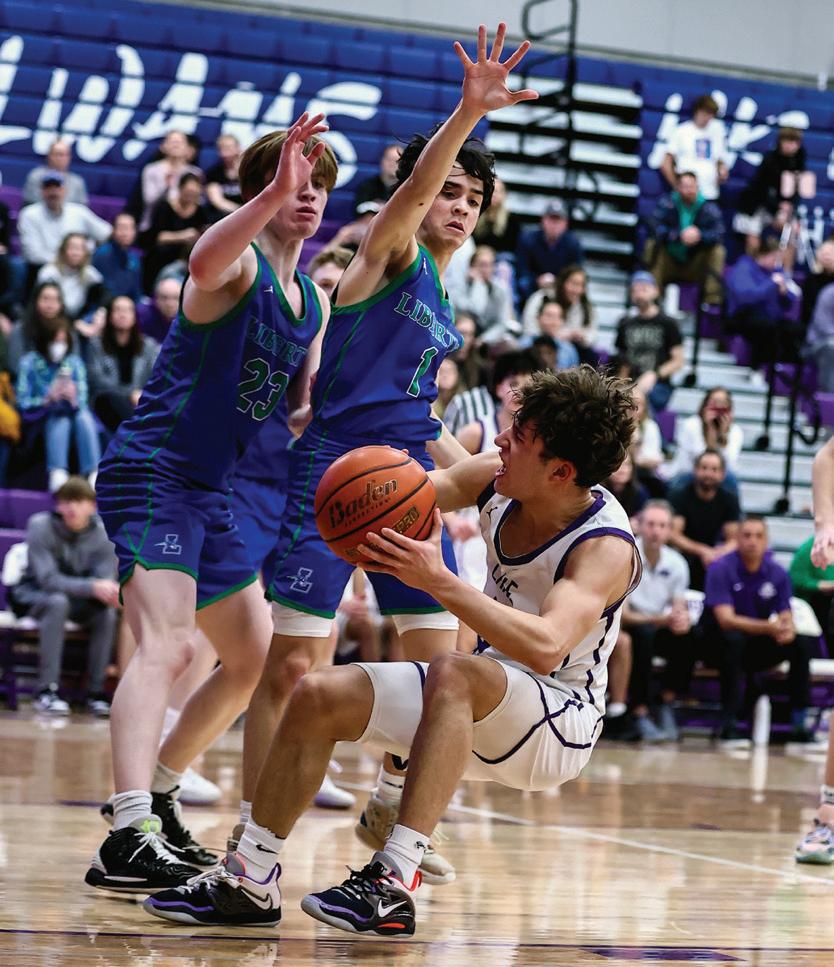
Let’s assume everything predating the first frame in the sequence is legal, as far as the ballhandler’s footwork is concerned, and that he landed simultaneously on both feet. At that point, by rule, either of his two feet may be established as the pivot foot (NFHS 4-44-2a1; NCAAM/W 9-5.4.a.1). That becomes important once he starts to lose balance, as it appears his left foot shifts and, in the second photo, even momentarily loses contact with the playing floor. This would establish the right foot as the pivot foot (NFHS 4-44-1; NCAAM/W 9-5.3).
The fact his body is contorting and falling toward the floor, while making for the type of awkward-looking situation that gets coaches, bench personnel and spectators squawking, has no bearing on whether his footwork is legal. The only thing that matters at the moment the second photo is captured is how he uses his right foot.
However, the third photo clearly shows, unless this young man is able to defy all laws of gravity and physics, he is going to make contact with the playing floor with either his backside or some point of contact on his left arm or hand. And that’s when another aspect of the traveling rules come into play.
According to NFHS rules, a player holding the ball may not touch the floor with a knee or any other part of the body other than a hand or foot (4-44-5a). The NCAAM/W rule is worded differently, offering that a player has traveled when he or she falls to the playing court while holding the ball without maintaining a pivot foot (NCAAM/W 9-5.7). So what’s the call if he lands on his rear? It’s a clearcut travel in NFHS play, and unless he could somehow keep his right (pivot) foot in place while doing so, it’s also a travel according to both NCAA rule codes, and there is going to be no argument made for an NCAA official ruling as such. The same would hold true if he falls on his left elbow.
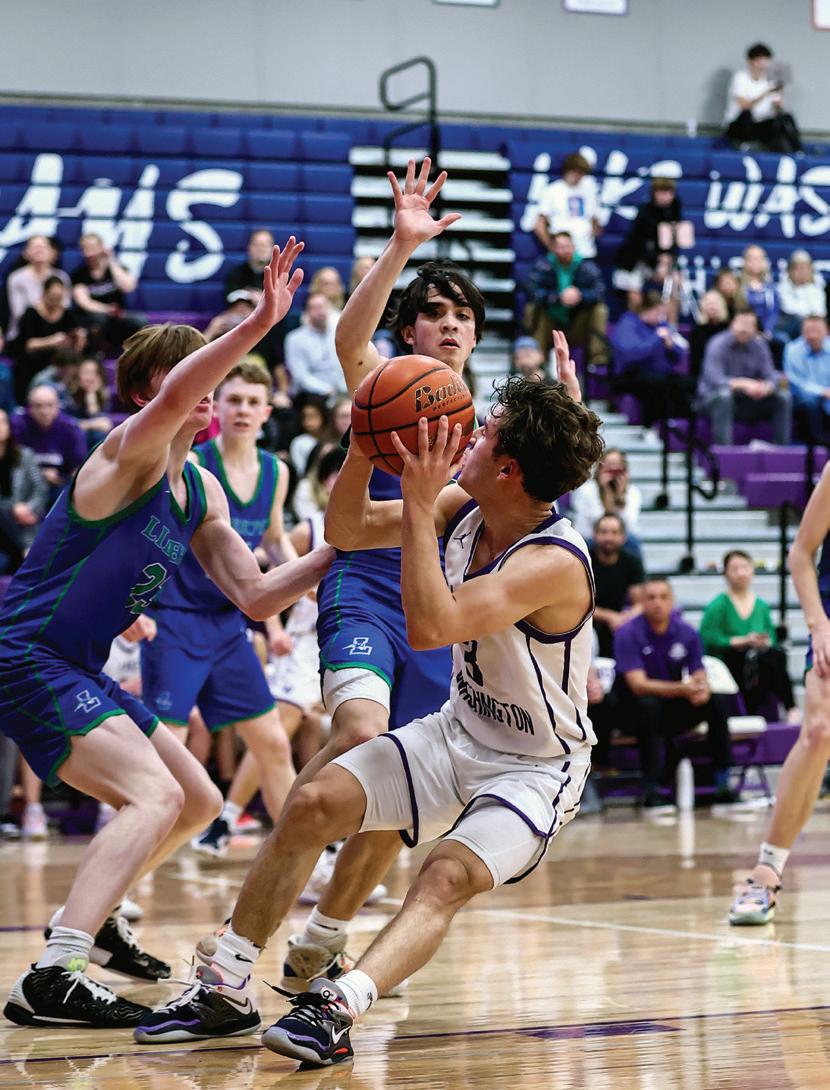
If his left hand makes contact with the floor, NFHS officials, like their NCAA counterparts, have to revert to what’s taking place with the pivot foot. No lift that causes the inability to maintain a pivot foot? No violation. A stable hand but an unstable pivot foot? Toot, toot.
Or what if, just after this last moment frozen in time, the ballhandler releases the ball to pass to a teammate or start a dribble? This is going to require extreme patience as an official and solid rules judgment, because there is a key difference. If he lifts the established pivot foot and releases the ball on a pass before that foot returns to the playing floor, that’s legal (NFHS 4-443a; NCAAM/W 9-5.5.a). If he does so before starting a dribble, it’s not (NFHS 4-44-3c; NCAAM/W 9-5.5.b).
ADAM HEIN LU
REFEREE July 2023 | 71
Officials are taught to understand rules and not put air in the whistle just because something looks funny or awkward.
CASEPLAYS
Free-Throw Violation
Play: A1 is at the free-throw line for the first of two free throws. A2 is incorrectly lined up in the lane space nearest the basket, and B3 is lined up in the second lane space next to A2. The officials do not notice the players are in the wrong positions. After A1’s first free throw is (a) successful, or (b) unsuccessful, the officials realize the players are in the wrong lane spaces. What is the result? Ruling: It is a violation if an opponent of the free-thrower fails to occupy each lane space above and adjacent to the block. It is also a violation if a teammate of the free-thrower occupies either of the legal lane spaces above and adjacent to the block. Therefore, A2 and B3 have committed simultaneous violations. In order to penalize a free-throw violation, the recognition of the error must occur during the free throw. In other words, it must be recognized between the time the free throw begins and when the free throw ends. In both (a) and (b), the free throw ended when the try was successful or unsuccessful. Therefore, it is too late to penalize the simultaneous violations. The officials should have the players change positions to the correct locations prior to administering the second free throw (NFHS 4-20-2, 4-20-3, 8-1-4b, 8-1-4c, 9-1-2, 9.1.2B; NCAAM/W 8-1.3, 8-1.4, 9-1.1.k, 9-1.1.l).
Stay Ahead of Electronics
By Tim Sloan
players and spectators restively twiddle their thumbs.
Acommon
theme in these pages is about the need for the officials to “keep ahead of the game.” We should never allow ourselves to be caught by surprise by some avoidable incident. To that end, as part of the pregame, the referee and umpires should familiarize themselves with game management in case they’re needed. Let’s specifically talk about device management in this epistle.
My state introduced the 35-second shot clock last season. Understanding its novelty, the state went as far as to encourage teams to run full-blown scrimmages before the season. That allowed the operators of the clock and officials to familiarize themselves with their workings before it mattered. Through this interaction and our first dozen games, my crew learned the idiosyncrasies of both the devices and operators.
Acknowledging this, it’s important the referee has a conversation with the two clock operators during the warmup about the nuances of the system at hand. Don’t leave the table until you understand the issues and have worked out with your two helpers how to manage possible resets. This includes knowing the game time and shot clock time remaining when the incident occurred. Suppose, for example, a shooter misses the rim late in the count, but the operator guesses “reset” and the ball goes out of bounds. If you’ve worked out a plan with the two operators to be watching both clocks and comparing notes, things get straightened out quickly; everyone looks good, and justice prevails — especially with 12 seconds left in a tie game.
Starting the
Second
Half Play: During the halftime intermission, team A’s head coach informs the scorer A1, A2, A3, A4 and A5 will begin the second half. Team A completes the alternating-possession throw-in to begin the second half. After a few seconds, the ball is batted out of bounds by team B. During this dead ball, the scorer notifies the officials A6 began the second half instead of A5. What is the penalty? Ruling: A6, who did not report to the scorer before the 15-second warning horn before the end of the intermission (NFHS) or before the horn that ends the intermission (NCAA), was an illegal substitute. Once the ball became live to start the second half, however, A6 became a legal player, and it’s too late to penalize the infraction (NFHS 3-3-1a, 3-33; NCAAM/W 3-6.1.d, 3-6.1.e).
Some shot clocks, for instance, have a “panic button,” which returns it to the last value it displayed before being reset to 35. That’s valuable when operators reset when they shouldn’t have. It happens often enough when unusual situations crop up. Mostly, it happens when earnest operators apply college rules instead of NFHS rules to a reset situation and then wish they hadn’t. The alternative to the panic button is to remember what the shot clock read and run it down from 35 to the correct number. That, of course, can be problematic if nobody’s tracking what it last read; our approach has been to remind the shot clock operator to make a mental note (how about a sticky note?) of the remaining time before each reset. Even with that ironed out, another variable has been what the game clock is doing while the shot clock is being reset. Some units allow the shot clock to run without the game clock running, too, while others are interlocked so the shot clock can only run when the game clock is running. In the latter case, that means the only way to correct the shot clock is to run both clocks down until the shot clock time is correct, then reset the game clock … all this while coaches,
Forget about the shot clock for now and let’s talk about the game clock itself. This recalls an incident where I was the focal point — as a 16-year-old high schooler. I was playing sophomore basketball at a school in Ontario, Canada, in 1975. We would play doubleheaders and our AD always asked me to stick around to run the clock in the varsity game which followed. Looking back on it, he bestowed a lot of trust in a kid. Anyway, our game clock was something like a Model T of the genre. It displayed two large minute digits at the center of a circle of 60 white dots, all counting down to zero. When the clock hit zero, the horn would sound, displaying “0” and no white lights; it would continue to sound until I stopped the clock and then the clock automatically reset to “19,” and 60 lights. Normal practice at the end of a period would be to let the horn sound for a few seconds before turning the clock off. If, however, I stopped the clock just as it hit zero, the horn would burp for a millisecond, often unnoticeable to those in attendance: Trouble brewing.
Fast forward to the regional final at our school, about two weeks before the provincial tournaments. The AD would be convening the AAA tournament at
BASKETBALL 72 | REFEREE July 2023
a nearby university and had already insinuated to me he might know who the clock operator would be. Our school was playing in that regional final and the game came down to the last shot, which was blocked, resulting in a scramble and a held ball. I hit the switch at the first “t” in the tweet of the referee’s whistle. In those days, the restart would be a jump ball between the two players involved, possibly followed by another shot attempt. I looked from the players to the clock and noticed the “19-and-60” displayed, signifying time had expired just as the referee blew the whistle, leaving my school with a one-point victory. Of course, nobody had heard a horn, so they wouldn’t know the game was over, and I then blew the horn manually, probably 2-3 seconds after the referee blew his whistle.

Try to imagine the ensuing couple of minutes. The homer/kid/drunk/thief seemed to have let the clock run after the whistle until it expired, ensuring his team would prevail. I explained to
the officials what happened since they seemed interested and they (reluctantly) bought my explanation, but the visiting fans made a point of shame-shaming a kid. My AD, of course, was familiar with the clock and got me out of the gym to safety, but it was an ugly incident.
I worked the AAA final that year — as the scorer.
Over the years, that episode has been an echo in the back of my mind, which has had a profound effect on how I run games. I had done everything right but still did something wrong … or had I? You might have thought I was being a little strident earlier, describing the conversation I recommend having with the clock operators today. If I had it to do over again, 50 years later, I might have briefed the officials on our clock’s blind spot. That way, at least they could have managed the incident instead of me. Maybe they would have clued in the visiting coach about the clock before the game? I suppose we can all think of things that could
happen that we could never plan for. But I do have one clear rule when it comes to electronics, the people that use them and how they can make life miserable.
My dad was a fighter pilot. Whenever the engine was running, he assumed the aircraft was plotting ways to kill him; he used his time in level flight to scan the gauges and look around for early signs of trouble, when there would still be time to avert it. He called it keeping ahead of the plane.
I have turned that into the belief you should never assume the most earnest and capable of helpers are fully in sync with you. Understand the systems they’re using — the clocks, the scorebook, the arrow. Then use your experience to gently and proactively get them thinking like you’re thinking; it’s another form of pregame but with a different script.
Tim Sloan, Davenport, Iowa, is a high school football, basketball and volleyball official, and former college football and soccer official.
PROFILES PERSONALITIES PLUS
From Calling the Pitch to Throwing the First Pitch
Weimar (Texas) High School softball coach Roger Maupin was looking for a way to recognize softball umpires throughout the state and particularly the Tri-County Umpires Association.
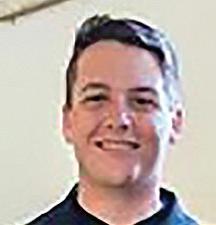
He found the perfect representative in E.I. Moore, who has been calling games in the area for 51 years.
Moore, a Yoakum, Texas,
said Moore, who graduated from Sam Houston State. “But it’s still the love for the game.”
Moore not only umpires fastpitch softball, he also plays the game.
Moore played for the Texas Stars, who were world champions in the 65-and-over division in 2020, and won another championship last year in the 70-and-over division (Moore turned 69 in May, but 70-and-over teams are allowed to have three players younger than 70 on the field as long as they are not pitching).
Moore was recently inducted into the Greater Houston Men’s Fastpitch Softball Hall of Fame.
“I love the game because it’s kind of like baseball, but quicker,” Moore said. “You can play for a long time.”
Moore has seen changes from an umpire’s standpoint over the years.
E.I. Moore, third from left, threw out the first pitch at Weimar (Texas) High School to recognize his long career as a softball umpire. Joining Moore were (from left) Weimar assistant coach Amanda Machicek, former Weimar head coach Doris Hatterman, current head coach Roger Maupin, Weimar superintendent Jon Wunderlich and fellow umpire Terry Patek.

resident, usually looks out at the circle from behind the plate. But before an April 14 game at the Weimar Softball Field, Moore stood in the pitcher’s circle to throw out the ceremonial first pitch.
“The Tri-County chapter has some of the best umpires in the state,” Maupin said, “and E.I. was a big reason.”
Moore began umpiring in 1973 and has been the Tri-County chapter’s lone president since it broke off from the Washington County chapter.
“It was a little extra money back when you were going to school,”
“I wouldn’t say the fans are worse than they were before,” he said. “I would say it’s definitely hard to get people to umpire. That is a big change.
“Back in the day, I used to get people to umpire that played the game and actually knew the game. You don’t get those anymore. You get somebody looking to make a buck, but then they find out after three or four years that you don’t make a buck so they get out.”
Moore and the Tri-County chapter are always looking for dedicated umpires.
While he acknowledges he didn’t get rich umpiring all these years, he found compenstation beyond money. ”If you like the sport, there’s nothing better than being out there. You’ve got front-row seats for every game.”
Moore was happy to work the Louise-Weimar game with longtime colleague Terry Patek, and hopes to continue for years to come.
“I love this game,” he said. “You might say it has been my life.”
This article courtesy of the Victoria (Texas) Advocate
A.J. Is A-OK
A.J. Jones Wooster, Ohio
Andrew “A.J.” Jones Jr.’s officiating career is on an upward trajectory. An Ohio State student, Jones represented his school as an official at the National Intramural Recreation Sports Association national basketball championships April 14-16 at the University of Maryland. Jones was one of 51 officials from across the country to be selected.
“Not many people in their second year of officiating get this kind of opportunity,” Jones told the Wooster (Ohio) Daily Record Jones attended two days of officiating clinics and worked games two other days. NBA officials Suyash Mehta, Matt Myers and Eric Lewis spoke at the clinic.
SOURCE: WOOSTER (OHIO) DAILY RECORD
From AD to VIP
Herb Resler Goshen, Ind.
As Goshen (Ind.) High School’s athletic director from 1973-94, Herb Resler was no stranger to the Goshen Relays. But on April 22, the 82-year-old was put squarely in the spotlight when he served as the honorary referee for the track and field meet.

“It’s definitely an honor for me to be considered,” Resler told the Goshen (Ind.) News. “We had a lot of outstanding people over the years to be the honorary referee. I don’t know if I fit into that category or not, but it’s an honor.”
Resler worked the event for 33 years. “It was definitely a highlight of my athletic experience here at Goshen,” Resler said. “It’s definitely a community event; the community all comes together for one big thing and it’s a lot of fun.”
SOURCE: GOSHEN (IND.) NEWS
Do you know a person or group who should be profiled?
Send info to us at profiles@referee.com
COURTESY
E.I.MOORE; PHOTO CREDITS MIKE FORMAN/WOOSTER DAILY RECORD; COURTESY HERB RESLER
74 | REFEREE July 2023








As an official, only NASO membership gets you into Marriott’s exclusive athletic discount program, which provides a discounted rate at Marriott and Starwood branded properties in the US and Canada. With the VIP card, NASO members are able to stay at those participating hotels for a room rate up to 25 percent lower than the regular price, based on availability. UPGRADE YOUR REFEREE SUBSCRIPTION TO A FULL NASO MEMBERSHIP TODAY! Visit naso.org/join or call 1-800-733-6100 EXCLUSIVE ACCESS ONLY FOR NASO MEMBERS
THANKS FOR THE MEMORIES
By Brad Tittrington
In his book Moonwalking With Einstein, author Joshua Foer takes a peek into the inner workings of the brain and how memory works. Foer began his journey simply looking to write an article for a magazine about the competitors at the U.S. Memory Championships. Instead, he became fully immersed and challenged himself to enter the contest a year later after one of the contestants boasted anyone could win the event with proper training. Foer learns multiple techniques to enhance his memory — things like mnemonics and mental palaces.
These techniques are used by mental performance coaches all around the globe to help actors remember lines, musicians remember lyrics and politicians remember speeches. And while mental performance coaching has been around for a while, it only recently entered the realm of sports officiating.
THE CURVE OF FORGETTING
According to Foer, memories gradually decay with time along what’s known as the curve of forgetting. As soon as a person learns a new piece of information, the memory’s hold on it begins to loosen, until it is forgotten completely. German psychologist Hermann
Ebbinghaus wanted to test this timing of the curve and practiced on himself. He found that within the first hour of learning something new, more than half of what he had originally learned had been forgotten. After a day, another 10 percent was lost and after a month, another 14 percent. After that time, the memory more or less stabilized.
This is the reason it is often instilled in officials to continually read the rulebook. Those who read the rulebook cover to cover one time are bound to forget the majority of it before the season ever begins. That is why it is suggested to read a chapter a day. And then once you complete the book, start over again. The idea an official can read the book one time and remember it completely is debunked by Foer. He says the idea of having a photographic memory is not possible, but developing memories and connections in the brain over time can help one recall information.
THE MAGICAL NUMBER SEVEN AND CHUNKING
Harvard psychologist George Miller published a paper in 1956 in which he discovered humans can only think about seven things at a time. When something new enters our head,
it doesn’t immediately become a long-term memory. As more and more information enters our heads, we lose a lot of the previous information, or the ability to recall it immediately. According to Foer, “Our ability to operate in the world is limited by the amount of information we can juggle at one time.” A lot of the information that passes through our brains does not need to be remembered for long periods of time, just long enough for us to perceive it and react to it. Then it is gone. This can be seen clearly in the officiating world: As we see a play develop, we react to it, then it is over. If asked about a particular play after the game, many times the details of the play are fuzzy, unless we have written it down or made a mental image of it. This is because our brains can only handle those seven things at a time. It is why we often struggle to write game reports when we sit down at our computer hours after the game ended. We may remember some of the details, but we have a hard time recalling exactly what was said in the moment, what the game time and score was, or exactly who did what.
Because our brains are limited in what they can hold at a time, it is important to practice chunking. This technique is where you lump multiple things together in one image instead of trying to remember each thing individually. A specific example of this is volleyball officials trying to remember
76 | REFEREE July 2023
Do you feel like your mind fails you when trying to recall facts while officiating? Use these tips to strengthen your memory.
lineups. In a normal volleyball match, each team has six players listed on a lineup, plus a libero. So a referee must remember seven players for each team. For those really good at math, remembering the exact order of the six players on the court, plus the libero who goes in and out of the match regularly, plus substitutes, it may not be a big deal. For the rest of us, it can be challenging to figure out the alignments. So how can we make it easier. Chunking is one way to do this.
For example, here are the numbers for a team’s lineups: 12, 7, 41, 9, 11, 1. Trying to simply use rote memorization with those numbers could make it very difficult to remember the order. There is no pattern. However, if you put the first three numbers together 12/7/41 and the second three together 9/11/1, there is a pattern. The first three are the date of the attack on Pearl Harbor, and the second is the date of the attacks on the Twin Towers in New York and the Pentagon. Instead of trying to remember six individual numbers, you can chunk the numbers together and now only have two pieces of information, making it easier to store. While not every lineup will always get you something easy to match it up with, if you spend a little time before the match looking at the numbers, you can usually find a pattern or date to make it easier to remember.
THE EXPERT EXPERT
Foer describes the art of chicken sexing. And while it appears there may not be any commonalities between this and officials working games, there are actually a lot of similarities. In the world of chicken farming, male

chickens are useless as they can’t lay eggs and their meat is stringy. The problem, however, is it is virtually impossible to tell the difference between male and female chickens until they’re four to six weeks old. In the 1920s, Japanese scientists discovered a way to identify the chickens much earlier. Without going into gory detail, basically they could see a “code” on the inside of the chicken that would divulge the sex. Expert chicken sexers can’t describe how they do it. According to Foer, they “just know.” They have an intuition because they have seen it before. It is more art than science.
The same goes for officials. Ask expert baseball and softball umpires, and they will tell you they know a ball or a strike when they see it because they’ve seen it before. Volleyball officials may not 100 percent be able to tell you what is a double contact or prolonged contact, but when they see it, they know it. This is all because of repetition and feel. That is why it is recommended officials use virtual reality training and watch film. They can form those “memories” in the brain so when they see it again during a game, they will have already experienced it and know what to do.
IMAGERY
The final memory trick is using imagery to remember an order of numbers. Part of the U.S. Memory Championships involves memorizing two decks of cards and a random number sequence. Psychologists discovered it was easier for the mind to remember imagery as opposed to simply trying to remember numbers, and all the competitors in the memory championships use a system of imagery to remember cards and numbers. The “trick” or
Psychologists know the brain is more likely to remember an event if vivid imagery is associated with it. To help with later recall, work on creating images of specific plays you want to remember as opposed to remembering just numbers.
technique is to create an image for each of the 52 playing cards. For example, the four of spades (myself), king of hearts (Michael Jackson moonwalking) and the three of diamonds (Albert Einstein). To remember the three-card sequence, you simply put together an image of the three cards from the images that correspond to those three cards. Hence the book title, Moonwalking With Einstein, was born as that was one of the sequences in the deck of cards Foer had to memorize. This technique takes a little time to develop and practice as everyone has their own images for each card (most also use this technique to remember the number sequencing portion of the competition as well). Each two-digit number from 00 to 99 corresponds to an image and competitors will create stories from those images to remember the sequence. This could be most useful in the sport of volleyball. Again, trying to remember the initial lineups for teams can be difficult. But if you can create imagery to remember the positions of each player instead of just a number, the brain is more likely to recall the information. It is why a lot of volleyball referees use distinguishing characteristics for players, as opposed to just a number. For example, some referees remember hair style or shoe color or maybe jewelry or facial features that stand out. Those are more easily recalled than straight rote memorization. While you may not ever find yourself having to remember pi to the 128th digit or competing in the U.S. Memory Championships where you have to moonwalk with Einstein, the principles remain true. Try these techniques and see if they help you improve your memory and help you become a better official.
Brad Tittrington is an associate editor for Referee
REFEREE July 2023 | 77
STAYING FIT IS IT Keeping in Shape Helps Combat the Aging Process
By the Referee Editors

Officials can control lots of things, but not this: We have birthdays. The more candles on the cake, the slower and less limber we become. Our brains try to convince our joints and muscles we can go on forever. But at some point, the body wins out and we realize it’s time to hang it up. But if you take proper preventive measures, you can delay the point at which you have to retire, without people talking behind your back and asking why you’re still hanging around.
One thing you can do is keep the weight off. For years people have listed myriad reasons you need to stay slim and trim, but it becomes even more necessary as you get older. If you keep the pounds off, you won’t slow up as much. Lifting light weights and doing aerobic exercise helps as well.
Give some thought to altering your workout routine. Jogging is great exercise, whether on the pavement or on a treadmill. But as the years go by, it gets to be hell on the hips and knees. Switch to a low-impact apparatus or walking. Bicycling, swimming and yoga are other options.
Whatever you choose, you must make conditioning a year-round proposition. You can’t wait until a month before the season and start training as if you’re an Olympian. Only young people can get away with that.
Remember to do some stretching — lots of it — before and after games. You can’t just jump out of the car and hit the court or field as in earlier days, because the likelihood of pulling a muscle becomes greater as the years advance. Postgame stretching will also result in less agony when you get out of the car following a two-hour ride after a game.
It is highly advisable to consult
ALL SPORTS FOR ALL SPORTS, ALL LEVELS 78 | REFEREE July 2023 EDITOR: JEFFREY STERN jstern@referee.com
BILL STRAUS
Being in good shape helps Kristi Boylan, Louisville, Ky., stay on top of her game. Although it’s harder to maintain conditioning as you age, adjusting your exercise regimen and cutting back on your schedule can keep you on the court or field.
a professional regarding stretching. Lots of people have done serious damage to themselves by embarking on self-created stretching programs. That can be an especially dangerous pitfall for those who once were good athletes.
Attitudes about what should and should not be done change over time, and what was once acceptable practice may become anathema. You may remember how we used to do flat-legged sit-ups and high-speed squat thrusts. Now a personal trainer who allowed that might be sued for negligence.
Another adjustment you might consider is modifying your schedule. Taking fewer games can keep you from getting burned out, to say nothing about improving your family life. But it can also preserve your shelf life. What you do on the court or field takes a toll on your body no matter how old you are, but even moreso as you get up there in years. Cutting back your schedule as you get older will reduce the wear and tear, not only on your body but on your spirit and mind. That may lead to you deriving the added benefit of improved performance in the games you work.
Serving as an emergency fillin as opposed to being a regular can be a godsend to an assigner when weather-related issues lead to makeup games. Be careful not to be too generous, however. You can
sometimes wind up working more games than when you were a regular. Be helpful, but make it clear to assigners you are cutting back.
You can stay involved in officiating by mentoring or observing officials. It will give you a physical as well as a mental break while you are “giving back” to the avocation. The lessons you learned over the years are valuable to less-experienced officials. Talk to your assigner or coordinator to find out what needs they have in that area.
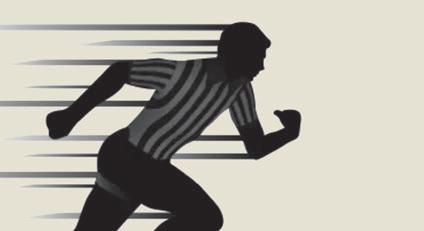
It has also been suggested that drinking more water is advisable as one gets older. None of us probably drinks enough water, but it can help keep you healthy in a general sense and in better shape while you’re officiating. You can’t afford to load up so much that a bathroom break is needed in the middle of the second quarter or third inning, but you can sip before and after games, between quarters and during timeouts.
Along with fluid intake, remain vigilant about your diet. Follow the food pyramid that spells out the recommended daily portions of proteins, fruit, vegetables, starches, dairy and fats. Avoid between-meal snacking and late-night eating.
You can’t stop the days from flying by, but you can take steps to make the ticking less painful than it might be.
Portions of this column appeared in the 7/15 issue of Referee
Overthrow the Dictator! Hail to the Facilitator!
Doyou know any dictators? We’re not referring to the autocratic leader of a banana republic. Dictators in the officiating world control the game to their tempo, refuse to treat athletes and coaches with respect, are poor communicators and “always” make perfect calls (even though they do make mistakes and refuse to admit to them).
It is hoped you don’t see yourself
in that unpleasant list.
What is a better way to approach officiating? Currently, the most popular and effective “style” is to employ a facilitator-type personality. That’s embodied by the notion that officials are there to manage the game, as opposed to control the game.
Perhaps the two best words to sum up the qualities of a facilitatortype official are management and

SURVEY SAYS …
How many assigning systems do you juggle as an official?
QUICKTIP
When the game ends, walk with your partner(s) off the court or field. With at least two of you together, you can look out for each other. Emotions often escalate after games and occasionally people will try to confront you. When you leave together, you have a potential peacemaker and a witness if anything should go awry. Also, always walk together from your locker room to your cars. Your partner can help you handle unexpected “guests” or give you a lift if your car doesn’t start.
TOOLS
RunninRef.com


RunninRef.com is an online physical training program designed specifically for referees. Created and operated by Austin Ardrey, who spent nine years in the collegiate strength and conditioning industry as a performance coach, Runnin Ref offers a world-class training program that safeguards referees from injury and assists them into better performance during game or match play. The program helps officials develop proper sprint technique and onfield movements and improve conditioning levels for individual and team training sessions.

REFEREE July 2023 | 79
.
1-2 . . . . . . . . 60.4% 3-4 . . . . . . . 33.7% 5 or more . . . 5.9
SOURCE: SURVEY OF 101 REFEREE READERS
%
communication. Good officials know how to keep the best interest of the players, coaches and fans in check. They also know how to keep the lines of communication open between themselves and everyone else involved with the game.
The best types of facilitators on the playing field or court are most likely to possess many of these attributes:
•They are active listeners — not only do they hear what players, coaches and other officials are saying, but they are listening to them, absorbing and understanding the information.
•They ask questions — whenever they are unsure of something, they seek clarification, especially from their partners and crewmates.
•They intervene when necessary
— they let players and coaches know what is going to be tolerated and offer fair warnings. They don’t interject themselves unless they have to.
•They treat everyone involved in the game with respect — they realize they have a job to do and everyone else at the game has a job to do, too. They understand that only with everyone working in unison with professionalism on everyone’s part can the game flow. Of course, they understand they can’t control the professionalism of others, but strive to maintain their own.
•They value constructive criticism — good officials welcome feedback, whether it is positive or negative, so they can improve their game.
•They allow the game to flow — they allow players to create the
tempo and flow of the game and only intervene to do their job, rather than create work for themselves where none exists.
•They prefer remaining in the background — the less heard from the officials, the better the game. At the same time, when the game action dictates they must come to the forefront, they do so without hesitation, professionally putting the game back on course again.
•They get simple enjoyment from the game — much like athletes enjoy playing, coaches coaching and fans watching, facilitator-type officials derive pleasure from their jobs. Adapted from a feature written by Dr. Peter Sacco, a psychologist and freelance writer, that originally appeared in the 8/03 issue of Referee
Six Things You Absolutely, Positively Must Do Before Every Play
By Jeffrey Stern
At a time when scrutiny of officials is greater than ever before, the need to get plays right is Job One. Most evaluators won’t judge too harshly an official who may not be in the absolute best position according to the manual but still makes a correct ruling on the play. Unless an official freelances positioning the entire game, judgment trumps mechanics almost every time.
With all of the pressure officials face while play is in progress, it’s easy to forget that what happens while play is stopped is just as important as what happens during active play. An official who views timeouts or the time between plays as dead time is asking for trouble.

Here are six things you need to do before play resumes after a stoppage.
1.Make Eye Contact With Your Partners
Just because you’re ready to go, it doesn’t mean those you’re
working with are in the same state of preparedness. They may be tying a shoe, addressing a clock or equipment problem, talking to a coach or player or just plain
daydreaming. Restarting the game before everyone’s ready can result in having to redo the restart, which makes you look less than professional.
ALL SPORTS 80 | REFEREE July 2023
BOB MESSINA
Before Karin Jacobson, Logan, Utah, signals for the serve, she’ll make sure her partners are in place and ready and the players are where they need to be.
You should also make sure game-related auxiliary personnel (e.g. the chain crew, scorers, timers) are in place and ready to go as well.
2.Consider the Game Situation



Understanding what strategy the teams may employ helps you plot your positioning ahead of time. The score, juncture of the game and other factors should all be noted and analyzed. Knowing which rules may come into play when the action resumes will prevent you from being surprised when a situation arises.

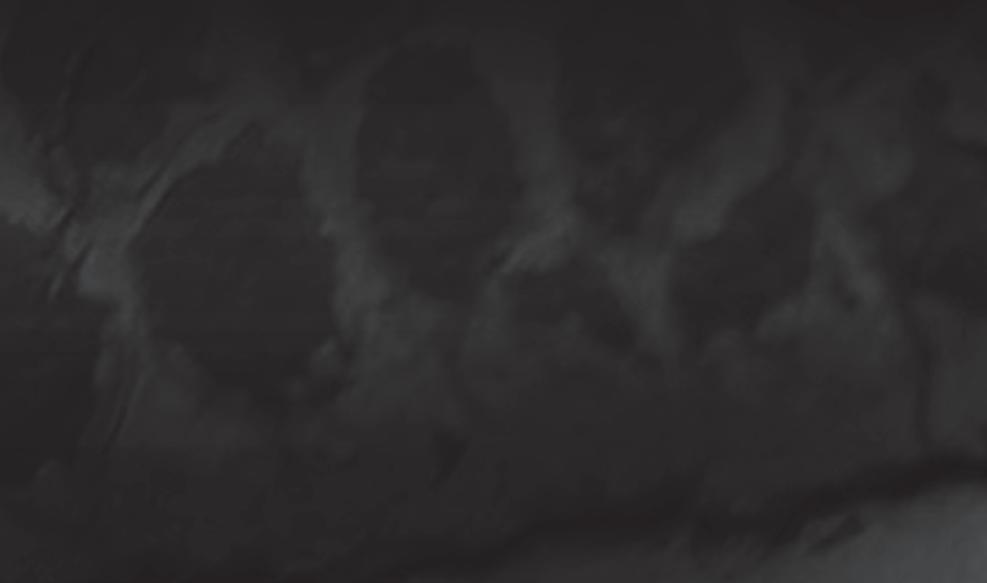
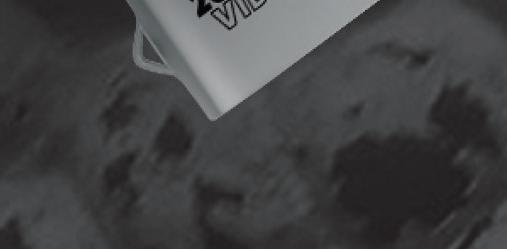

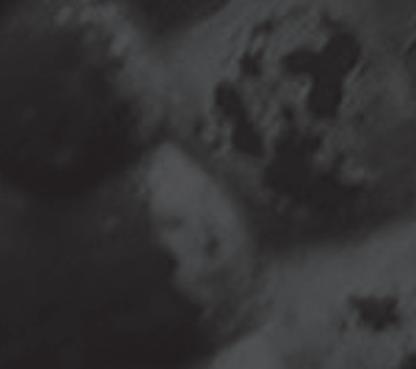

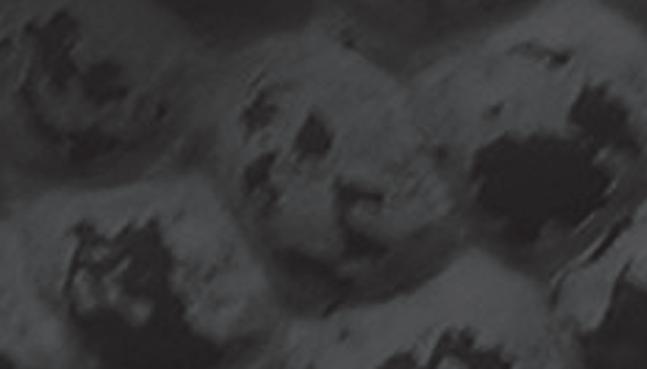






3.Check for Obstacles or Other Potential Dangers





































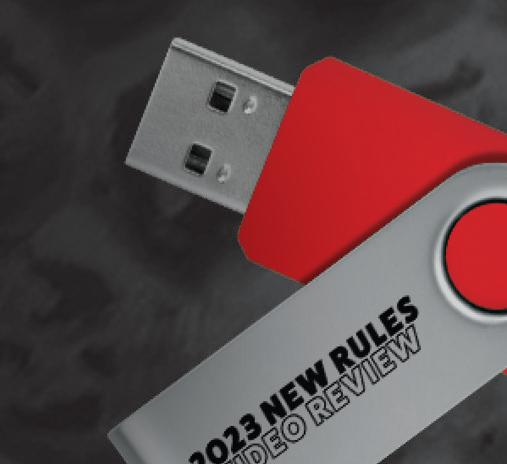



















Cheerleaders or dance teams using props such as pompoms or run-through banners sometimes leave debris behind on the playing surface. Make a quick but thorough visual scan of the area to be sure it’s safe to proceed.
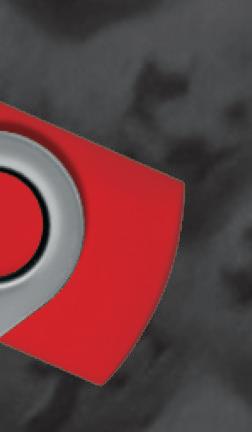
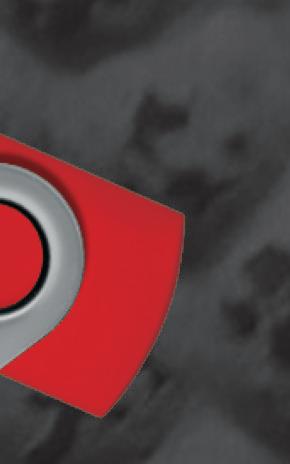
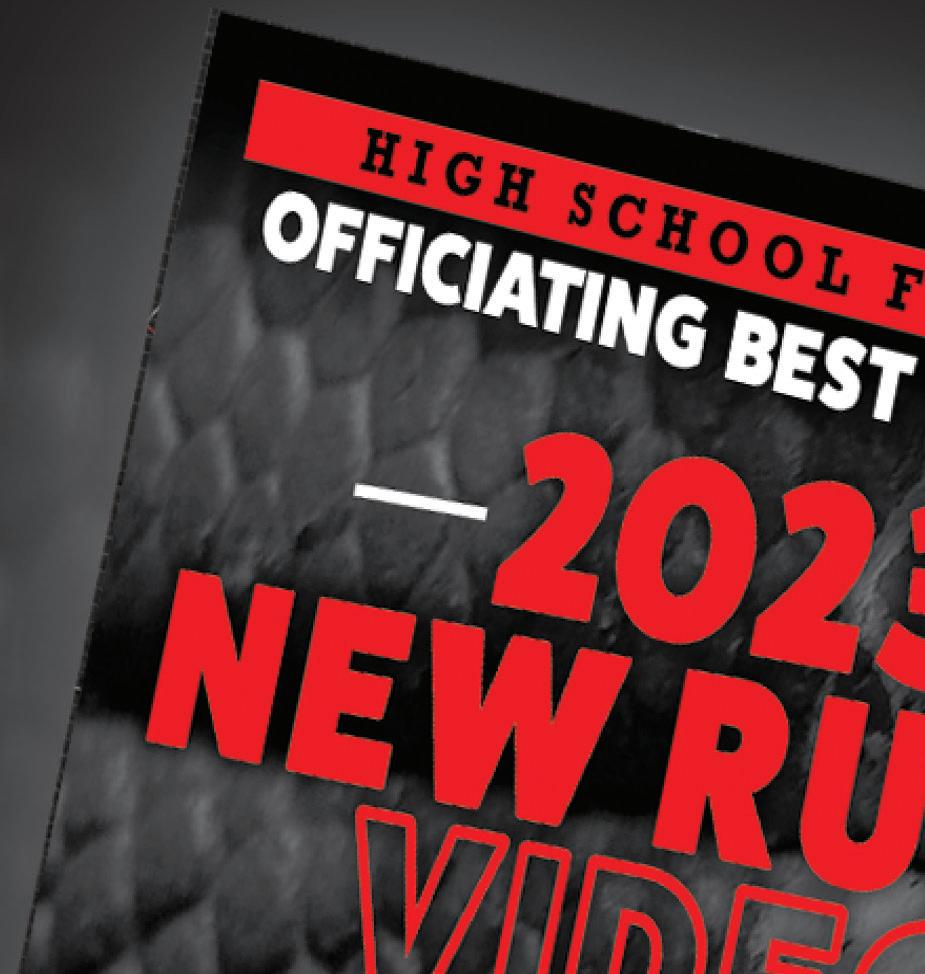
Fans anticipating the end of the game will sometimes move closer to the court or field. If necessary, get the help of game management to keep the crowd back so they don’t become entangled with athletes or officials and don’t interfere with play. If the game was stopped because a player was bleeding, be sure any affected areas are properly cleaned. If the rules of the sport cover situations in which players have blood on their uniforms, ensure the uniform is either free of blood or changed. Ensure that game apparatus (e.g. nets, pylons, goals) is in order.
4.Count the Players

Don’t allow a team to put itself at a disadvantage by restarting play with fewer than the required number of players. By the same token, if the rules of the game allow you to help a team correct a situation in which it has too many players, take advantage of the rule.
In sports where substitutions take place during game breaks, ensure the proper players are in the game. For instance, keep track of which player will be shooting free throws.


5.Know the Clock Status

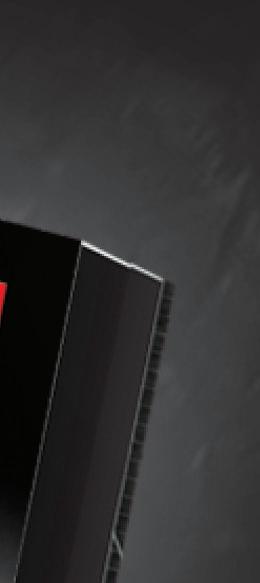













In sports that use a game clock, know if and when the game clock is supposed to start. That is especially important at the end of periods when time is precious.
6.Observe Injured Players

If play was stopped because a player was injured, note if the player is attempting to return to the game. In some cases, the rules require if play was stopped because of an injury, the player may not return to action immediately. Jeffrey Stern is Referee’s senior editor. He officiated high school and collegiate football and umpired high school baseball.
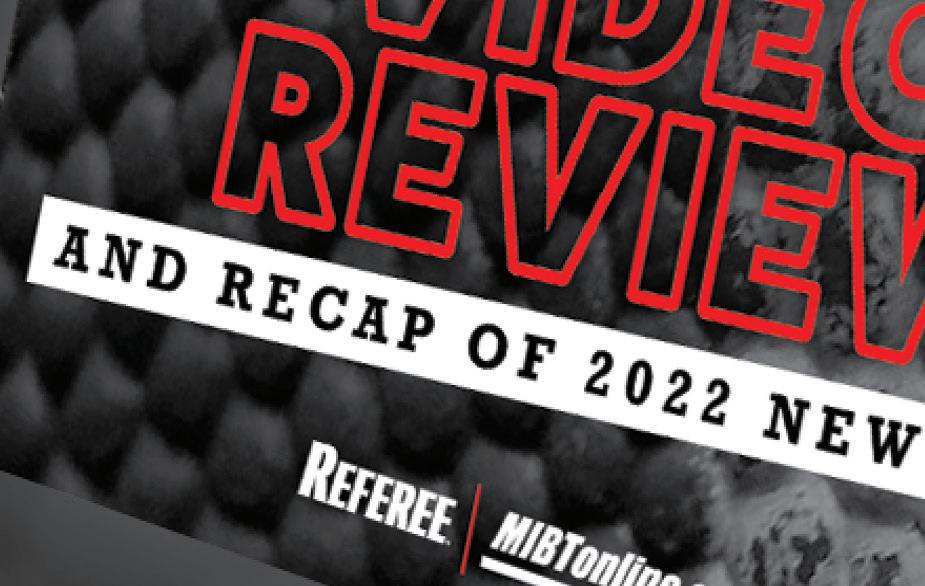
Brought to you by Tim Kiefer and MIBTonline.com, the latest edition of “High School Officiating Best Practices” focuses squarely on the 2023 high school rule changes, including all the significant changes and updates. Additionally, Tim takes you through all the 2023 Points of Emphasis and fully reviews last season’s critical rule changes. •Fouls Behind the Line of Scrimmage Explained •All new Enforcements & Exceptions •Player Out of Bounds Changes •Legal Grounding Clarifications •Intentional Pass Interference Removal •And More! Fouls All Player Legal Intentional And • • • • • • ANYWHERE! Enhanced HD Video delivered via USB Drive
2023 HIGH
ORDER YOURS TODAY! STORE. /FOOTBALL $2495 CLARIFIED & EXPLAINED WITH VIDEO PLAYS TAKE IT
AL L NEW
SCHOOL RULES
POSTSEASON ASSIGNMENTS
COLLEGE

•LSU defeated Iowa, 102-85, to win the NCAA Division I women’s basketball championship. Officials were Lisa Jones, Pualani Spurlock-Welsh and Michol Murray. Semifinal officials were Maj Forsberg, Gina Cross and Angelica Suffren (LSU 79, Virginia Tech
72)and Dee Kantner, Brenda Pantoja and Tiffany Bird (Iowa 77, South Carolina 73).
Other tournament assignments as provided by national coordinator Penny Davis: First round — Tennessee Tech 79, Monmouth 69: Cross, Toni Patillo, Ryan Durham St. John’s 66, Purdue 64: Bird, Natasha Camy, Timothy Daley Mississippi St. 70, Illinois
56: Kevin Pethtel, Tiara Cruse, Brian Woods Sacred Heart 57, Southern U. 56: Charles Gonzalez, Brian Garland, Tashianna Smith Louisville 83, Drake 81: Michael Price, Talisa Green, Royce Blevins Texas 79, East Carolina 40: S Brian Hall, Jules Gallien, Kristen Bell LSU 73, Hawaii 50: Pantoja, Metta Christensen, Ty Bills Michigan 71, UNLV 59: Roy Gulbeyan, Teresa Turner, Demoya Pugh South Dakota St. 62, USC 57: Kyle Bacon, Alecia Murray, Zac Brost Virginia Tech 58, Chattanooga
33: Eric Brewton, Meadow Overstreet, Nic Cappel. Indiana 77, Tennessee Tech
47: Cross, Marla Gearhart, Nick Marshall Miami (Fla.)
62, Oklahoma St. 61: Pethtel, Fatou Cissoko-Stephens, Rod Creech Arizona 75, West Virginia 62: Suffren, Tyler Trimble, Travis Jones Maryland 93, Holy Cross 61: Angela Enlund, Sha’Rae
FOR THE RECORD
AWARDS, ROSTERS, NOTABLES
Mitchell, Kenneth Kelly South Carolina 72, Norfolk St. 40: Spurlock-Welsh, Timothy Bryant, Molly Caldwell South Fla. 67, Marquette
65: Joseph Vaszily, Katie Lukanich, Timothy Greene North Carolina 61, St. John’s 59: Karen Preato, Jeffrey Smith, Teresa Stuck Ohio St. 80, James Madison 66: Daley, Ashley Gloss, Tommi Paris Colorado 82, Middle Tenn.
60: L Jones, Bill Larance, Brandon Enterline Duke 89, Iona 49: Carla Fountain, Frank Steratore, Beth Kuzmeski Georgia 66, Florida St. 54: Kantner, Kenneth Nash, Mark Berger Iowa 95, Southeastern La. 43: Jesse Dickerson, Kimberly Hobbs, Ifeyinwa Seales Toledo 80, Iowa St.
73: Michael McConnell, Darren Krzesnik, Nicole Leon Tennessee 95, Saint Louis
50: Cameron Inouye, Robert Scofield, Krystle Apellaniz Oklahoma 85, Portland 63: Julie Krommenhoek, Doug Knight, Cheryll Blue. UCLA
67, Sacramento St. 45: In’Fini Robinson, Scott Osborne, Britton Sherry Mississippi St. 81, Creighton 66: Cruse, Saif Esho, Ashlee Goode Notre Dame 82, Southern Utah 56: Edward Sidlasky, Woods, Lorena Ahumada Princeton 64, NC State 63: Melissa Barlow, Nykesha Thompson, Bruce Morris Utah 103, Gardner-Webb 77: Mark Resch, Ashley Ellis, Roy Jackson Ole Miss 71, Gonzaga 48: Gonzalez, Garland, Felecity Willis Stanford 92, Sacred Heart 49: Murray, John Capolino, D’Lynn Schertz Baylor 78, Alabama 74: Forsberg, Eric Koch, Marc Merritt UConn 95, Vermont
52: Camy, Tom Danaher, Sarah Williams Villanova
76, Cleveland St. 59: Maggie Tieman, Natosha Harris, Cara Seggie FGCU 74, Washington
St. 63: Bird, Benny Luna, Kevin Sparrock
Second round — Louisville
73, Texas 51: Price, Hall, Green
LSU 66, Michigan 42: Pantoja, Gulbeyan, Turner Virginia Tech 72, South Dakota St. 60: Brewton, Bacon, Overstreet Miami (Fla.) 70, Indiana 68: Cross, Pethtel, CissokoStephens Maryland 77, Arizona
64: Suffren, Enlund, Trimble South Carolina 76, South Florida
45: Spurlock-Welsh, Vaszily, Lukanich Ohio St. 71, North Carolina 69: Preato, Daley, Smith Colorado 61, Duke 53:
L Jones, Fountain, Larance Iowa 74, Georgia 66: Kantner, Dickerson, Nash Tennessee 94, Toledo 47: McConnell, Inouye, Scofield UCLA 82, Oklahoma 73: Krommenhoek, Robinson, Knight Notre Dame
53, Mississippi St. 48: Cruse, Sidlasky, Esho Utah 63, Princeton 56: Barlow, Resch, Thompson Ole Miss 54, Stanford 49: Murray, Gonzalez, Garland UConn 77, Baylor
58: Forsberg, Camy, Koch.
Villanova 76, FGCU 57: Bird, Tieman, Luna. Regional semifinal — Notre Dame 76, Maryland 59: Brewton, Dickerson, Turner South Carolina 59, UCLA 43: L Jones, Overstreet, Tieman LSU 66, Utah 63: Bird, Price, Green Miami (Fla.) 70, Villanova
65: Forsberg, Sidlasky, Thompson Ohio St. 73, UConn
61: McConnell, Cruse, Trimble Virginia Tech 73, Tennessee 64: Spurlock-Welsh, Gonzalez, Smith Iowa 87, Colorado
77: Barlow, Inouye, Enlund Louisville 72, Ole Miss 62: Vaszily, Preato, Nash Regional final — LSU 54, Miami (Fla.) 42: Kantner, Murray, Daley Virginia Tech 84, Ohio St. 74: Pantoja, Gulbeyan, Lukanich Iowa 97, Louisville 83: Pethtel, Hall, Robinson South Carolina 86, Maryland 75: Cross, Suffren, Krommenhoek
•UConn defeated San Diego St., 76-59, to win the NCAA Division I men’s basketball championship. Officials were Ron Groover, Keith Kimble and Terry Oglesby. Semifinal officials were Doug Sirmons, Jeffrey Anderson and Roger Ayers (UConn 72, Miami (Fla.) 59) and John Higgins, Kipp Kissinger and Bert Smith (San Diego St. 72, Florida Atlantic 71).
Other tournament
assignments as provided by national coordinator Chris
Rastatter: First round — Texas
A&M Corpus Christi 75, Southeast Missouri St. 71: Bert Smith, Bart Lenox, Alfred Smith. Pittsburgh 60, Mississippi
St. 59: Kissinger, Tom Nunez, Bharat Ramnanan Fairleigh
Dickinson 84, Texas Southern
61: Larry Scirotto, Bret Smith, Tim Smith. Arizona St. 98, Nevada 73: Doug Shows, Deldre Carr, Lucas Santos
Alabama 96, Texas A&M Corpus Christi 75: Verne Harris, Larry Spaulding, Richard Crawford Houston 63, Northern Kentucky
52: Oglesby, Brandon Cruz, Randy Heimerman Kansas 96, Howard 68: Tony Padilla, Byron Jarrett, Brian McNutt. Texas 81, Colgate 61: Joe Lindsay, Randy Richardson, Amy Bonner
UCLA 86, UNC Asheville 53: Higgins, Jeb Hartness, Antinio Petty. Princeton 59, Arizona
55: Earl Walton, Kevin Brill, Tom Morrissey. Duke 74, Oral Roberts 51: Michael Reed, Tony Chiazza, Steve McJunkins. Furman 68, Virginia 67: Michael Greenstein, Dwayne Gladden, Jerry Heater. Penn St. 76, Texas A&M 59: Courtney Green, Marques Pettigrew, Chance Moore. San Diego St. 63, Charleston 57: Kissinger, A J Desai, Todd Austin
Tennessee 58, Louisiana 55: Pat Adams, Jason Baker, Justin Porterfield. Missouri 76, Utah St. 65: Brian O’Connell, Nunez, Rob Rorke. Maryland 67, West Virginia 65: Groover, Darron George, Edwin Young
Arkansas 73, Illinois 63: Bert Smith, Brooks Wells, Sean Hull. Auburn 83, Iowa 75: Pat Driscoll, William Covington, Lenox. Northwestern 75, Boise St. 67: Michael Irving, Nathan Farrell, John Floyd. Fairleigh Dickinson 63, Purdue 58: Brian Dorsey, Clarence Armstrong, Chris Beaver. Marquette 78, Vermont 61: Don Daily, Greg
Evans, Jemel Spearman
Gonzaga 82, Grand Canyon 70: Paul Szelc, Bill Ek, Michael Palau. UConn 87, Iona 63: J
Anderson, Olandis Poole, Owen Shortt. Baylor 74, UC Santa Barbara 56: Sirmons, Carr, Wil Howard. Xavier 72, Kennesaw St. 67: Jeffery Clark, Rob Riley, Chuck Jones
Kansas St. 77, Montana St. 65: Lamar Simpson, Gregory Nixon, Chad Barlow. Miami
82 | REFEREE July 2023
Designate NASO as a beneficiary of your retirement plan or life insurance policy. LEARN
OR CALL 800-733-6100
MORE AT NASO.ORG/LEGACY
(Fla.) 63, Drake 56: Shows, Anthony Jordan, Tyler Kumpf
St. Mary’s 63, VCU 51: D J Carstensen, Brent Hampton, Nate Harris. Indiana 71, Kent
St. 60: Kimble, Kelly Pfeifer, Mark Schnur. TCU 72, Arizona
St. 70: Ray Natili, Vladimir Voyard-Tadal, D G Nelson
Florida Atlantic 66, Memphis
65: Lee Cassell, Bret Smith, Evon Burroughs. Michigan
St. 72, USC 62: Ayers, Steven Anderson, Scott Brown
Pittsburgh 59, Iowa St. 41: Gerry Pollard, Michael Nance, Rob Kueneman. Creighton 72, N.C. St. 63: Scirotto, Eric Curry, Tim Clougherty. Kentucky 61, Providence 53: John Gaffney, Patrick Evans, K B Burdett
Second round — Alabama
73, Maryland 51: Oglesby, Driscoll, Covington. Houston
81, Auburn 64: Groover, Harris, George. Miami (Fla.) 85, Indiana
69: J Anderson, Carstensen, Hampton. UConn 70, St. Mary’s 55: Shows, Kimble, Pfeiffer Florida Atlantic 78, Fairleigh Dickinson 70: Ayers, Daily, S Anderson. Michigan
St. 69, Marquette 60: Dorsey, Cassell, Armstrong. Creighton
85, Baylor 76: Szelc, Natili, Curry. Gonzaga 84, TCU 81:
ROSTERS
Sirmons, Scirotto, VoyardTadal. Arkansas 72, Kansas
71: Lindsay, Green, Pettigrew Texas 77, Penn St. 66: Padilla, Bert Smith, Jarrett. Kansas St.
75, Kentucky 69: Clark, Pollard, Burdett. Xavier 84, Pittsburgh
73: Gaffney, Simpson, Nixon Princeton 78, Missouri 63: Higgins, Irving, Hartness
UCLA 68, Northwestern 63: O’Connell, Walton, Brill Tennessee 65, Duke 52: Kissinger, Greenstein, Desai San Diego St. 75, Furman 52: Adams, Reed, Chazza
Regional semifinals — UConn 88, Arkansas 65: Oglesby, Natili, Simpson. Gonzaga 79, UCLA 76: Kissinger, Bert Smith, Pollard. Miami (Fla.) 89, Houston 75: Higgins, O’Connell, S. Anderson Texas 83, Xavier 71: Ayers, Green, Chazza. Florida Atlantic 62, Tennessee 55: Dorsey, Scirotto, Desai. Kansas St. 98, Michigan St. 93: J. Anderson, Szelc, Hartness. San Diego St. 71, Alabama 64: Padilla, Daily, Pettigrew. Creighton 86, Princeton 75: Driscoll, Carstensen, Jarrett. Regional final — Miami (Fla.) 88, Texas 81: Groover, Adams, Hampton. San Diego St. 57,
Creighton 56: Lindsay, Cassell, Irving. UConn 82, Gonzaga 54: Kimble, Gaffney, Reed. Florida Atlantic 79, Kansas St. 76: Sirmons, Walton, Shows
HIGH SCHOOL
•Officials working winter state tournaments for the Minnesota State High School League: Boys’ hockey — Justin Anderson, West Fargo; Jason Bergeron, Maple Grove; Randy Best, Elko New Market; Nick Biondich, Hermantown; Joe Capocasa, White Bear Lake; Kyle Domin, Bayport; Michael Elam, Lake Elmo; Jake Flanagin, Maple Grove; Mike Forys, Cottage Grove; Mark Germain, Apple Valley; Ricco Guzman, Sartell; Glenn Hagberg, Brainerd; Tyler Harrison, North St. Paul; Brennan Hockman, Bemidji; Adam Knutson, Shoreview; Daniel Kovarik, Mendota Heights; Tony Lancette, Shakopee; Tyler Landman, Roseau; Andrew Liebaert, Superior; Timothy Likes, Hastings; Brandon Linquist, Waite Park; Troy Nichols, Mountain Iron; Ryan Nolander, Rochester; Dan Olson, Cottage Grove; John Priester, Stillwater; Morgan Shepherd, East Gull
Lake; Ryan Swafford, Mankato; Eric Thom, Rosemount; Nathan Voll, Roseau; Sam Warzecha, Otsego; Ben Yanez, St Paul; Bay Zuehlke, Bovey. Adapted floor hockey — Christopher Flowers, St. Paul; Deb Hiestand, Maple Grove; Jim Hirsch, Bloomington; Chris Jessen, Minneapolis; Claudia Learned, Minneapolis; Jim Novak, St. Paul; Craig Pearson, Victoria; Paul Pranghofer, Golden Valley; Tony Ruiz, Mendota Heights; Michelle Schneider, Brooklyn Park; Tom Stephan, Brooklyn Park; Jim Sunquist, Dennison; Ryan Swafford, Mankato; Jacki Wincek, Minneapolis; George Winn, Maple Grove.
OBITUARIES
• Dick Peterson, Burlington, Wis., died April 21. He was 80.He officiated high school baseball for more than 50 years and officiated high school basketball.
Do you have any rosters, assignments or awards that warrant mention?
Send info to us at ForTheRecord@referee.com
REFEREE July 2023 | 83
MLB Crews The 2023 MLB umpiring crews. The first name listed on each crew is the crew chief. 24 Jerry Layne 19 Vic Carapazza 78 Adam Hamari 48 Nick Mahrley 45 Jeff Nelson 54 CB Bucknor 96 Chris Segal 97 Ben May 26 Bill Miller 8 Rob Drake 62 Chad Whitson 40 Roberto Ortiz 27 Larry Vanover 68 Chris Guccione 86 David Rackley 32 Edwin Moscoso 50 Paul Emmel 4 Chad Fairchild 59 Nic Lentz 35 Jeremy Rehak 14 Mark Wegner 1 Bruce Dreckman 85 Stu Scheurwater 44 Malachi Moore 72 Alfonso Márquez 88 Doug Eddings 16 Lance Barrett 18 Ramon De Jesus 58 Dan Iassogna 87 Scott Barry 47 Gabe Morales 38 Adam Beck 6 Mark Carlson 71 Jordan Baker 73 Tripp Gibson 55 Brennan Miller 63 Laz Diaz 49 Andy Fletcher 83 Mike Estabrook 12 Erich Bacchus 46 Ron Kulpa 89 Cory Blaser 37 Carlos Torres 52 Jansen Visconti 51 Marvin Hudson 21 Hunter Wendelstedt 74 John Tumpane 36 Ryan Blakney 23 Lance Barksdale 15 Ed Hickox 93 Will Little 67 Ryan Additon 92 James Hoye 5 Angel Hernandez 17 D.J. Reyburn 84 John Libka 80 Adrian Johnson 79 Manny Gonzalez 81 Quinn Wolcott 25 Junior Valentine 2 Dan Bellino 10 Phil Cuzzi 90 Mark Ripperger 43 Shane Livensparger 13 Todd Tichenor 91 Brian Knight 11 Tony Randazzo 66 Alex Tosi 64 Alan Porter 28 Jim Wolf 76 Mike Muchlinski 29 Sean Barber 98 Chris Conroy 7 Brian O’Nora 31 Pat Hoberg 33 Nestor Ceja Triple-A Call-Up Umpires 70 John Bacon 100 David Arrieta 104 Paul Clemons 105 Alex MacKay 107 Dan Merzel 110 Jose Navas 111 Charlie Ramos 112 Jeremy Riggs 113 Randy Rosenberg 114 Nate Tomlinson 116 Clint Vondrak 117 Lew Williams 118 Ryan Wills 119 Brock Ballou
Disciplined Response
By Donald C. Collins
Officials who are facing disciplinary action from their association must resist the urge to do a number of things most people want to do. They must not immediately lash out or fight back. They must not immediately attempt to tell someone their defense. They must resist the urge to explain themselves and seek some form of absolution.
The official should begin by being silent. This is hard for some to do. It may be difficult to appreciate why silence is important since the charged official is not under arrest and is not being silent while invoking the right to counsel. In this case, silence is a means to an end.
An official begins by being silent until knowing the basics, including what one is actually being charged with. Then finding out what acts are at issue, and what part of the association’s rules, contracts or bylaws the official is accused of violating. Next, the official
and has looked at the association’s procedural rules, the time for silence is over, and the official will need to begin preparing for the hearing.
The official will need to know the evidence against him or her, and he or she may need to ask for it. Then, the official will want to know the witnesses against him or her, and whether he or she will be able to speak to and address those witnesses at the hearing. The official will also wish to line up his or her own witnesses, and will need to know whether he or she can present written statements to the association prior to the hearing or whether the association relies solely on the hearing as the official’s opportunity to present information.
The official should also note if he or she is defending against a rule articulated in the bylaws. That’s a bit different than trying to beat the opposing witnesses. One can beat the opposing witnesses and still lose. For example, showing a witness erred in saying one used a profanity in an oncourt dispute with a fellow official still doesn’t alter the breach of standards in having an on-court dispute with one’s partner in the first place.
Right Reports
Sports officials play a critical role in ensuring games are conducted fairly and rules and regulations are followed. Actions by officials can trigger a series of administrative and legal ramifications, which is why administrators rely on the information provided in game reports.
After games end, officials remain key players as they provide crucial information to league administrators. The most common incidents that require reporting include ejections and fights.
To provide accurate information, officials need to stick to the facts and avoid providing opinions or characterizations. For instance, if a player utters a profanity, officials must quote it in the report. Additionally, officials need to provide administrative details, such as whether they issued a technical foul or ejected players for fighting, and record-keeping information, such as whether the game was suspended or forfeited.
Ultimately, officials need to ensure they provide detailed game reports to help league administrators make informed decisions and maintain the integrity of the game.
Five Bylaws Basics
Here are five basic things that should be included in association bylaws:
must determine whether he or she is merely facing charges or whether some penalty has already been imposed, and he or she is in the position of rebutting or mitigating the damage already done.
Next, the official should look at the association’s procedural rules. Usually, an association’s bylaws will tell you things such as how charges are filed, who can file them, the time frame for bringing them, the notice required, etc. The official should review the bylaws to make sure the charges can be brought.
For example, some associations allow a member to bring a grievance against another member. However, the bylaws may place a time frame for such a grievance. If outside the specified time frame, the member facing discipline has a procedural defense. Sometimes, a procedural defense gives one a win; other times it simply leads to a refiling of the charges.
Once an official knows the basics,
Also, the official must know the hearing rules. One must know timing rules and presentation formats in order to make the best case.
Next, the official should make sure to not only defend himself or herself against the charges, but to also remind the association of mitigating factors that should lead to a reduction of the penalty should the official lose. The official does not need to belabor these points, but certainly can briefly note things such as the harm being limited in scope, having a perfect track record, and even facts that make the conduct at issue understandable if not excusable.
Finally, remember losing at the hearing is not always the end. An official should read up on the appeal procedures. Sometimes, it’s worth getting a second bite at the apple.
Donald C. Collins is a longtime basketball official and lawyer. This article is for informational purposes and is not legal advice.
1.Define your purpose. What’s the organization’s mission, such as educating members or assigning games?
2.Describe the members. This includes any qualifications and addressing matters like who can vote.
3.Make it clear what is expected of members. Are there meetings to attend to stay in good standing? Testing requirements? Dues to pay? Etc.
4.Help when trouble arises. Issues can arise. Bylaws should address situations such as disciplining or removing members.
5.Outline board member duties. Bylaws should clearly describe the governing body, how and when those positions are elected, how individuals may be removed, etc. The authority given to the board, such as for managing the finances and entering contracts, should be spelled out.
SOURCE: ATTORNEY PATRICK ROSENOW COLUMN IN NASO ADVISOR NEWSLETTER
ISSUES AFFECTING OFFICIALS Go to www.naso.org and click on member benefits for more on MICP.
BY 84 | REFEREE July 2023
The official should begin by being silent.
LAW
PRESENTED
CLASSIFIEDS
CAMPS/CLINICS/ SCHOOLS
ATTENTION ASSOCIATION LEADERS!
Are you holding a camp or a clinic? Do you know of a camp or a clinic coming up? Referee can help get the word out! Call our sales department at 262-6328855 for more information.
LEADERSHIP RESOURCES
Association Advantage Membership to Association Advantage provides officials, associations and their leaders the tools to conduct wellrun meetings, education resources for officiating training and access to years of association management articles. Member associations
also receive 12 issues of Referee magazine, monthly Advisor newsletters, Click e-newsletters, massive discounts on training materials and optional insurance coverage exclusive to membership. For additional membership information, contact Ken Koester at 262-632-5448 or visit the Association Advantage website at nasoadvantage.com.
EQUIPMENT/APPAREL
Purchase Officials Supplies — Everything for Life Inside the Lines. Call 800-767-2233 or visit our website purchaseofficials. com for the best products and prices in the market.
Ump-Attire.com — The #1 website for officials’ sporting goods. Now serving
QUIZ ANSWERS
FOOTBALL

1 — NFHS – a (9-7-2); NCAA –b (9-4-1c)
2 — Both – b, c (NFHS 8-3-5; NCAA 8-3-3b, 9-1-16)
3 — NFHS – a (7-5-8, 7-5-9, 7-5-10); NCAA – b (7-3-8c-4)
4 — NFHS – b (7-5-1, 7-52b Pen., 7.5.1); NCAA – a (7-3-2a)
5 — Both – c (NFHS 2-6-2a; NCAA 9-2-1b-1)
BASKETBALL
1 — All – a (NFHS 10-4-3, 10-4-4; NCAAM 10-4.1.e, 10-4.1.f, 10-4.1.g; NCAAW 10-12.3.c, 10-12.3.d, 10-12.3.e)
2 — All – d (NFHS 9-2-5; NCAAM/W 9-4.1.f)
3 — All – d (NFHS 9-2-7; NCAAM/W 9-4.1.g)
4 — All – c (NFHS 2-10-1c, 2-10-4, 2-10-5; NCAAM/W
2-12.1.c, 2-12.4)
MISSION
VOLLEYBALL
1 — All – e (NFHS 9-3-3g; NCAA 16.1.2, 16.2.1; USAV
8.2)
2 — All – b (NFHS 9-4-3; NCAA 14.3.2.1; USAV 9.1.2.2)
3 — NFHS – d (9-5-7); NCAA, USAV – a (NCAA 15.2.4.2; USAV 11.2.2)
SOFTBALL
1 — All – a (NFHS 8-86; NCAA 12.17.2.1.1, 12.17.2.1.5.5; USA Softball
8-8F; USSSA Feb. 2018 Interp.)

2 — All – e (NFHS 8-6-1; NCAA 12.10.5; USA Softball
8-7A; USSSA 8-18A)
3 — All – c (NFHS 2-110; NCAA 7.1.1.2.5b; USA Softball R/S 1L; USSSA 8-6A, 8-6B, 9-1)
4 — NFHS, USA Softball, USSSA – a (NFHS 7-4-8; USA
Softball 7-6F; USSSA 7-14G); NCAA – c (11.2.5 Eff.)

free returns to go along with more brands, product reviews, same-day shipping and world-class service.

Smitty Outlet Store
Visit the NEW Smitty Outlet Store featuring discontinued, factory seconds and individual slightly defective items at great prices. Go to smittyoutletstore.com to shop now!
TRAINING RESOURCES
Referee Training Center
— The largest library of officiating training materials in the world. Rules study, mechanics updates and materials on important topics can all be found in one location 24 hours a day, seven days a week, with sample chapters and video samples. Discover it all at store.referee.com.


FLASHBACK JULY
40 YEARS AGO … 1983
•NHL referee Wally Harris calls it a career after 16 seasons in the league. At age 47, Harris became the oldest official ever to work in the NHL. He cited travel demands as a leading cause for his decision to hang up his skates following the 1983 Stanley Cup playoffs.
SOCCER
1 — All – c (NFHS 11-1-1; NCAA 11.1; IFAB 11.1)
2 — All – c (NFHS 12-8-1b; NCAA 12.4.3.5; IFAB 12.3)
3 — All – b (NFHS 12-7-4; NCAA 12.2.12; IFAB 12.2)
4 — All – a (NFHS 13.3; NCAA 13.2.2; IFAB 13.2)
5 — All – c (NFHS 13-1-1; NCAA 13.1.3; IFAB 13.1)
BASEBALL
1 — All – a (NFHS 3-2-2, 8-4-2s; NCAA 3-3e, 8-5f; pro 6.01a8)
2 — All – b (NFHS 8-2-6l; NCAA 2-52; pro MLBUM 40 Ex. 7)
3 — All – d (NFHS 7-1-2 Pen.
3; NCAA 7-11a2; pro 6.03b3)
Referee is a magazine written from an officiating perspective, blending editorial credibility and business viability. It educates, challenges and inspires officials at the youth, recreational, high school, collegiate and professional levels in all sports, with an emphasis on baseball, basketball, football, soccer, softball and volleyball. Referee is the journal of record for officiating and takes informed positions on selected issues. The magazine provides a forum for its readers, facilitates the flow of information, raises public consciousness about officials’ roles and serves as a catalyst for improved officiating worldwide.

… 1993
30 YEARS AGO
•Former NFL referee Ben Dreith settles a lawsuit with the league. Dreith claimed the NFL fired him following the 1990 season because of his age. He would go on to receive $165,000 plus legal fees of $100,000 and other costs for settling the claim. Dreith officiated in the AFL from 1960-69 and in the NFL from 1970-90.

20 YEARS AGO …
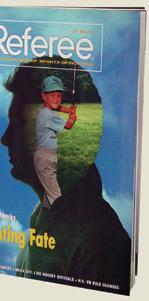
2003
•NBA referee Bob Delaney is selected as the 16th recipient of officiating’s highest honor. The NASO Gold Whistle Award was established in 1988 and is awarded annually. It recognizes those with a “service above self” attitude, high integrity and consistent record of presenting officiating in a positive light. Delaney is a retired New Jersey state trooper and spent 25 years in the NBA.
10 YEARS AGO …
2013
•Soccer referee Ricardo Portillo is killed after an attack by a 17-year-old player. Portillo spent one week in a coma before his death following the incident during a recreational soccer match in Utah. The player was charged with homicide by assault in juvenile court. Portillo’s death was the first known death of a referee as a result of an assault during an organized game in the United States.
REFEREE July 2023 | 85
MICHAEL CLARK
Who’s Crying at Your Funeral?
The title of this article is taken from Patrick Morley’s 1997 book, The Man in the Mirror. The book was part of our men’s Sunday school class, and this one question was the impetus that helped shape my priorities as a husband and father.
If we take our officiating avocation seriously, and if we’re prepared to be honest, we have goals. For most, it’s getting that first varsity assignment. After which we aim higher — playoff assignments, finals, Division III and eventually Division I.
We must always have some type of goal. The challenge is balancing those goals with our family time.
Don’t have a family. You are never there.”
When I started officiating in 2008, I had a long-term goal to make it to the NCAA. I was a member of a strong association that had many D-I officials. The teachers and the training were extremely helpful. They made it clear attending camps and reviewing game film were paramount for those seeking to “climb the ladder.”
That takes time. Lots of time.
When we say yes to somebody, we’re also saying no to somebody else, and that somebody is usually our family. My hat goes off to those who’ve been able to balance officiating life with family life. They represent an exceedingly small group. It has been my observation over 15 years of games, meetings and camps, the success stories pale in comparison to the endless list of officials who are divorced or are going through one.
This breaks my heart. Recently, I read an article about an official who justified balancing officiating and family by skipping his kids’ games, only to go officiate other kids and then have his kids sit down with him afterward and go through in story form the game he missed.
As Morley states in his book, “No amount of success at work can make up for failure at home.”
their deathbed and wishes they had spent more time at the office.”
In 2015, I was “climbing the ladder.” I was finishing camp at a major university with several D-I clinicians in attendance. During the final minutes of my last game, I looked over at my clinician — a man who had made it to D-I but shared he had just gotten divorced. I looked at him and thought about my goal and dream to make it to that level. I then looked over my shoulder, and there in the second row sat my wife and four boys waiting to take me to Culver’s.
I felt like a millionaire.
Right there, I resigned myself that I most likely would not have a career in the NCAA. The cost was too high, and I wasn’t willing to pay it. I reassessed my goals and shifted my focus to being the best high school official possible.
Be honest with yourself. Are you going to make it to the collegiate level? Examine the other officials there and see what shape they are in and their age.
If the answer is no, there’s nothing wrong with the men and women in their late 40s and early 50s that desire to be the best high school referees they can be.
During my 15-year officiating career, I’ve read many articles related to that specific dilemma, and most leave me feeling confused or frustrated.
I recently watched the ESPN 30 for 30 short documentary “Queen Vee.” It chronicles the journey of Violet Palmer, the first woman to officiate an NBA game. Throughout the show, retired NBA official Joey Crawford is interviewed and shares his thoughts about Palmer’s success. Toward the end, there’s a clarion moment when Crawford boldly says, “My advice to anybody thinking about becoming an NBA official:
One attention-getting line my wife uses with me to remind me when I am off balance is, “You’re bringing home leftovers.” She uses the analogy of a successful award-winning chef who creates amazing dishes for customers all day long, only to arrive home exhausted and serving the family leftovers.
This is how our spouse and children feel when we go straight from our primary employer to our game and return home late in the evening. Our children do not care about our titles or games. They spell love T-I-M-E.
If the Lord has blessed you with children, you get these little treasures for 18 years, and then they’re gone. To use the famous quote first penned by Harold Kushner, “Nobody ever sits on
If the answer seems to be pointing to yes, can I encourage you to enlist your spouse to help with the scheduling? The two of you together can work out a schedule that ensures success for you and your family. Avoid secrets and thinking you can do it alone.
When you’re faced with a choice between climbing the ladder or family, think about your funeral. It is a beautiful, sunny July day. Who is there? But more importantly, who is crying? Make sure you’re spending the majority of your time with those people.

Michael Clark, Charlotte, Mich., is a high school basketball official and veteran of the United States Air Force.
Do you have a personal officiating story to tell?
Send your story or queries to lastcall@referee.com
86 | REFEREE July 2023 SHUTTERSTOCK LAST CALL
A PERSONAL STORY BY
When we say yes to somebody, we’re also saying no to somebody else, and that somebody is usually our family.
Smitty Apparel is the #1 uniform worn on college football fields. The short sleeve shirts are available in standard mesh, or the popular Body Flex materials. The newest item to the line-up is the 126 single layer water resistant shirt. It featurres a stand-up collar and hook & loop sleeve closures.



Our top selling pants are the premium 4-Way Stretch. The 4-Way Stretch material breathes for comfort and are designed to look good game after game.

800-767-2233 | www.purchaseofficials.com Join our loyalty rewards program and start saving today!
EVERYTHING FOR LIFE INSIDE THE LINES. EVERYTHING FOR LIFE INSIDE THE LINES. The Purchase Officials Website is #1 online. •Mobile Friendly • Advanced Tracking •Exclusive Ref Points Loyalty Rewards •Complete Order History •Free Returns Visit today and buy with confidence.
Smitty College Uniforms













































































































































































































































































































































































































 BY PETER SACCO
BY PETER SACCO



































































































































 By Scott Tittrington
By Scott Tittrington


















































































































